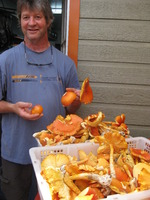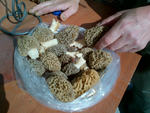Entries in journal (58)
Duck, duck.. And Recipes
I just love my duck
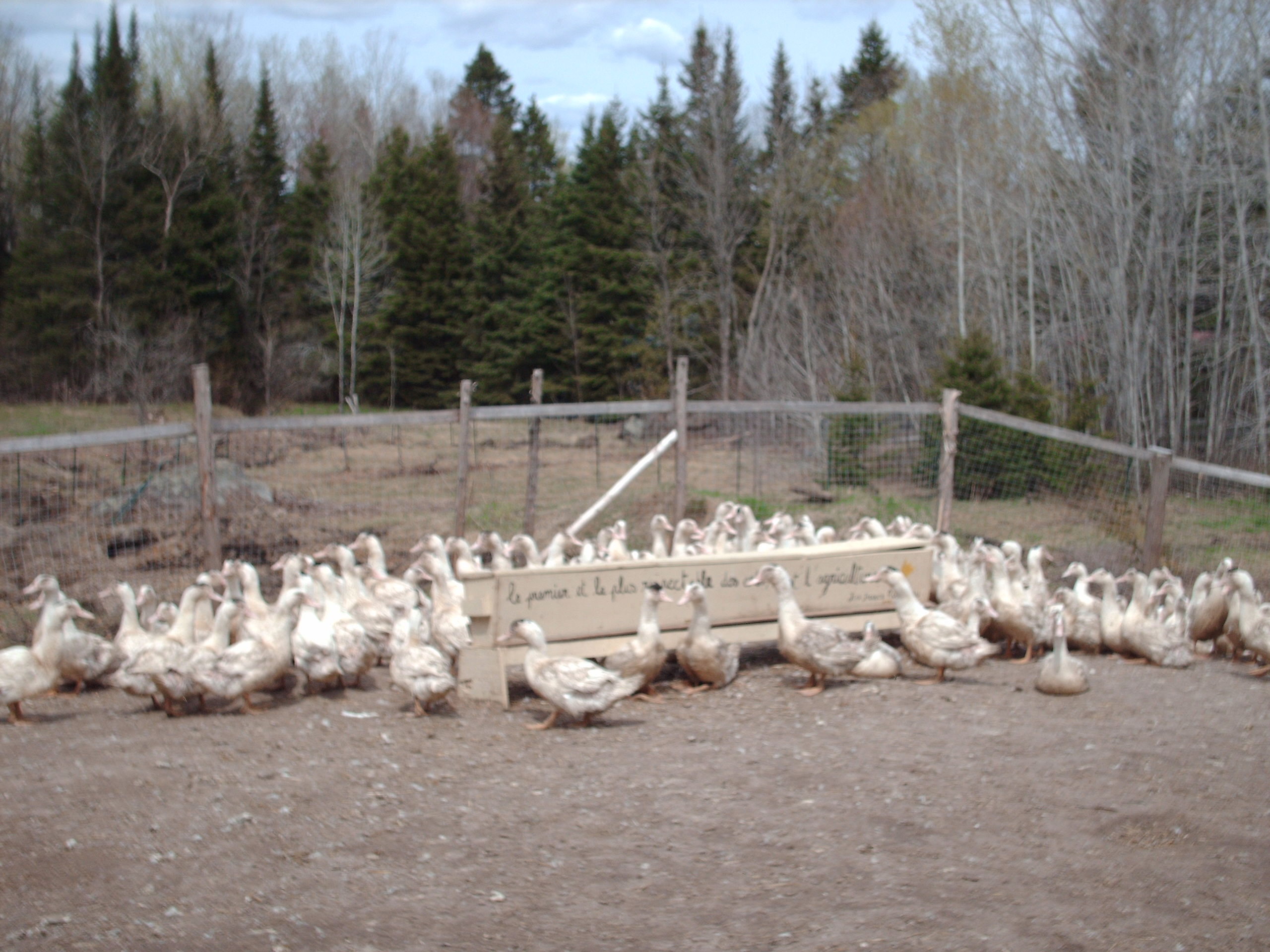 Moulard ducks
Moulard ducks
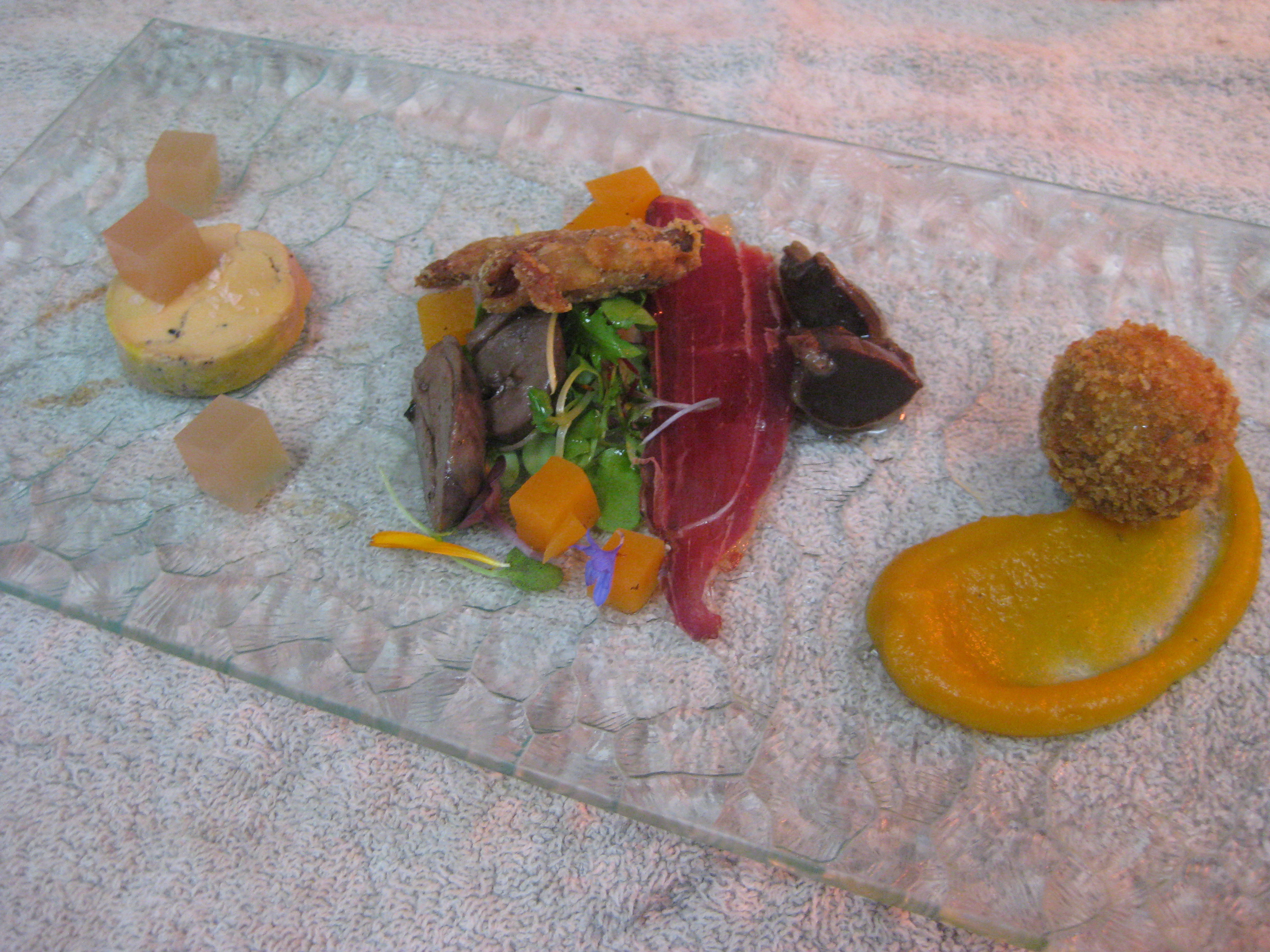
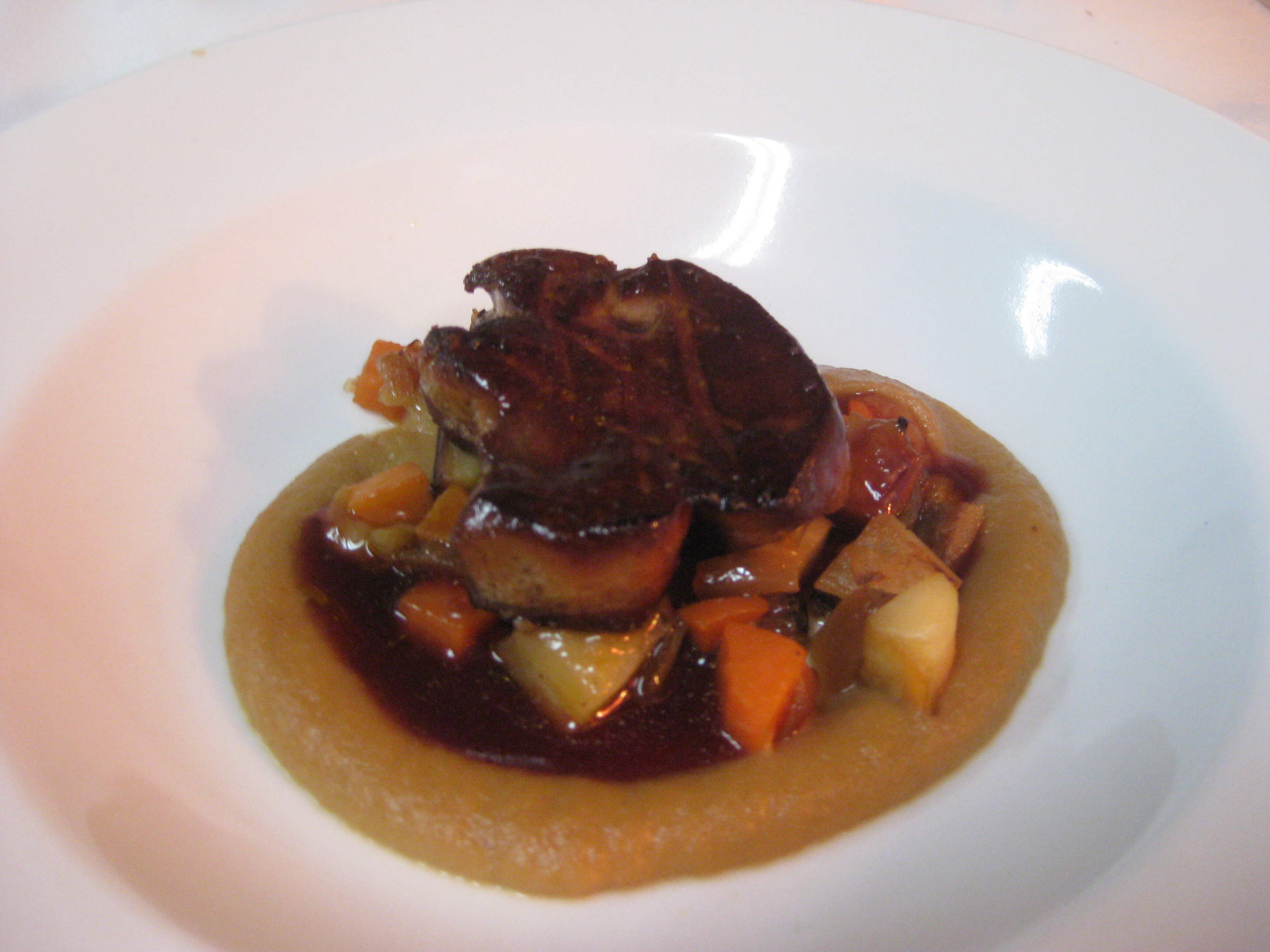 Pan-seared foie gras with elderberry/flower sauce, topinambour soubiseDuck is a winter tradition of ours, and it’s that time again. No matter that I inhaled my share of duck fumes, cooking up an insane amount of duck during the holiday season, I have a few more weeks yet of bathing in duck fat with our duck themed dinners running at the table champêtre.. Duck menu at Les Jardins Sauvages
Pan-seared foie gras with elderberry/flower sauce, topinambour soubiseDuck is a winter tradition of ours, and it’s that time again. No matter that I inhaled my share of duck fumes, cooking up an insane amount of duck during the holiday season, I have a few more weeks yet of bathing in duck fat with our duck themed dinners running at the table champêtre.. Duck menu at Les Jardins Sauvages
But really, I don’t mind; duck is hard to tire of. It is hands down the best meat, so flavourful and versatile in its many forms, not to mention local, healthy and relatively easy to cook. Susan Semenak makes a case for duck (with my help) in this Montreal Gazette article..
Every year, I change up the seven course menu, playing with four breeds and all their parts, the eggs, the skin, broth etc.. And the marvellous fat of course.. Duck fat is my all-purpose cooking fat in winter, rendered from the carcasses and skin. I like to smoke it too, to have a block ready on hand for introducing that ‘bacon’ taste when you don't want the pigginess.
For sure, there are standards that come back every year or two but always treated differently. For instance duck confit has to be present, but it might be as rillettes, in a salad, in cassoulet or choucroute, say.. Charcuterie (duck proscuito, smoked duck, jerky, sausage) as well as Foie gras, hot and cold are always featured, but with various seasonings and accompaniments.
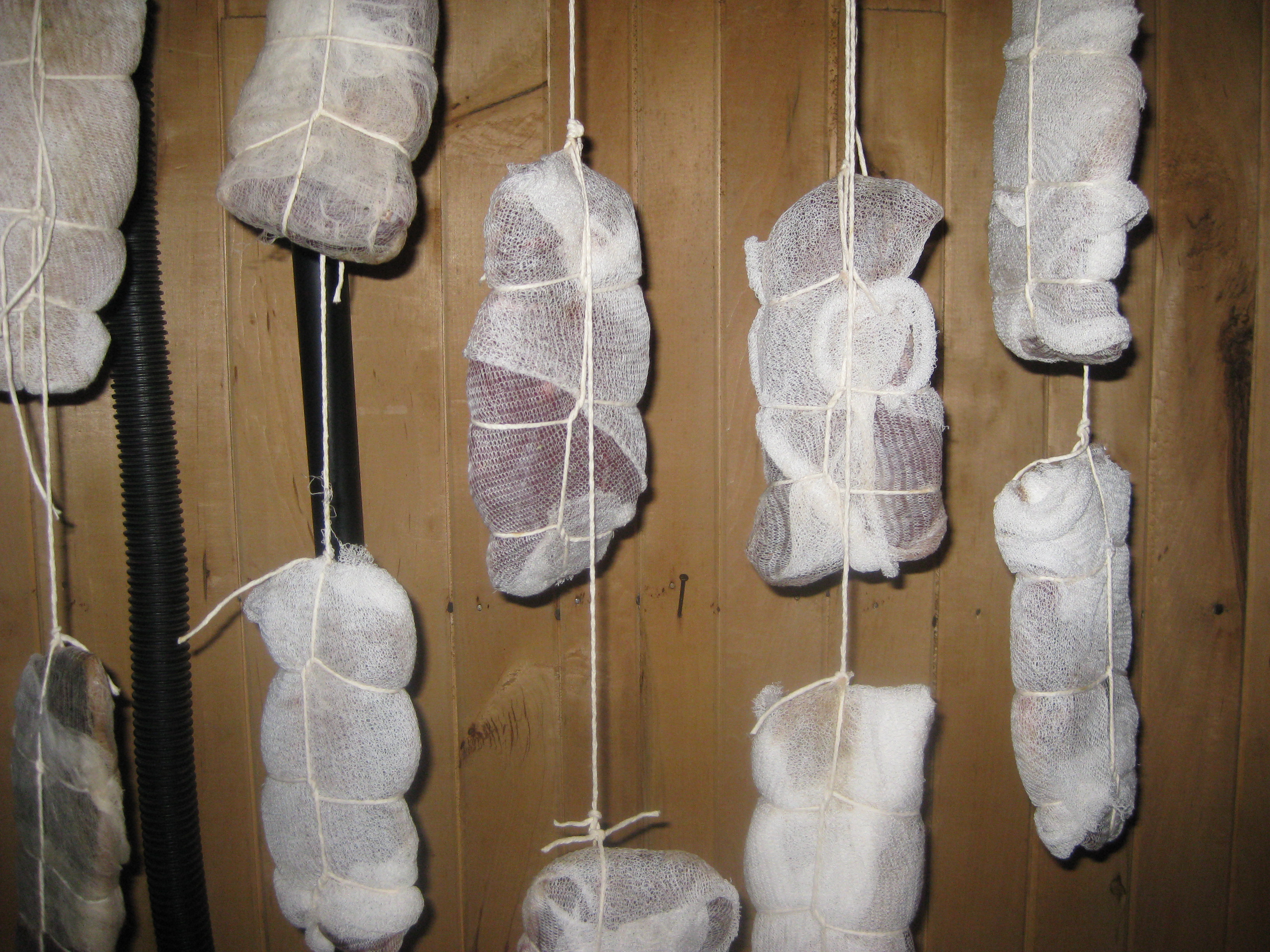 duck proscuito
duck proscuito
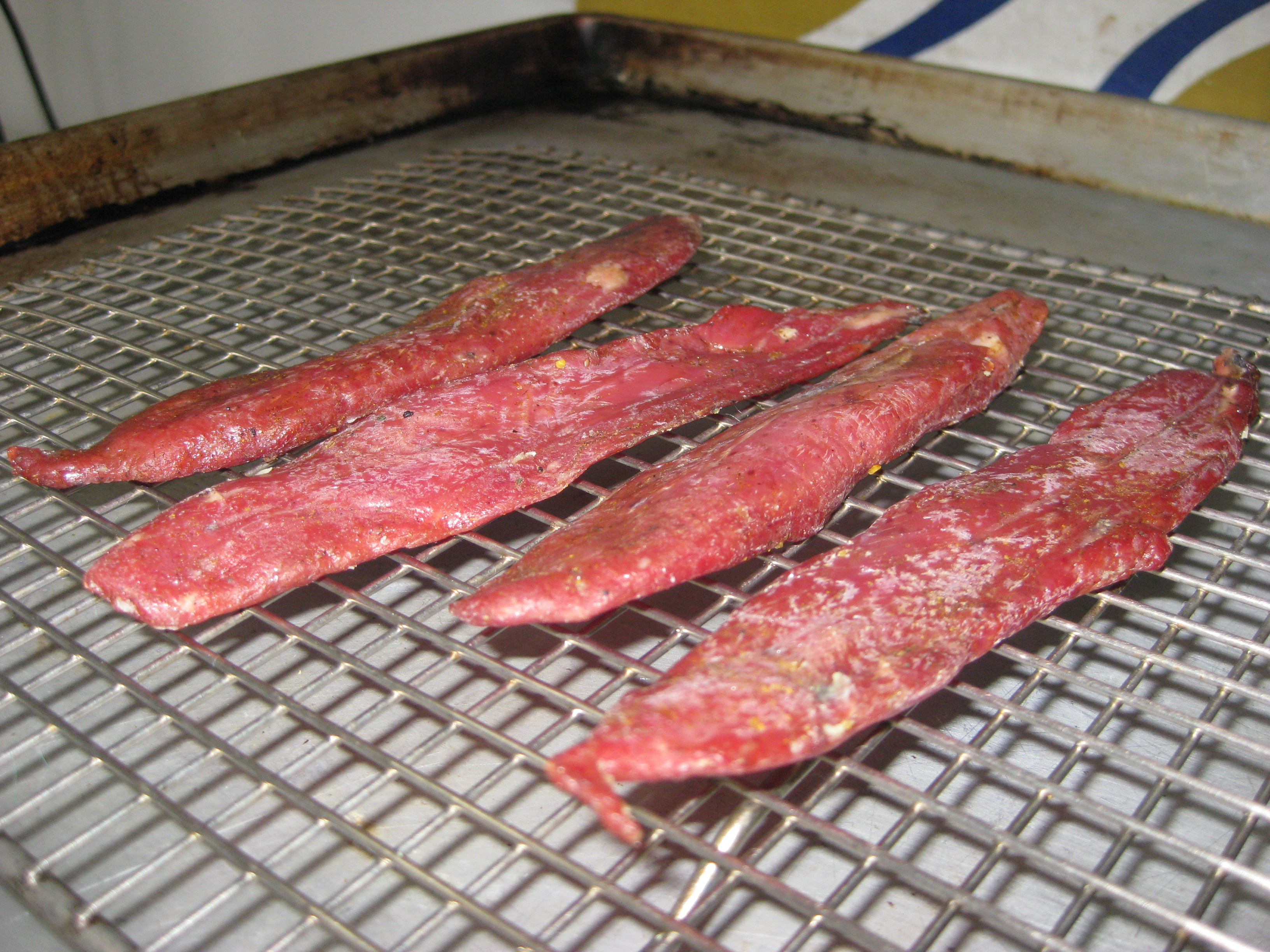 duck jerky
duck jerky
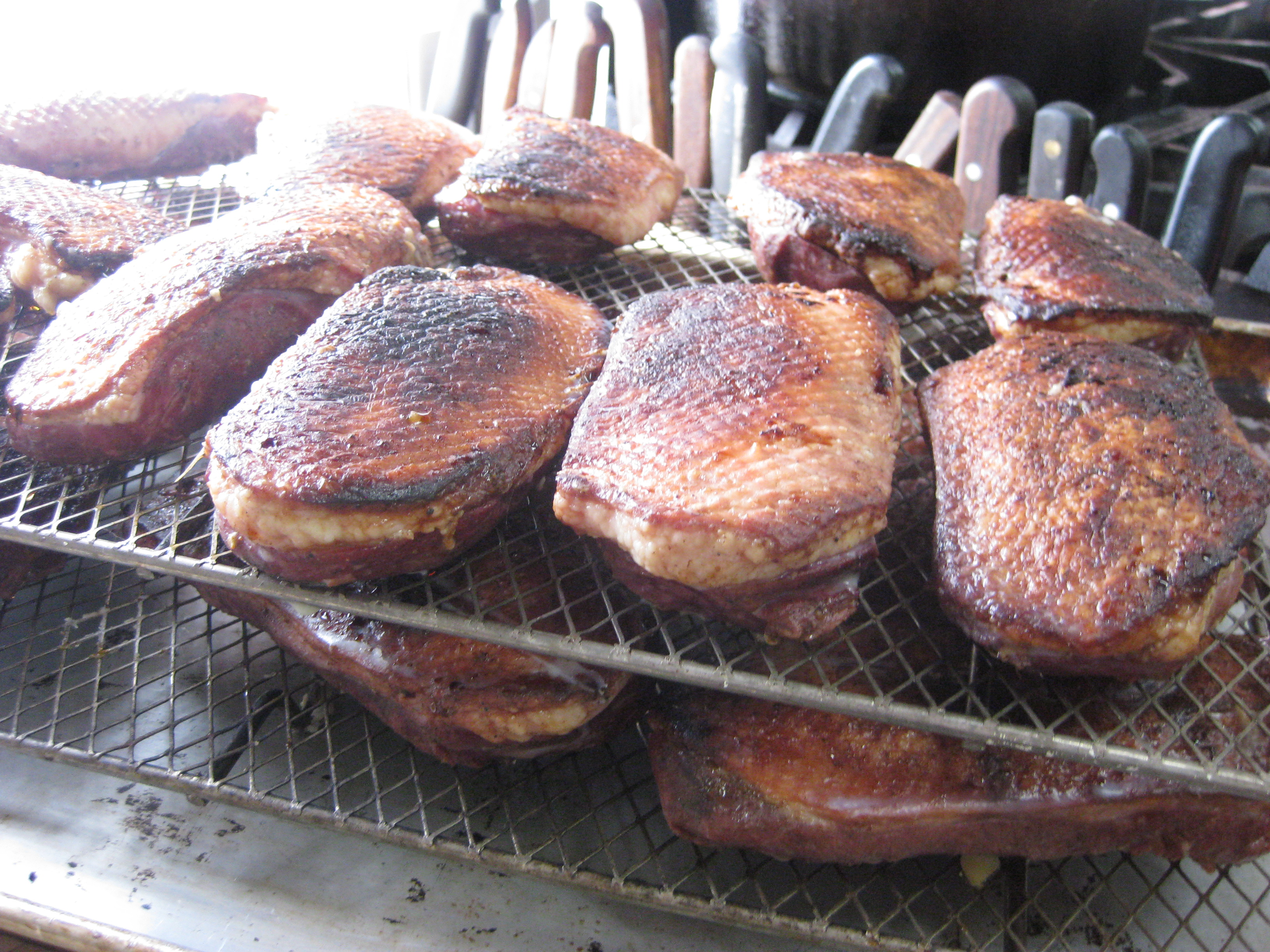 smoked duck my way, cooked not raw
smoked duck my way, cooked not raw
Soup wise, I can’t help but feel the need to go with a consommé, which is pure essence of duck. Duck broth is my base of choice (instead of chicken) year round and makes a great creamy soup or vegetable purée type as well, but I just love consommé; the extra steps are worth it. I clarify the duck stock with more duck (ground) and duck egg whites(keeping the yolks for the garnish or dessert, adding aromates of choice to the clarification raft. This time around it will be surprise, surprise – wild mushrooms!
 duck consommé with duck egg and sea spinach, sumac
duck consommé with duck egg and sea spinach, sumac
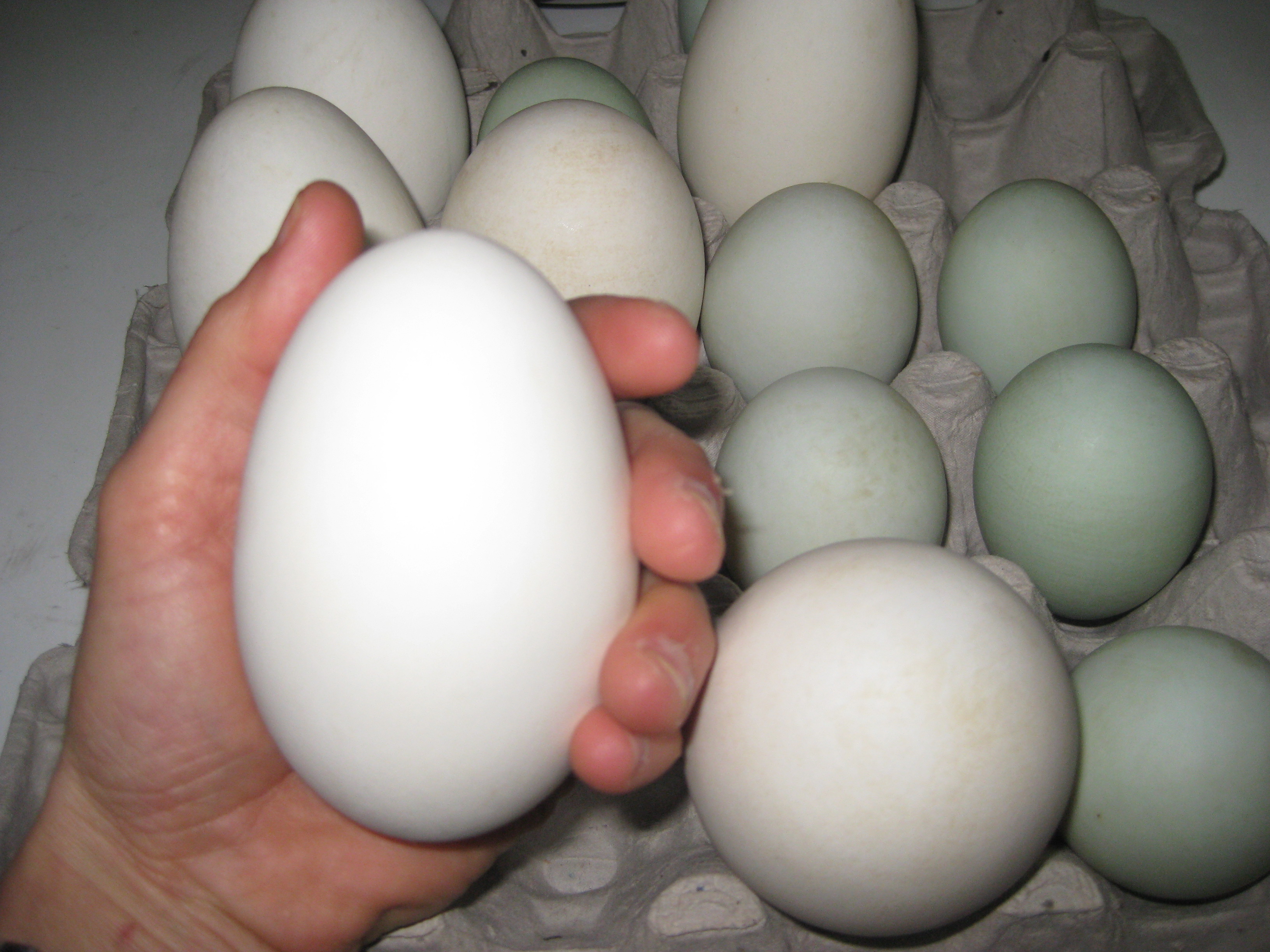 duck eggs
duck eggs
I used to put a whole duck egg on the menu as a second or third entrée - shirred, baked or poached - so delicious and appreciated by most customers but it is a bit much at 80-100g, like 2 chicken eggs.. In the last few years, I have favoured using egg as a component, going with a frittata, tortilla, egg crepe or an egg garnish.. This way the poor customer has a better chance of making it to the end. This year’s egg ‘noodle’ originated from a kind of accident turned experiment. One day, I had an excess of egg yolks so froze them and saw that they turned opaque, almost half cooked. Intrigued by this egg paste, I incorporated some fat and flavour (easily emulsified) and cooked up the cake sousvide/in a bain marie and loved the silky terrine results. A myriad of possibilities opened up: carpaccio, sheets, terrine, skin, slivers, and noodles!
Obviously, there has to be a ducky salad of some kind on any night, as close to a signature I get in my relentless motion. A classic at the restaurant anytime of year is the duck heart and gizzard salad, but it was time to give it a rest. François loves Caesar. If the rest of the menu isn’t too heavy, I can swing it, replacing bacon with my house smoked duck, using some of the duck yolks from before in the dressing, kick it up with crinkleroot and cook the croutons in duck fat.. switch up the capers for pickled daisy buds.
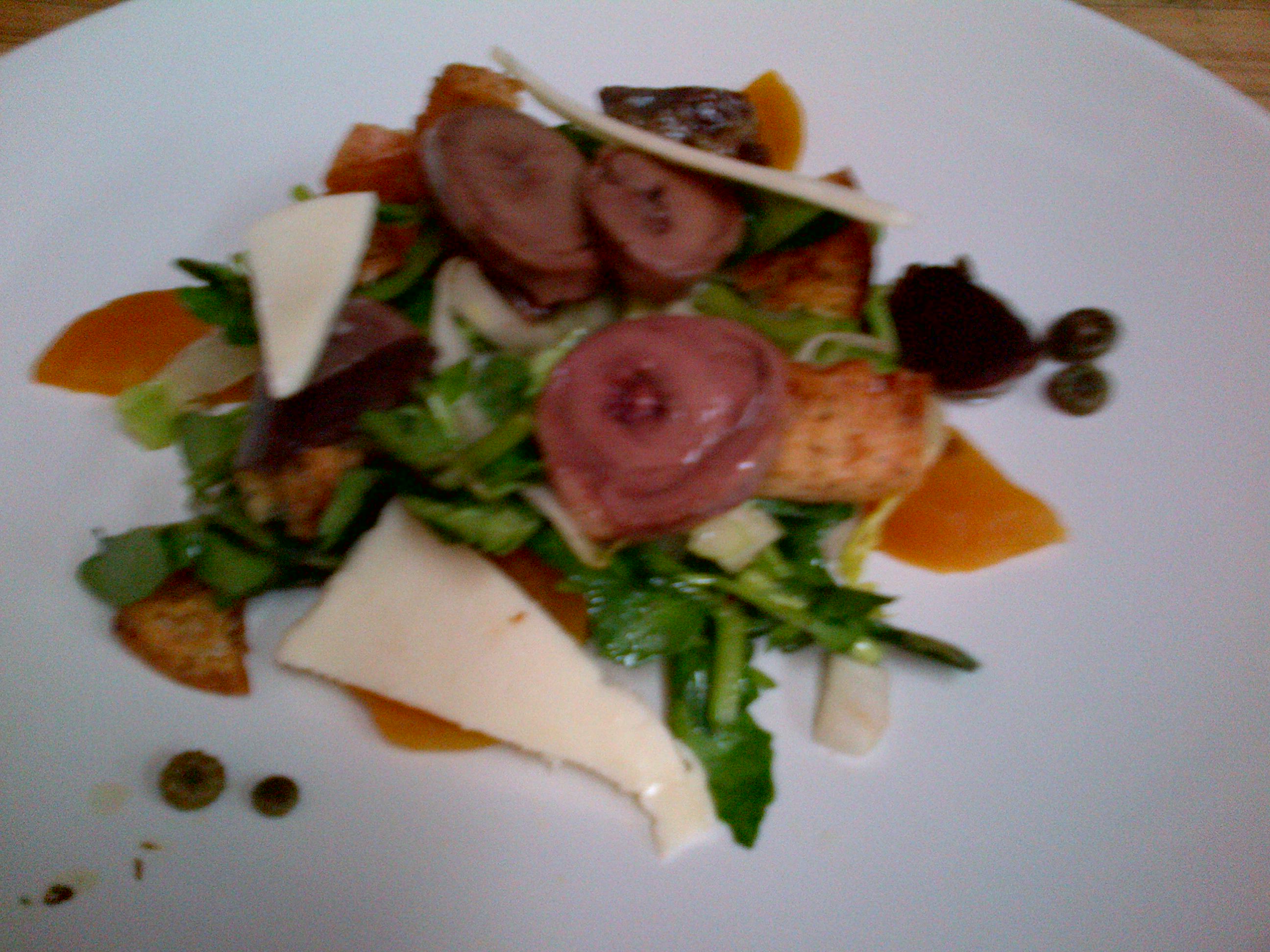
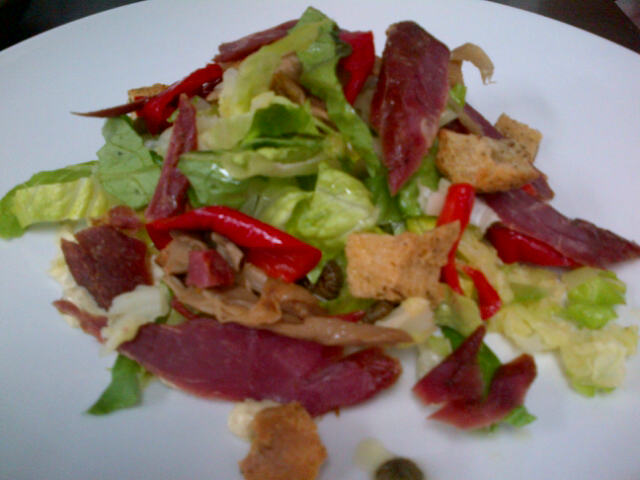
I’m done with cassoulet for a while, but now choucroute is my coup de Coeur of ducky winter dishes, including the incontournable confit and homemade duck sausage. Besides, I love cabbage and I’m into fermentation ever since my killer green beans from two summers ago.. As with proscuito, fermenting things is more conveniently a winter project when the room temp is easier to control and I have time to be patient and play around.. I haven’t had much success yet with cabbage, but I’ll get there..
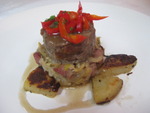 mini choucroute: confit, saucisse maison de canard, choux & genièvre
mini choucroute: confit, saucisse maison de canard, choux & genièvre
I felt like doing a fried chicken type of entrée for a change, or maybe something like ‘General Tao’ -any thing fried being a crowd pleaser. I’m constantly looking for novel ways beyond jerky to put the filets that I remove from the breast.to good use. And since duck is such a natural with ‘asian’ flavourings like soy, ginger, anise etc, there needs to be at least one course that goes in that direction. The duck fingers with wild ginger sauce below (or nuggets as Melinda coined them) was the result – and a staff favourite so far..
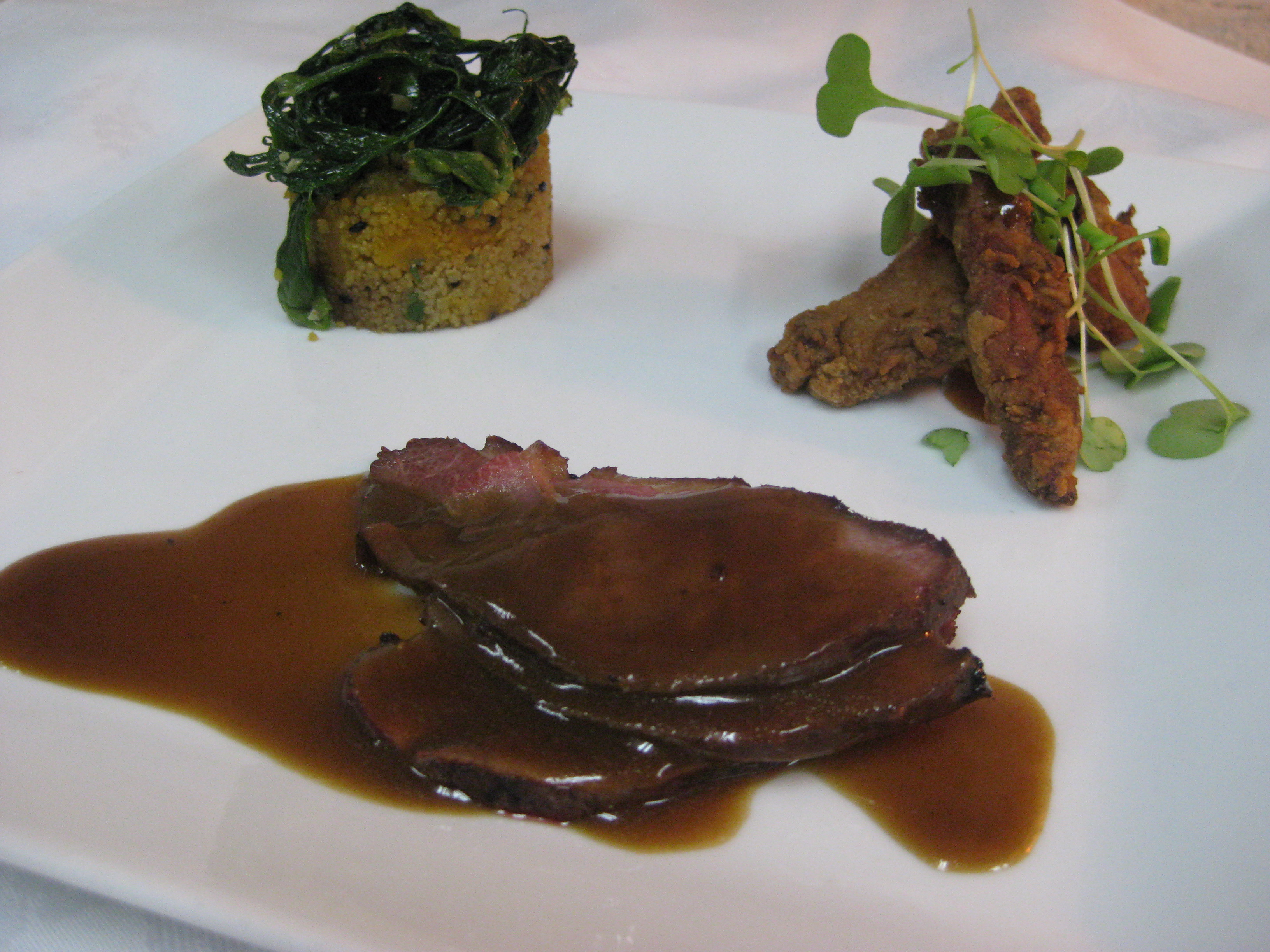 Muscovy duck supreme and fried duck fingers with wild ginger sauce, salsfis sprouts and sesame couscous
Muscovy duck supreme and fried duck fingers with wild ginger sauce, salsfis sprouts and sesame couscous
Besides a Ferme Morgan’s supreme pan-roasted with a fruity-spicy sauce of some sort, definite musts on the menu, too decadent and delicious to pass on, are duck fat potatoes and the cracklings made from the skin. I once served these as an amuse with the aperitif, bad idea! Everyone ate way too many of them. That’s another preferred snack among the waitresses that I have to keep an eye on, ‘Ca goutte le ciel, as Julie says.
To wind down the feast, there are inevitably duck egg desserts; one using the luxurious yolks, the other riffing on the springy whites. Watch out, these protein-rich whites make a surprisingly airy meringue!


As you can see, the possibilities with duck are endless. And with this cold weather, duck is just what the doctor ordered.
Here are some easy recipes (below) in case you are inspired to cook up some of this local-heart healthy meat over the winter.
Now that many duck products are quite widely available – duck stock, duck fat, confit duck, smoked duck etc.., there is no need for you to get into tricky stuff like charcuterie, making consommé, rendering fat even how to confit duck legs or making stock to enjoy a gourmet meal. It’s ok if you leave that time-consuming, messy stuff to us - the producers, chefs and butchers, the duck store (Le Canard Libéré on St-Laurent)..
Of course, you can always go all out and treat yourself to the ultimate ‘duck’ experience at Les Jardins Sauvages! Until February 3rd..
Duck recipes
Duck confit salad with ‘chimichurri’
6 p
Ingredients
3L wild/mixed greens (or romaine, watercress, endive)
400g cooked confit duck gizzards and hearts (or confit duck leg meat)
100g smoked duck magret, julienne
300g (1) potato (cubes)
250ml duck fat
120ml vinaigrette ‘chimichurri’ sauvage (spicy garlic and wild herb vinaigrette)*
100ml pickled mushrooms
2 scallions, chopped
au goût mushroom salt (or sea salt) & pepper
Method :
Heat duck fat in sturdy pot and add potato; cook gently on stovetop or in oven for 30min. Drain, season and finish in oven on baking sheet to crisp up.
Prepare greens (wash and dry, tear or chop).
Reheat the gizzards in some duck fat gently, or if in a vacuum pack, by submerging it in hot water 5min.
Toss the greens with scallions and half the vinaigrette, adding more vinaigrette and seasoning to taste.
Serve warm gizzards and potatoes on top. Garnish with smoked duck and pickled mushrooms.
*A garlicky red wine vinaigrette I make (and we sell) with wild garlic, chilli and a bunch of wild herbs (sea parsley, lovage, crinkleroot, garlic mustard leaf, bee balm..); could be replaced with any punchy vinaigrette that is sharp and slightly sweet with added herbs and garlic.
Duck Caesar salad with crinkleroot
6 p
Ingredients
3L wild/mixed greens (romaine, endive, watercress)
100g smoked duck magret, julienne
2c day old bread (cubes)
60ml duck fat
wild herb salt (or sea salt)
chopped herbs of choice
100g Capra or aged cheese of choice (that grates well)
2 scallions, chopped
20ml pickled daisy buds or capers
Crinkleroot Caesar dressing:
2tsp each minced garlic and crinkleroot
50ml minced anchovy (3-4)
3 egg yolks
1tsp crinkleroot mustard or Dijon
30ml white wine vinegar/lemon juice
30ml pickled daisy buds
60ml grapeseed oil
60ml EVO
salt, pepper
Tabasco, Worchestershire
Extra lemon to taste
Make croutons by tossing bread in rendered duck fat, season with salt and dried herbs, cook in oven at 350F for 15-20min or until golden and crunchy.
Make vinaigrette by mixing ingredients in a blender. Or combine yolks, garlic and mustard, half of lemon juice and slowly whisk in grapeseed oil. Add rest of lemon juice and continue with olive oil. Thin with a touch of oil or water to desired consistency. Season to taste.
Toss greens with half of vinaigrette, some of the cheese, s&p; adding more vinaigrette to taste. Plate salad and top with smoked duck, croutons and remaining cheese. Sprinkle extra daisy buds around.
Pan-seared duck supreme with elderberry/flower sauce
6 p
Ingredients
2 (1kg) duck supremes, skin side scored; filets kept for another use (Terrine, Jerky or Fried duck)
2 shallots, thinly sliced
thyme, peppercorn
20g butter
100ml honeywine or cider
500ml duck stock
250ml elderberries (or fruit/berry of choice, fresh or frozen)
10g (2Tbsp) elderflower (or peppercorn, juniper or rosemary)
s&p
cornstarch slurry
* In a sauce for duck, I like to combine something fruity and something spicy/herbal added later; instead of elderberry/flower combo, could be apple (1c chopped whole) and rosemary 2-3 sprigs, blackberry and juniper or raspberry and peppercorn...
Method:
Make sauce base: In a medium sauce pot, slowly caramelise shallots in a bit of butter/oil, add thyme and peppercorn and deglaze with wine, reduce down. Add duck stock and elderberries (or berry of choice). Simmer for at least 20min, allowing to reduce slowly. Add elderflower (or rosemary/juniper/herbs of choice) and let sit 5min. Strain.
Trim excess fat of duck supremes if necessary. With Muscovy, it isn’t necessary, but with Moulard or Pekin sometimes; you don’t want more than ½-1 cm/1/4”. So that there is some crispy but not too much flabby fat at end. Scoring with a knife helps the fat render/even cooking.
Heat sauté pan to med-high heat. Season duck supremes and add to pan skin side down (with no added fat). Once you start to see color, turn down to med or lower and cook for 8-10min. You want a slow caramelisation while rendering as much excess fat as possible. Pour off rendered fat a few times during the cooking. Flip and cook for 2-3min. Ideal is medium-rare. Rest in a warm place for 10min before slicing.
Degrease pan and pour in sauce base. Bring to a simmer season to taste, thicken to desired consistency with cornstarch slurry if desired (maybe 1Tbsp), swirl in butter.
Slice duck breast as thinly as possible against the grain of the meat, serve with sauce. Suggested accompaniments: Root vegetables, mushrooms, wild rice..
Duck jerky
6 p
Ingredients
8 (450g) duck filets (tenderloin) or one duck breast fat removed, sliced in 6x1.5cm thick strips
20g (1 Tbsp) brown sugar
5g (scant tsp) coarse salt
1g ea (generous pinch) pepper, smoked paprika, steak spice
.5g ea (small pinch) cumin, thyme, oregano
big squirt ea soy sauce/tamari
small squirt worchestershire
Method:
Toss with seasonings. Refrigerate overnight. Pat dry and put in a 200F on a rack in oven for 2hrs or until desired texture (dry and chewy, still sliceable).
Eat as a snack as is or slice up to garnish a salad, sandwich or canapé. Keep in fridge.
Baked duck egg with mushroom, smoked duck and tomato
6 p
Ingredients
6 duck eggs
30ml olive oil
200g wild mushrooms (or cultivated), chopped
2 french shallots, minced
15ml butter
s&p
drops lemon juice or cider vinegar/sherry vinegar
100ml heavy cream
5ml mushroom oil (and/or a few drops of truffle oil)
s&p
60g smoked duck, julienne
200ml chopped tomato
50ml chopped chives and/or parsley
pinch sugar, s&p, hot sauce
Method:
Sauté mushrooms in olive oil over medium-high heat for a couple of minutes; add butter and shallots, turn down to med/low and stew for 10 minutes; season.
Mix cream with mushroom oil (and/or a few drops of truffle oil), season.
Into buttered individual ramekins (4oz), divide mushroom mixture to cover bottom. Crack an egg into each one. Top with a tablespoon or two of cream mixture to cover.
Cook in a 325F oven for 15-20min until just set but still giggly.
Meanwhile prepare tomato salsa garnish. Add a pinch of sugar, salt and pepper to chopped tomato with fresh herbs and a bit of olive oil or mushroom oil, hot sauce to taste.
Serve ramekins of egg topped with salsa and smoked duck julienne.
Fried duck fingers with wild ginger sauce
6 p
Ingredients
12 duck filets
1/2c pastry flour (or half flour and cornstarch)
50ml plain yogurt
Marinade:
50ml soy sauce
50ml maple syrup
30ml lime juice
30ml wild ginger mustard
5ml toasted sesame oil
1tsp ea curry, five spice
hot pepper sauce (Sambal or Siracha)
Sauce:
2 shallots, thinly sliced
1tsp ea minced garlic, wild ginger
2c duck stock
2 sprigs thyme
1Tbsp± cornstarch slurry
30ml butter
Method:
Cut duck filets into 1” thick slivers (in 3).
Mix together marinade ingredients. Use half to season the duck filets, tossing to coat evenly with the yogurt.
Set aside for at least 20 min (or in the fridge hours or overnight).
Make sauce: slowly caramelise shallots in some butter. Add garlic and ginger, sauté a few minutes and add the rest of marinade. Deglaze with stock, reduce down by 1/3. Add thyme and coriander. Keep reducing another 5min to approximately half, tasting along the way. Rectify seasoning, use a little cornstarch slurry to thicken to desired consistency. To finish sauce, strain and swirl in butter off heat. Keep warm.
Pull duck from marinade, pat dry and coat with pastry flour. Fry duck by either deep frying at 350F for 2-3min or by pan-frying in a skillet with a good slick of hot vegetable or peanut oil for 3-4min (1-2 min each side). Remove onto paper towels, and serve with sauce. You can always coat the fried duck in sauce General Tao style but I prefer it separate.
Suggested accompaniments: rice, sautéed mushrooms and mustard greens, or rice noodles, lettuce, red pepper, bean sprouts, coriander and mint.. Could be finger food too!
Moving on from Mac: my new Kikuichi
I just finished my first week end with my new partner, he's pretty cool. Actually, he’s definitely more of a she. I have yet to see whether this Kikuichi will replace my beloved Mac whom I miss terribly. He just disappeared one day, I don’t understand. I waited a month before looking for a replacement; now, I’m ready to move on.
 She feels good in my hand and is sharp as all get out, but is perhaps a touch delicate for a brute like me. She seems less versatile too, more of a slicer than a chopper. I’m not sure she's cut out to be my number one. You see, I am not the sort of gadget girl who is reaching into my knife kit everytime I change tasks; I like a knife that I don’t have to put down much, that isn’t too fussy, that I can use for almost everything, that feels natural like an extension of my arm. So understandably, I take this relationship seriously, get pretty attached to my right hand man (or whatever), my partner in life.
She feels good in my hand and is sharp as all get out, but is perhaps a touch delicate for a brute like me. She seems less versatile too, more of a slicer than a chopper. I’m not sure she's cut out to be my number one. You see, I am not the sort of gadget girl who is reaching into my knife kit everytime I change tasks; I like a knife that I don’t have to put down much, that isn’t too fussy, that I can use for almost everything, that feels natural like an extension of my arm. So understandably, I take this relationship seriously, get pretty attached to my right hand man (or whatever), my partner in life.
We'll give it a go with the Kikuichi, but she'll probably need help eventually and I'll have to go back to the boys. Not necessarily European, but I’m always looking for the perfect mix, kind of like Mac. I love so many Japanese blades, but they all have unwieldy long handles I don't dig, not to mention that they are often not tough enough, high maintenance, too girly.
Summer to Fall, Mother Nature and Mushrooms
Although there is no doubt that we’re still riding peak season at Les Jardins Sauvages, I guess it’s time to admit that the 'summer of summers' is now officially over..
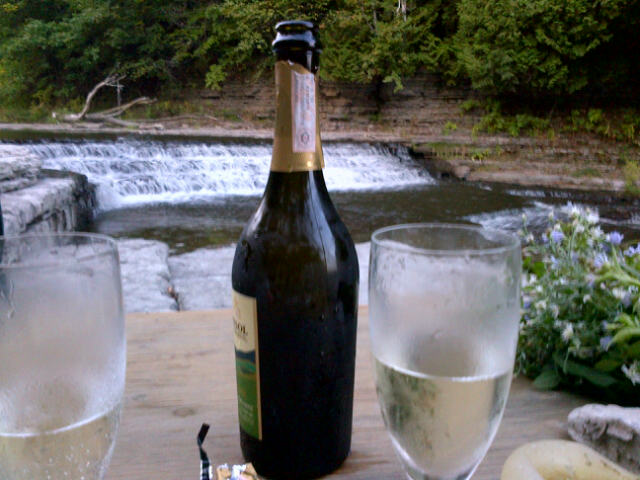 now, less of this
now, less of this  And more of this: cleaning & cooking mushrooms
And more of this: cleaning & cooking mushrooms
The season change notably creeps in before we’re ready, and the calendar date passes while we’re still in summer mode. It only feels real a week or two later.. When my soups get heartier and a hot app naturally replaces a salad on my menu. When bread making becomes more manageable and my chef jacket is a welcome layer on top of my camisole. When fresh wild flowers become hard to find for the table tops.. When there is more brown than green hitting my pantry. When my favourite spot outside the kitchen moves from the river (or terrasse) to next to fireside. Yup, time to shift modes, bundle up and focus on the mushrooms, maybe chop some wood.
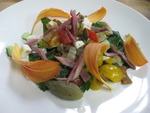 less of this: salad with wild greens and flower petals
less of this: salad with wild greens and flower petals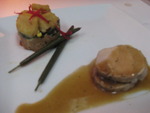 more of this: Piglet two ways, wilted wild greens and mushroom jus I do adore the seasons. I’m nonetheless always sorry to see one close, simultaneously feeling excited about the next one moving in, with all its novel spendour and contrasts, familiar comforts and certain surprises in store.
more of this: Piglet two ways, wilted wild greens and mushroom jus I do adore the seasons. I’m nonetheless always sorry to see one close, simultaneously feeling excited about the next one moving in, with all its novel spendour and contrasts, familiar comforts and certain surprises in store.
Looking back, summer 2012 was indeed beautiful, but! For sure, the lamest for wild edibles I’ve seen since I embarked on this adventure with François. No problem if you have all day/week and are foraging for your family dinner alone.. It was a struggle for anything green, not much better for the tasty toadstools. Only the tomatoes and peaches seemed to flourish. The non-wild revelation of the summer: these micro tomatoes François planted in our garden! (one of the original heirloom varieties from Mexico)
Thankfully, in certain regions like the Gaspesie and further north, there was enough rain and alternate sunny weather for decent wild harvests. It's a good thing that François has built a network of pickers across the province over the years, people he met on his travels and trained, or others - knowledgable kindred spirits he formed a partnership with.. To think back to the day when he had to be everywhere or miss out, living out of his truck and tent, picking everything himself!
In his primary foraging/family territory - the Outaouis and here in the Lanaudière, the blackberries dried before ripening, blueberries, and raspberries the same; the mushrooms were sparse. This was definitely not a chanterelle year, for instance. Normally, I cross the bridge and see mushrooms everywhere, not this year. We had to hunt far and wide. And when found, they were often piqué (worm infested) before anyone could get to them in numbers. The BC and foreign suppliers certainly did well on the Quebec market this year. Those seeking out local mushrooms were all over François and his team at Marché Jean Talon; we couldn’t keep up. Which also means I hardly got my fair share of summer varieties at the resto/workshop.
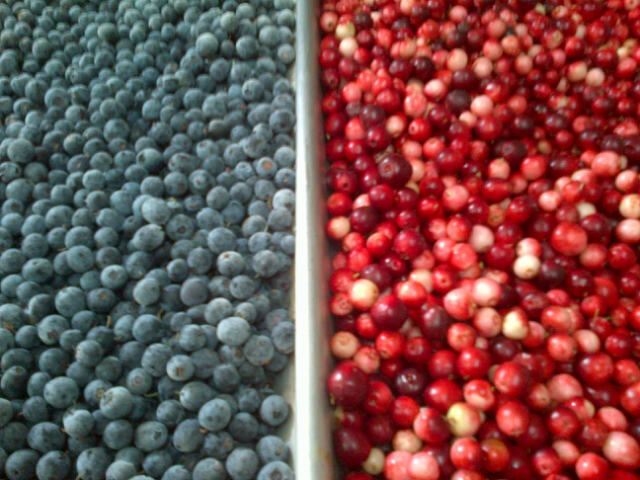 airelles de marécage/airelles (cote nord)
airelles de marécage/airelles (cote nord)
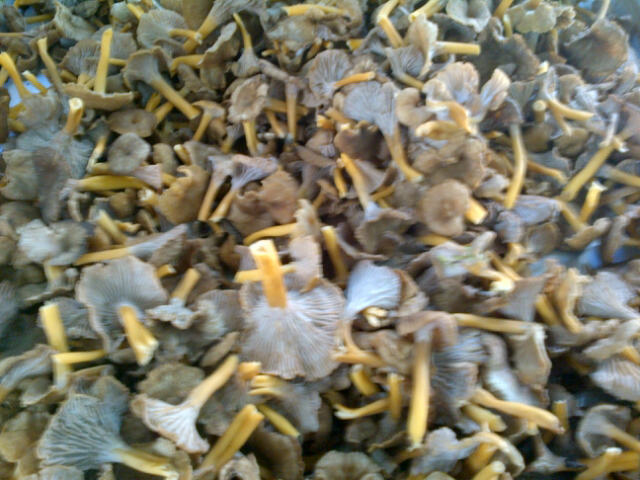 chanterelles en tubes/yellowfoot chanterelle beauties
chanterelles en tubes/yellowfoot chanterelle beauties  polypore soufré/chicken mushroom
polypore soufré/chicken mushroom
So, a thousand pounds in maybe, not counting what François sold at market. Last year, I had processed over a ton by now, 2 tons by Oct - be it cleaned and dehydrated, with a first cooking and sous-vide, or pickled, put up somehow. I’ve had an easy summer, hence the tan. Only working 50-60hr weeks on average, mother nature didn’t make as many of her extraordinary demands with regular relentless abundance in short spurts, less cross over. I got to deal with a couple of weeds/berries/greens at a time, usually keeping up despite my meagre staffing. We nailed all our basics from the pickled buds, cattails in all forms, sea parsely pesto and sousvide sea spinach, all the flowers/greens for the tisane and sirops, just enough berries for my jams/coulis/vinaigrettes etc. I managed to do quite a bit of preserves with the cultivated stuff too (peas, corn, tomatoes in many forms - ketchup, hot sauce, ratatouille..)
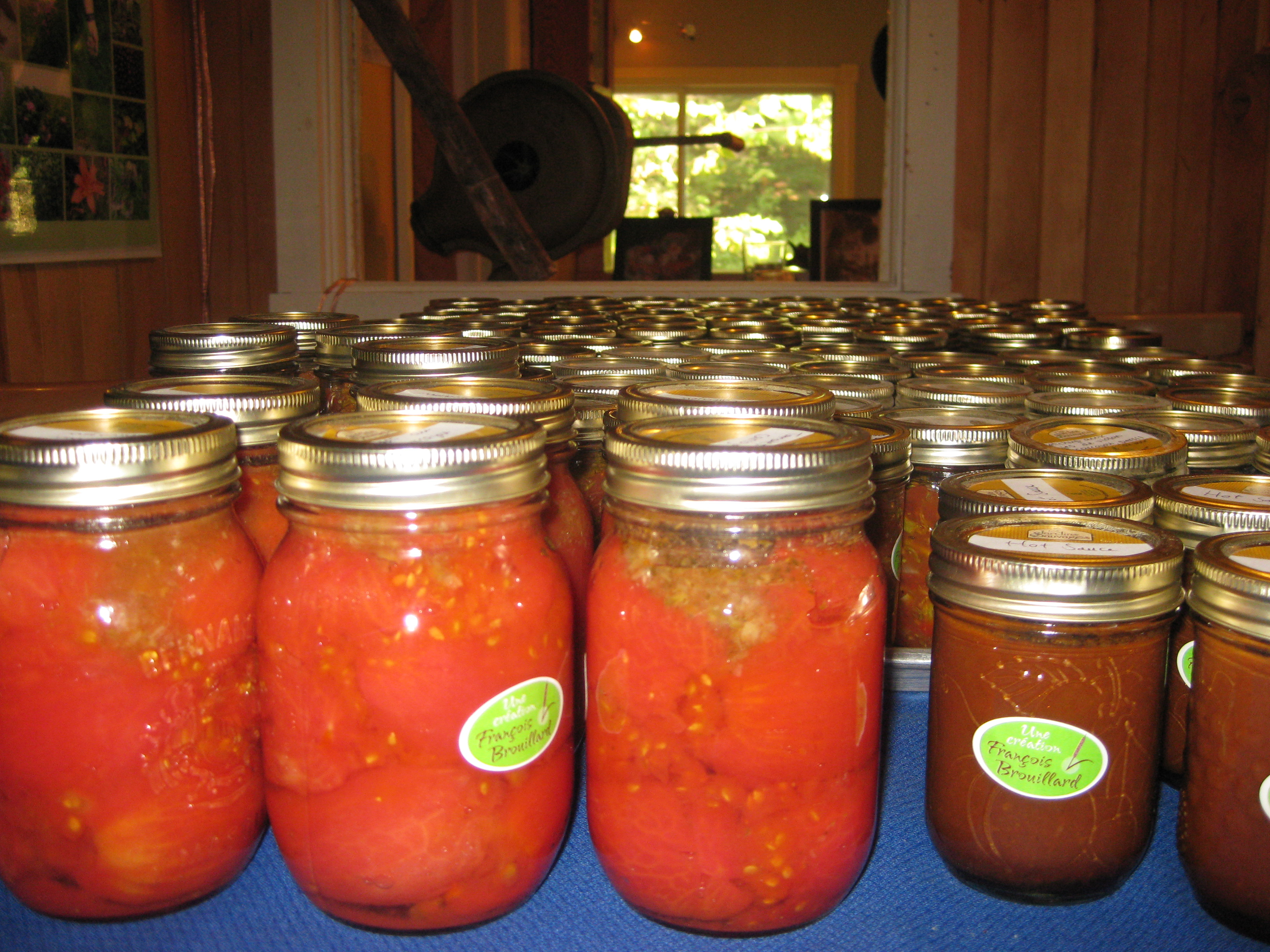
Not quite the mushroom nirvana I’ve grown accustomed to thanks to my forager of foragers, I couldn’t help but spend the last leg of the summer worrying.. Would I have enough for our monster mushroom festival and for all our products year-round? A constant juggling game, I would certainly have to regroup and make do with what I have, reconfigure our products, ditch label inventory $$, oh the joys of the wild life in business..
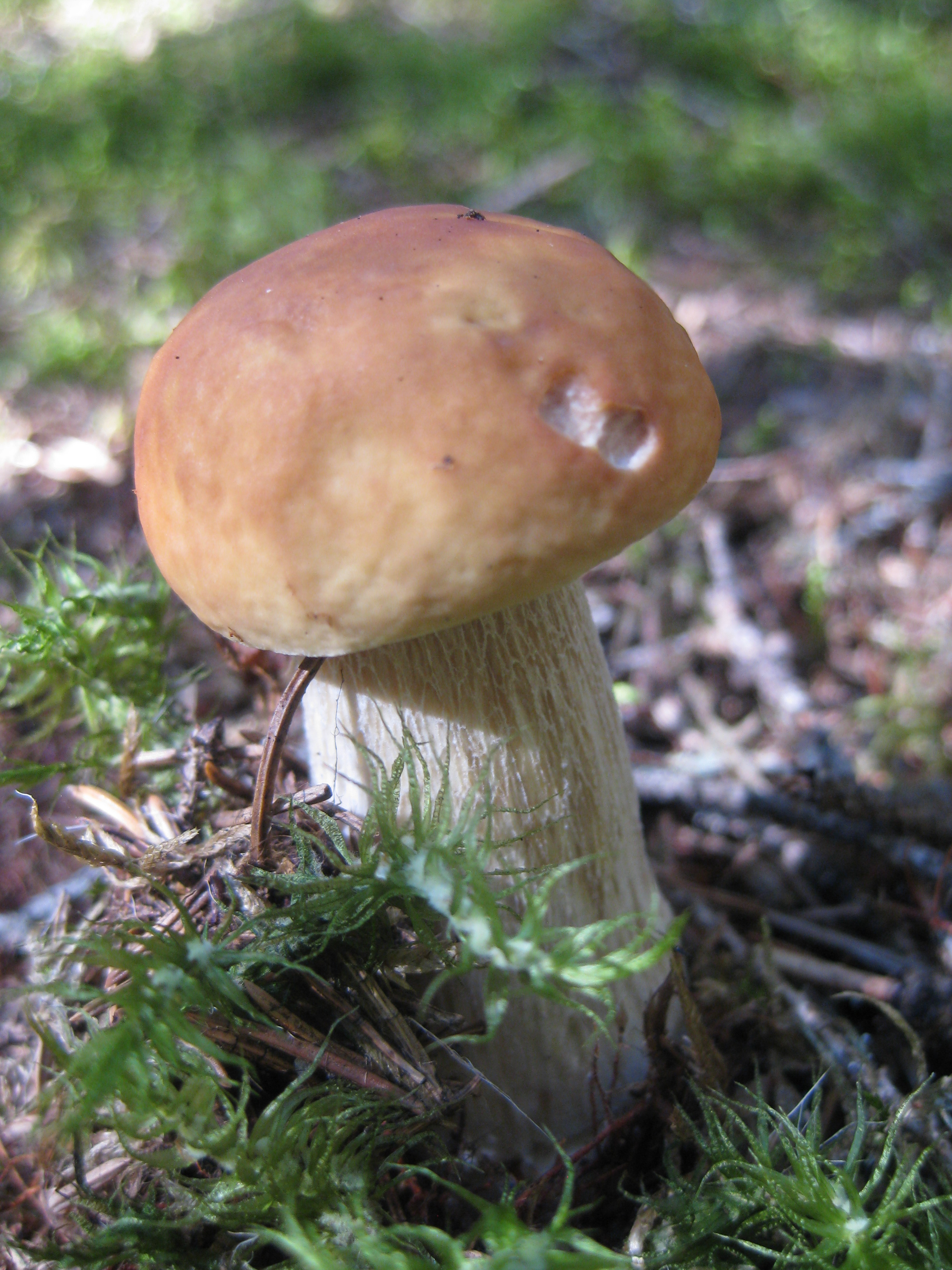 cepe
cepe 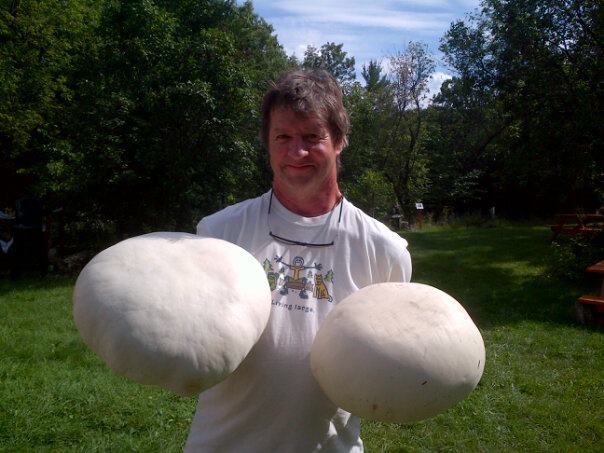
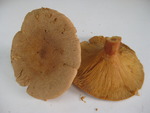 Lactaire à l'odeur d'érable/Maple scented lactarius
Lactaire à l'odeur d'érable/Maple scented lactarius
Then there was the most welcome surprise - a formidable harvest of Amanite des Césars, the king of mushrooms and a rarity here. Even in France, where it is prized above all varieties, it is a rare treat to see more than a pound, especially like these.. François definitely impressed some mushroom snobs this year in a bad mushroom year no less.. For our tenth anniversary, we will have this noble shroom on our mushroom menu for the first time.
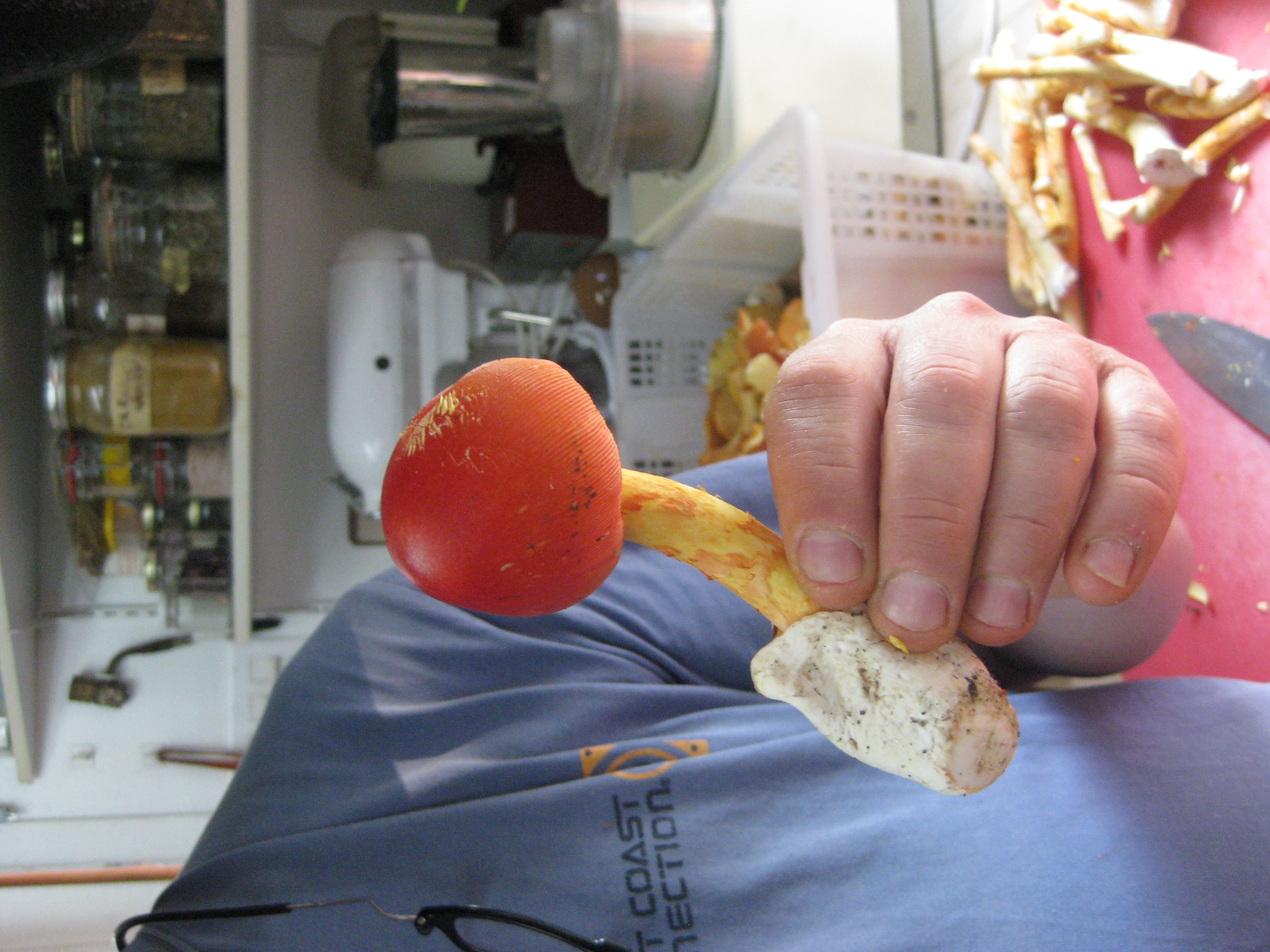 bebe amanite des césars
bebe amanite des césars
And there is hope yet across the board - this past week was fantastic, the best of the year yet. Cepes & Lactaires Délicieux are sprouting in the backyard. The shrooms are coming in from all our pickers at a faster pace by the day and I’m managing to cover with less staff than in prior years. We processed 200lb this weekend alone and there is a major line up for the dehydrator and my time. Gorgeous yellowfoot chanterelles and hedgehogs! Came across a good amount of a variety of small hedgehog (pied de mouton ombeliqué) that is a fun novelty. A pretty stellar year for that rare maple scented Lactarius too, probably not enough to sell but sufficient for my restaurant needs. A trickle of armilaires and matsutake, hoping for more.. Lactaires Delicieux, Puffballs and autumn cepes, slippery jacks and Larch boletes showing up on schedule here, weehoo. Some beefsteak polypore a bonus! The autumn oysters, smooth lepiota and shaggy mane will be next, fingers crossed.
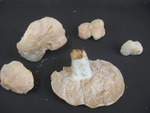 pied de mouton/hedgehog, nice harvest from Gaspesie getting better by the day
pied de mouton/hedgehog, nice harvest from Gaspesie getting better by the day
 pied de mouton ombeliqué
pied de mouton ombeliqué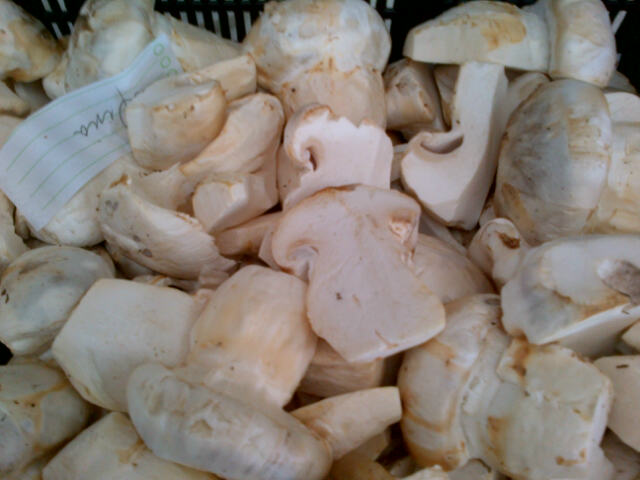 armillaire ventru/swollen stalked cat
armillaire ventru/swollen stalked cat
She just might catch up that tricky dame nature. And I will have no choice but to follow.. Which is fine; I am now used to responding to her whims, and it so happens that cooks looking for work appear to be coming out of the woodwork as they magically do in fall. Forever grateful even if I have to scramble and go into overdrive this autumn season. Let a new set of games begin! Countdown to our mushroom festival Oct 12-28!
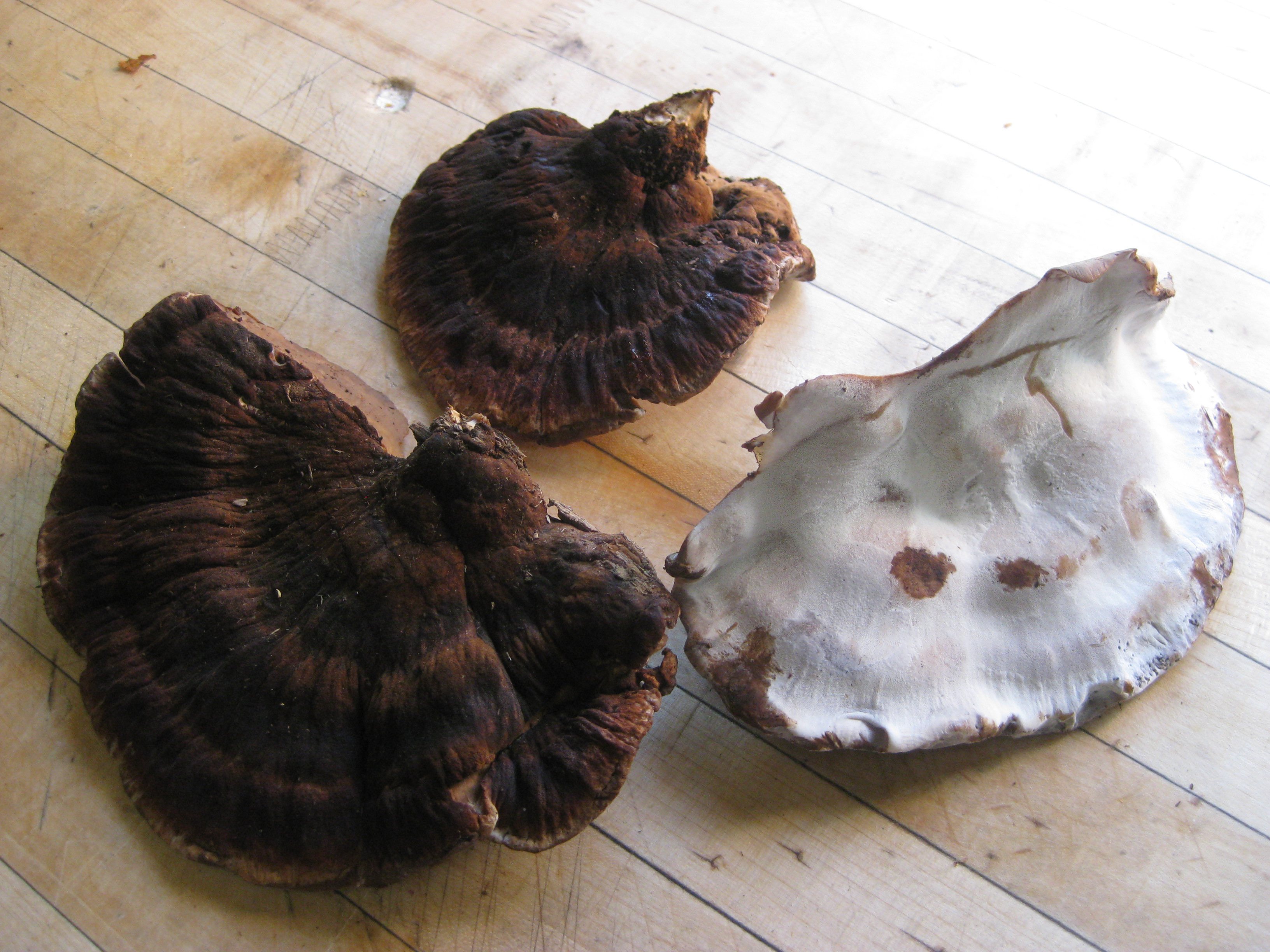 Beefsteak Polypore
Beefsteak Polypore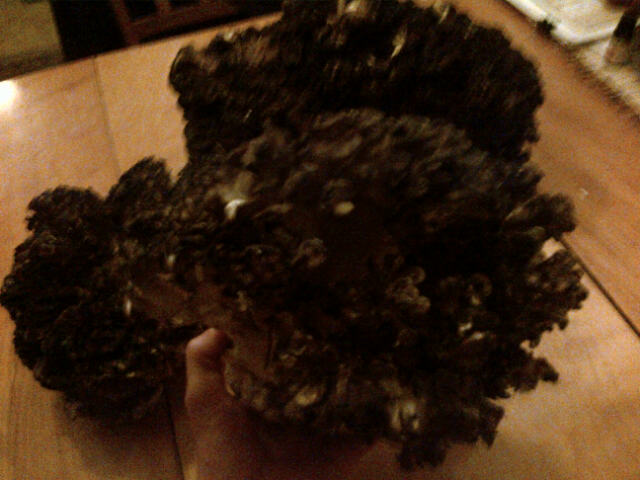 Hen of the woods, a favourite for a braise or to pickle
Hen of the woods, a favourite for a braise or to pickle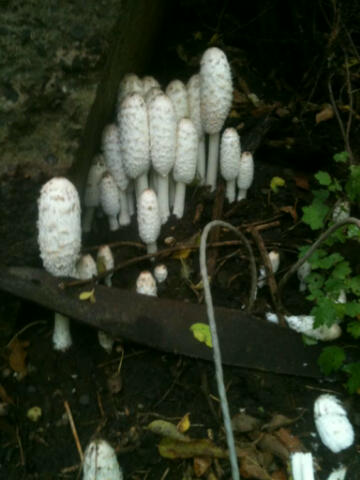 shaggy mane; best when young (same day), no dark color - in soup
shaggy mane; best when young (same day), no dark color - in soup  autumn oyster (or elm oyster; although it grows on maple)
autumn oyster (or elm oyster; although it grows on maple)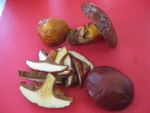 another slimy/hard to work bolet that pays off in the dehydrator
another slimy/hard to work bolet that pays off in the dehydrator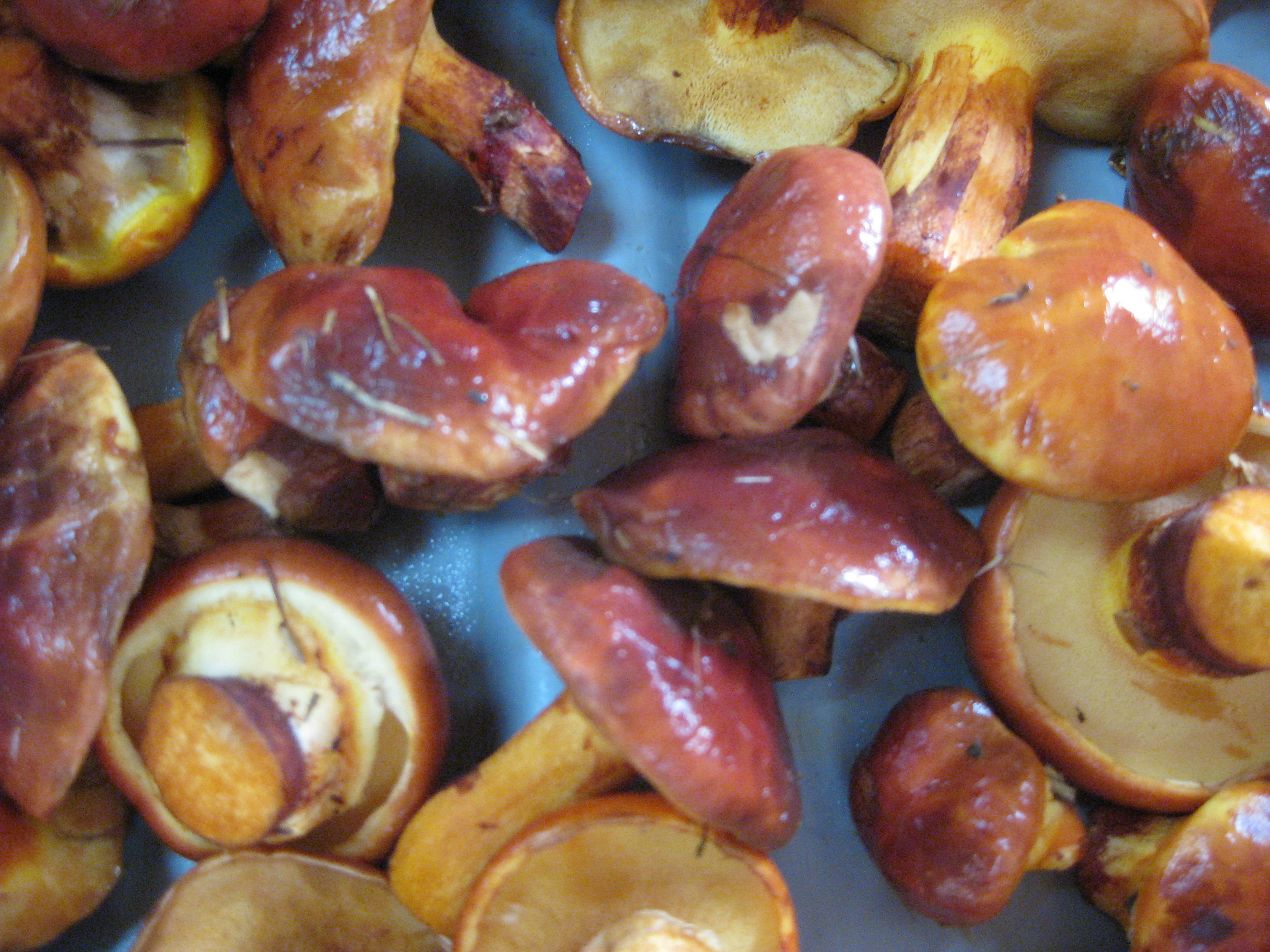 Larch bolete - one of the best flavourwise but it's a pain to clean (and expensive with 5% yield after drying).
Larch bolete - one of the best flavourwise but it's a pain to clean (and expensive with 5% yield after drying).
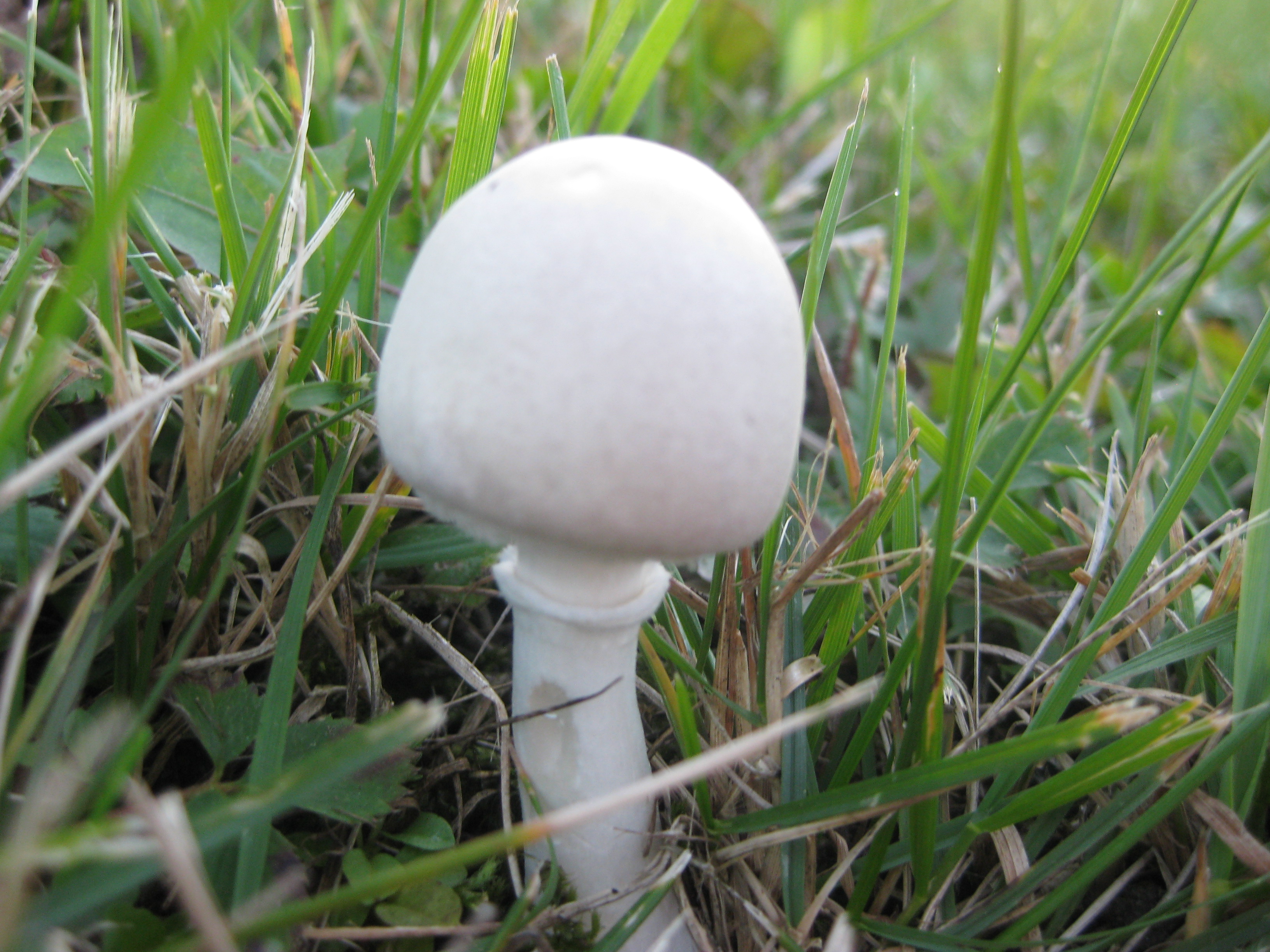 Smooth Lepiota - to be picked with caution because it looks a lot like dangerous varieties like 'the destroying angel'
Smooth Lepiota - to be picked with caution because it looks a lot like dangerous varieties like 'the destroying angel'
Highlights - Early Summer 2012
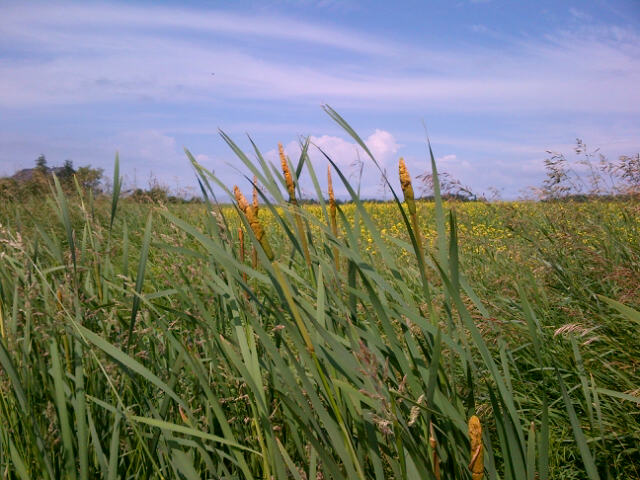 quenouilles (cattails)
quenouilles (cattails)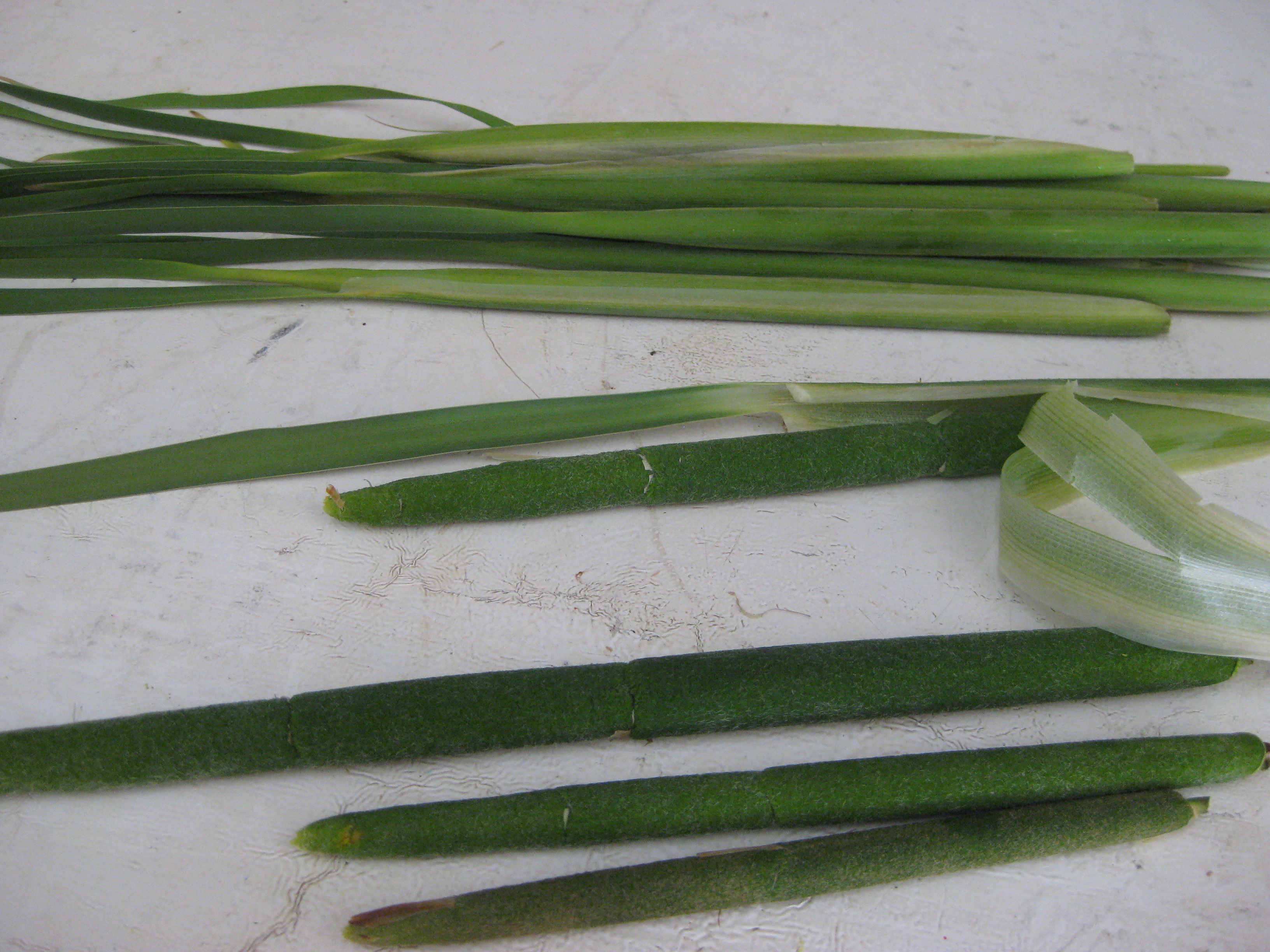 epis de quenouille (cattail spears) - raw and peeled
epis de quenouille (cattail spears) - raw and peeled
 farine de quenouille-pollen (cattail pollen flower)
farine de quenouille-pollen (cattail pollen flower)
True to our annual summer routine at Les Jardins Sauvage, life is all about trying to keep up with the wild plants as they successively come into season whenever they damn well feel like it.
This year is not so different; many July edibles showed up early making for somewhat of a pile-up in putting up/production, but an extraordinary abundance and variety for those dining at the restaurant or frequenting our market stall.
Once the spring things were out of the way, it was all about pickling the daisy buds and soonafter the day lily buds, then it was cattail time.
Or 'Operation Quenouille' as we call it - For a couple of weeks every year, we are entirely consumed with cattails. There is an unpredictable short window to pick the baby spears you see.. We peel thousands, blanch and sous vide them for the year. Everyone on staff is peeling day in day out, every spare moment. Then it's the pollen, which is dried and ground after harvesting. That is hard picking work given this corresponds with peak mosquito season - those responsible are all glad it only lasts a couple of days. In the kitchen, a fine yellow dust covers everything no matter how carefully we work. Blow your nose at home at the end of the day - yellow! Well worth it though; the spears provide a fun local vegetable that you eat like corncob or pogo, and it tastes like corn, with a touch of mushroom and asparagus. Makes a great umami rich vegetarian broth too. We use the pollen in crepe batter mostly, but it can season and thicken stuffings, go into quick breads and cheese. I like to dust savoury fritters with it.
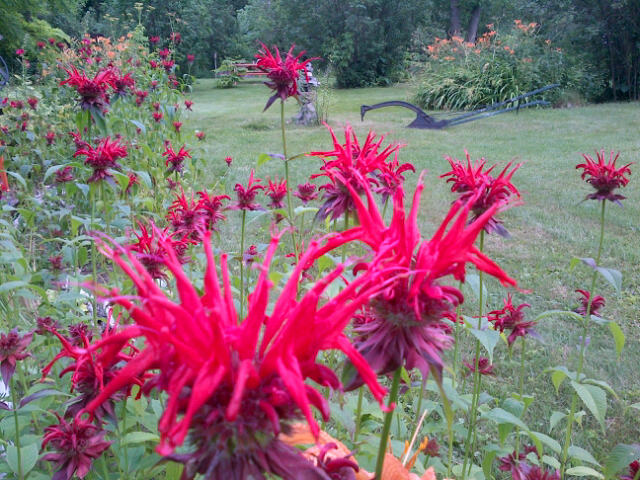 Monarde (Bee balm)
Monarde (Bee balm)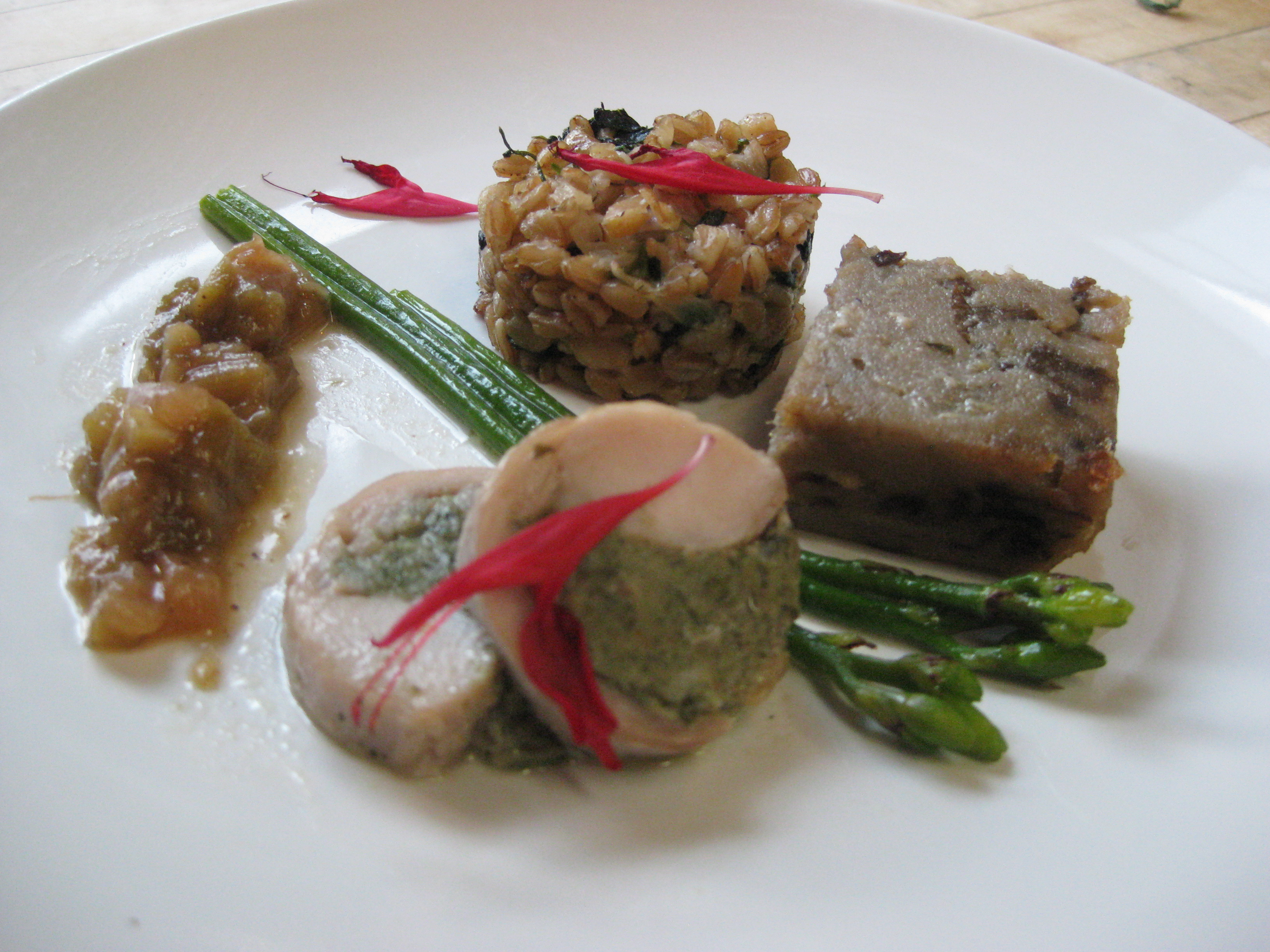 Duo de lapin, ortie & monarde, épautre, pousses d'hémérocalles Bee balm is a favourite of ours. So pretty and punchy, it is more than a colourful garnish; with its thyme like mentholy flavor, it is used more like an herb. To flavour or garnish soups, salads, butter, cheese, sauces, meatballs.. We also dry it and use it in our tisane.
Duo de lapin, ortie & monarde, épautre, pousses d'hémérocalles Bee balm is a favourite of ours. So pretty and punchy, it is more than a colourful garnish; with its thyme like mentholy flavor, it is used more like an herb. To flavour or garnish soups, salads, butter, cheese, sauces, meatballs.. We also dry it and use it in our tisane.
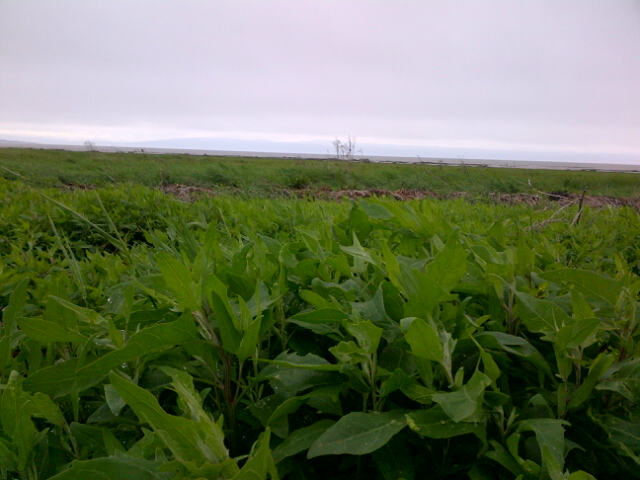 Arroche de mer (Sea spinach)
Arroche de mer (Sea spinach)
Sea spinach is my absolute favourite, like super duper spinach, a notch up from Chou gras (pigweed/lambs quarters), which is also a great, under-appreciated weed. Terrific in salad, even better barely cooked, just wilted with garlic and olive oil or butter. Arroche was definitely a key wild green in our courtship (when I first met François and he was charming me with all his exotic ingredients). We sell and serve up a lot of this fresh in season, but we also blanch and sous-vide a big batch for the year, and we dry some for our salt.
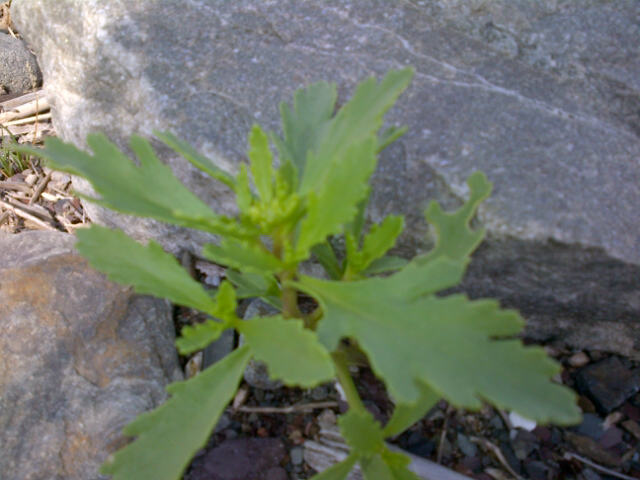 Caquiller de mer (Sea rocket)
Caquiller de mer (Sea rocket)
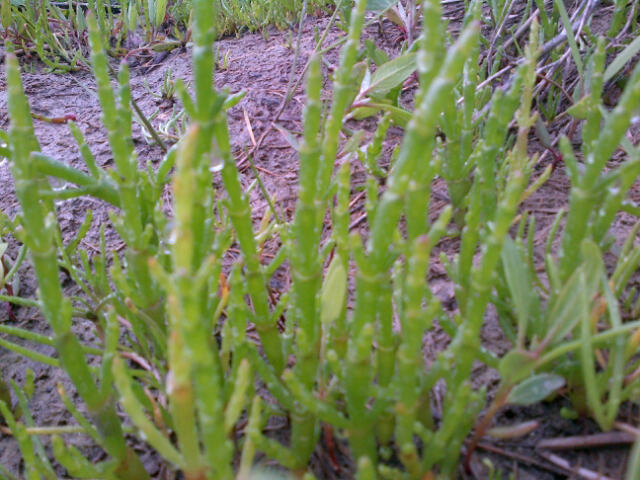 Salicorne (sea asparagus)More sea greens, both very popular at the market. Sea rocket is like sturdy, salty arugula, to be eaten in salad or cooked. Not much needs to be said about sea asparagus which is more widely known, being so lovable, crunchy and salty. Especially ours in peak season, which is picked in the perfect micro-climate, extra special
Salicorne (sea asparagus)More sea greens, both very popular at the market. Sea rocket is like sturdy, salty arugula, to be eaten in salad or cooked. Not much needs to be said about sea asparagus which is more widely known, being so lovable, crunchy and salty. Especially ours in peak season, which is picked in the perfect micro-climate, extra special
.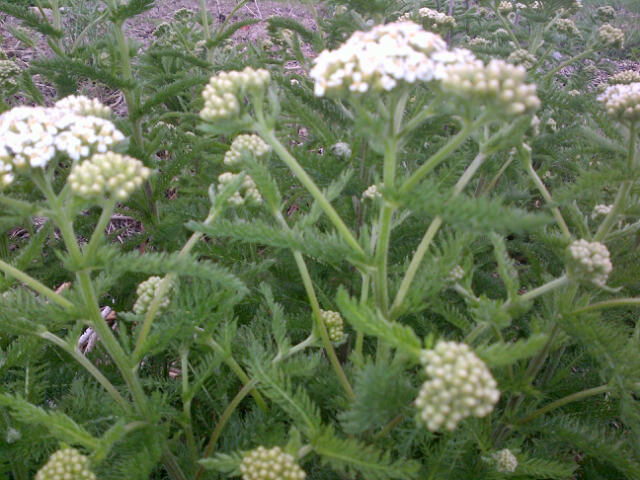 achillee millefeuille (common yarrow)
achillee millefeuille (common yarrow)
Yarrow is everywhere and a mildly interesting herb that we add to our mix. We also dry it for tisane. It is known for all its medicinal qualities (cold, wounds..). The flowers are especially medecinal, so kept for that.
Wild rose petals - one of the most pleasant things to pick, dry or cook! So fragrant and fresh smelling/tasting. We dry a load for our tisane, make syrup and use them in infusions for desserts (juices, coulis, granité). Interesting in savoury preparations too. The fruit, however difficult to work with all its seeds, has a characteristic soft flavour and mouthfeel unlike anything else, ultra high in Vitamin C, somewhere between a tomato and an apricot in taste. Claudie (Jardins de la Mer), our marine green girl, makes a fabulous juice combined with elderflower that is my preferred non-alcholic beverage. Not yet readily available yet outside the Lower St-Lawrence, but something to look forward to.
Spergulaire is another marine green that grows amidst the salicorne and arroche - it is sparse, and hard to find/pick efficiently but it is delicious - tasting like beets, but delicate fresh and crunchy. Sea plantain is kind of blah to me, in that it does not have much character, but mild is fine sometimes too. It is good chopped up in the mesclun or cooked as a side vegetable. The best preparation to me is blanched and served up like green spaghetti sans gluten!
Sea parsley, the marine sister to the wild lovage on our property, tastes like floral, slightly salty celery, and is key in my kitchen. We make a pesto with it, we dry it for our salt, make an infused oil, and it is integral to my chimichurri. I use it everywhere year round.
While all the marine greens are peaking and François is on the road alot, our backyard is orange. Fields of day lily yell out for the taking. Once the sprouts and buds (which are a terrific vegetable) are done, it's petal time. They are best freshly picked and raw in salads or as a garnish, but given the quantity we have readily available, we do a lot more. Of course it takes someone to pick them, but it's impossible to not be sustainable.. I've dried a hundred gallon buckets or so of petals for our tisane and put up half that much in pesto. Delicately floral, even more vegetal-fresh tasting, I make butter with it, as well as use it in preparations to accompany fish, poultry or cheese.
Melilot (sweet clover) is a flower I use more like a spice. It is dried and pulverised to be incorporated into pie dough, cookies.. Most other flowers I prefer to use infused and in the fresh state, but not this one. It is potent and due to coumarine content,should be used carefully.
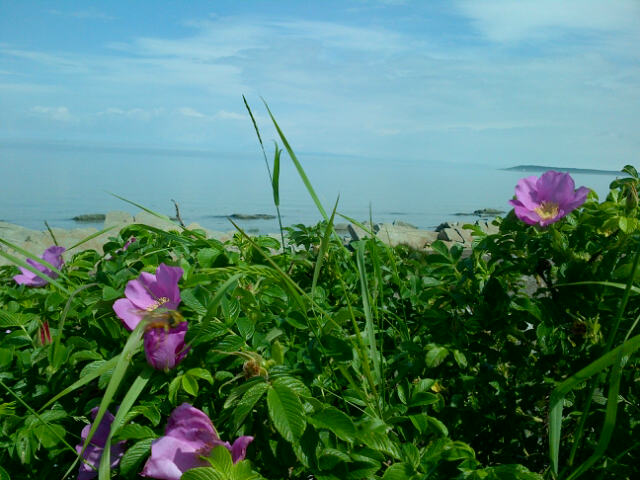 églantier (wild rose)
églantier (wild rose)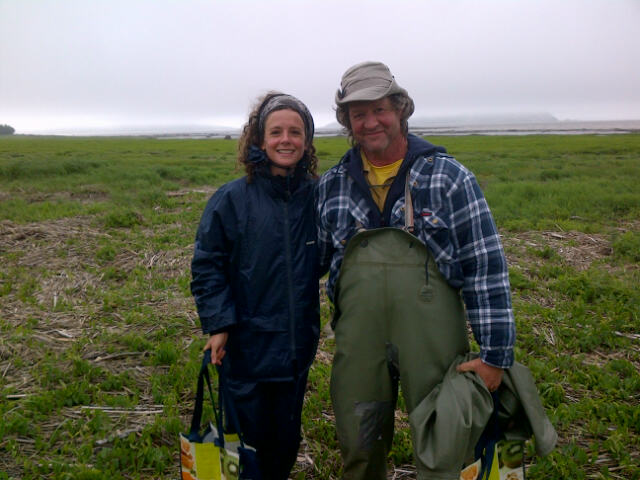 foraging in the worst weather
foraging in the worst weather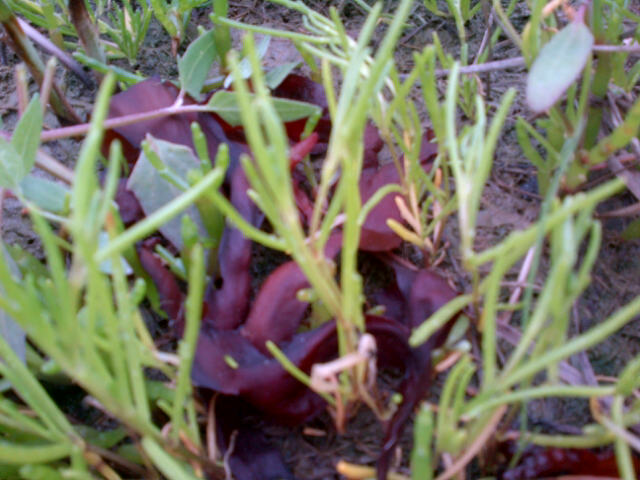 spergulaire (Canadian sandspurry)
spergulaire (Canadian sandspurry)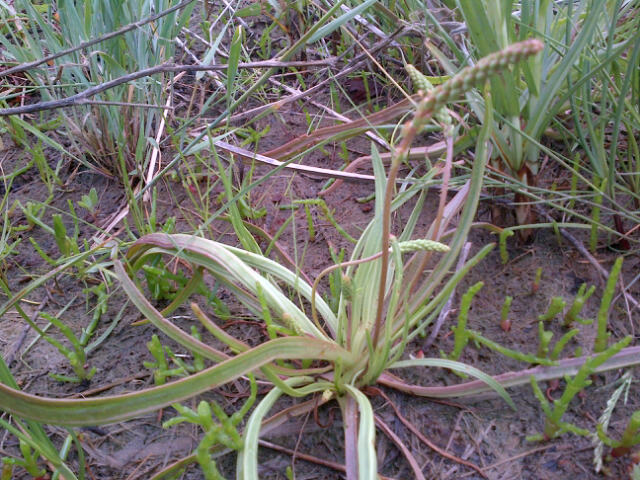 plantain marin (sea plantago)
plantain marin (sea plantago)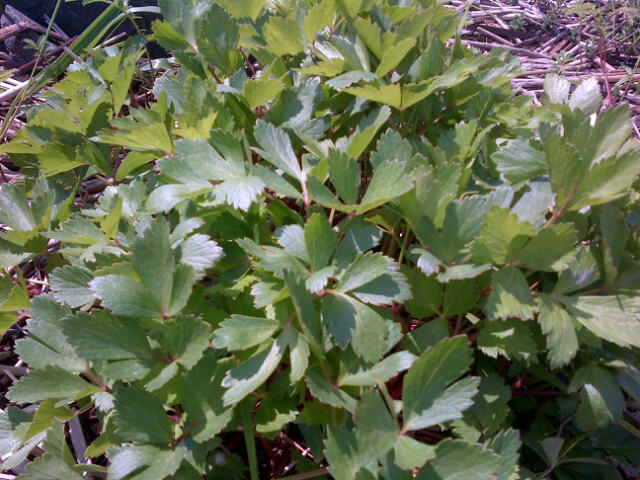 persil de mer (sea parsley)
persil de mer (sea parsley)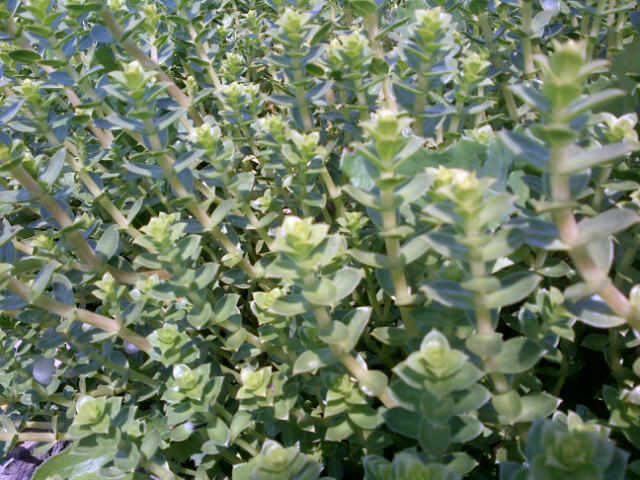 sabline
sabline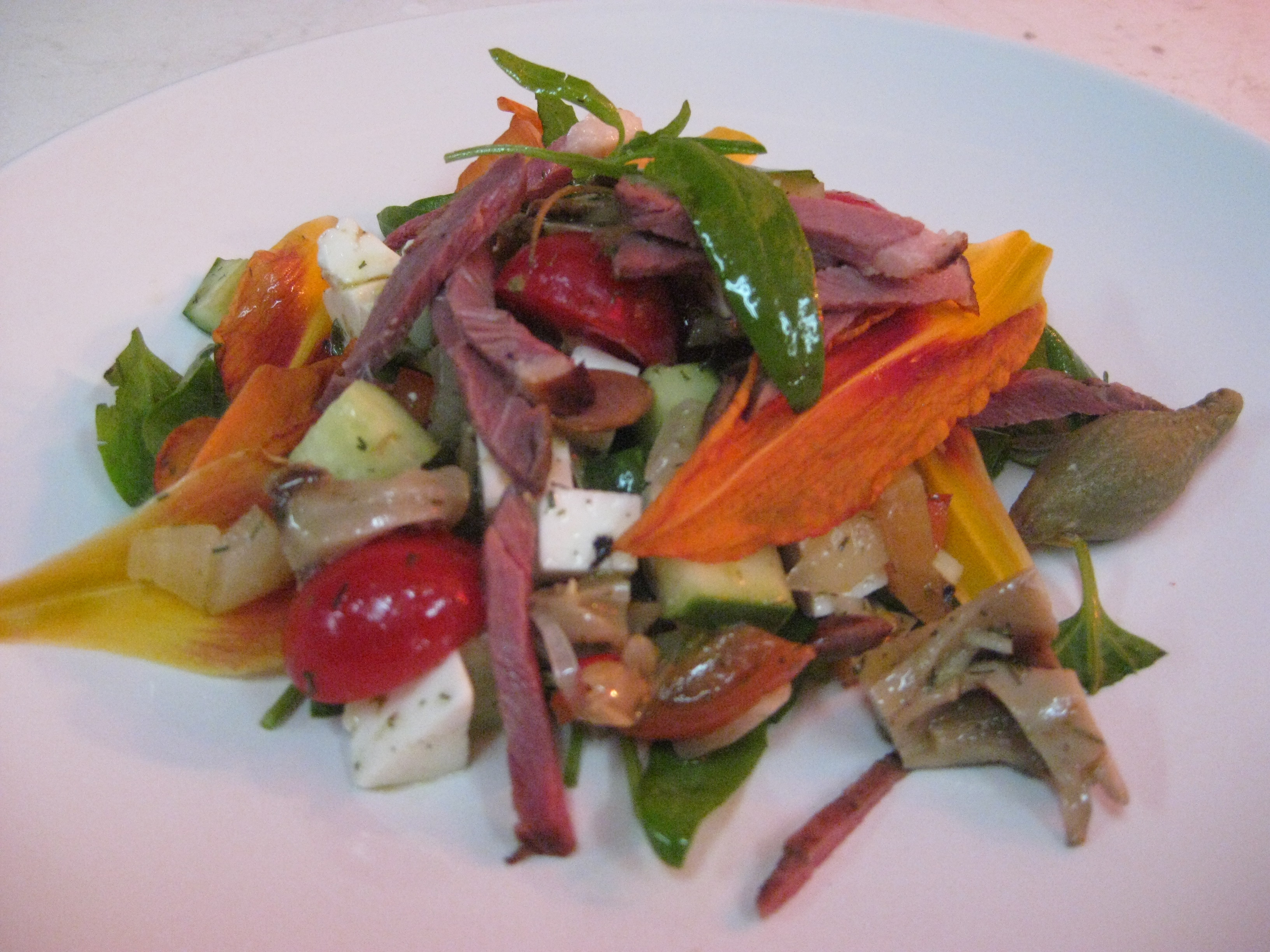 salade d'aroche de mer & hémérocalle, salsa de tomate, concombre et champignons marinés au carcajou, feta de chevre
salade d'aroche de mer & hémérocalle, salsa de tomate, concombre et champignons marinés au carcajou, feta de chevre our field of day lily
our field of day lily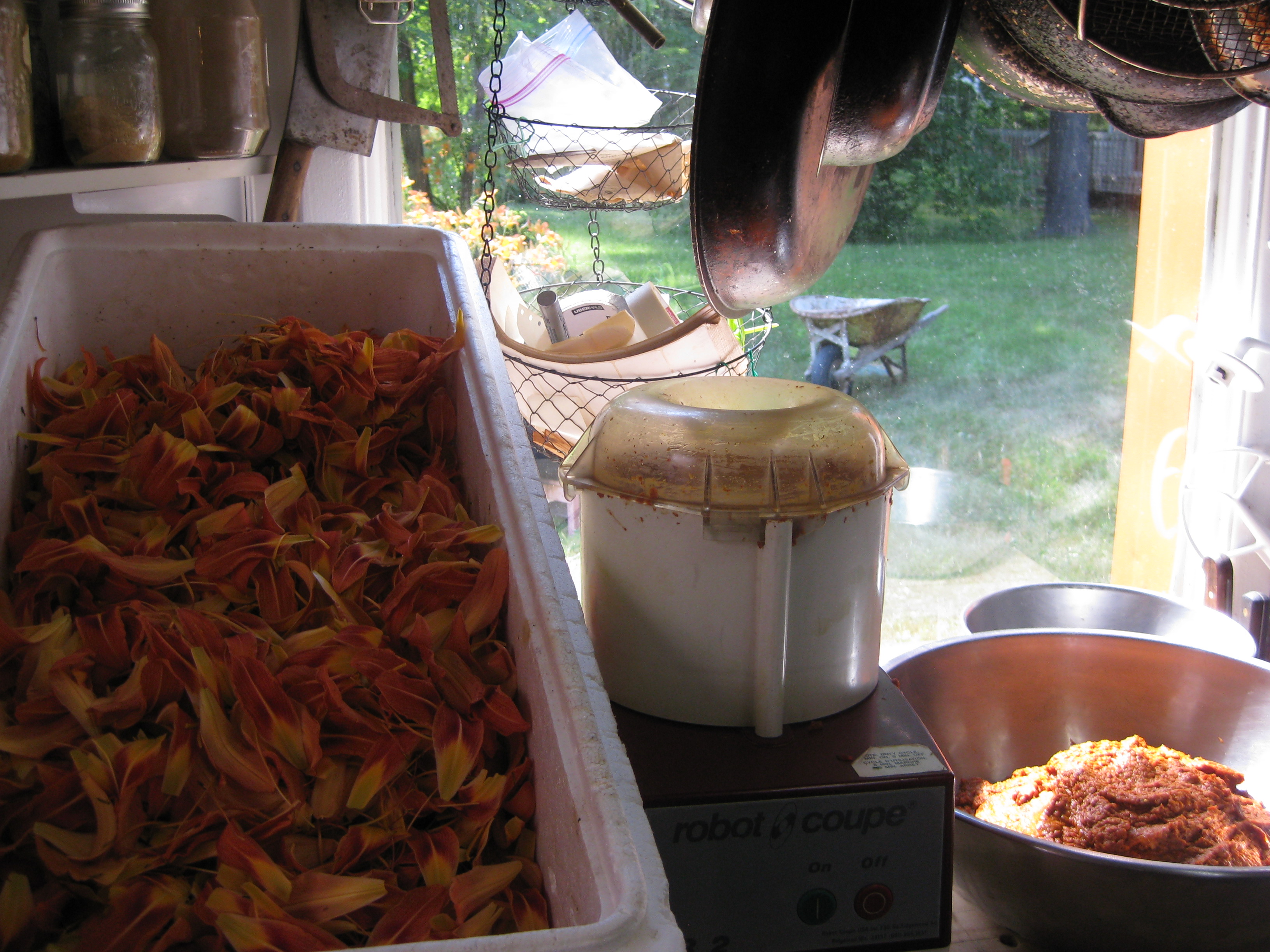 making petal pesto
making petal pesto plantain=green spaghetti
plantain=green spaghetti
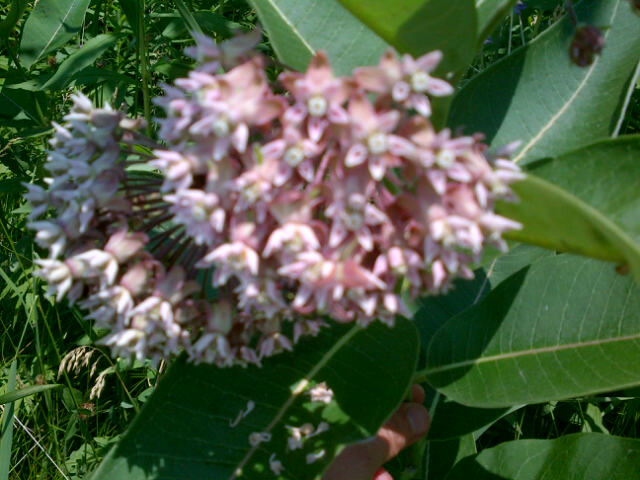 fleurs d'asclépiade (milkweed flower)
fleurs d'asclépiade (milkweed flower)
 brocoli d'asclépiade (milkweed brocoli) - the unopened flower
brocoli d'asclépiade (milkweed brocoli) - the unopened flower marguerite (daisy) - past the point when we use them, but pretty none the less
marguerite (daisy) - past the point when we use them, but pretty none the less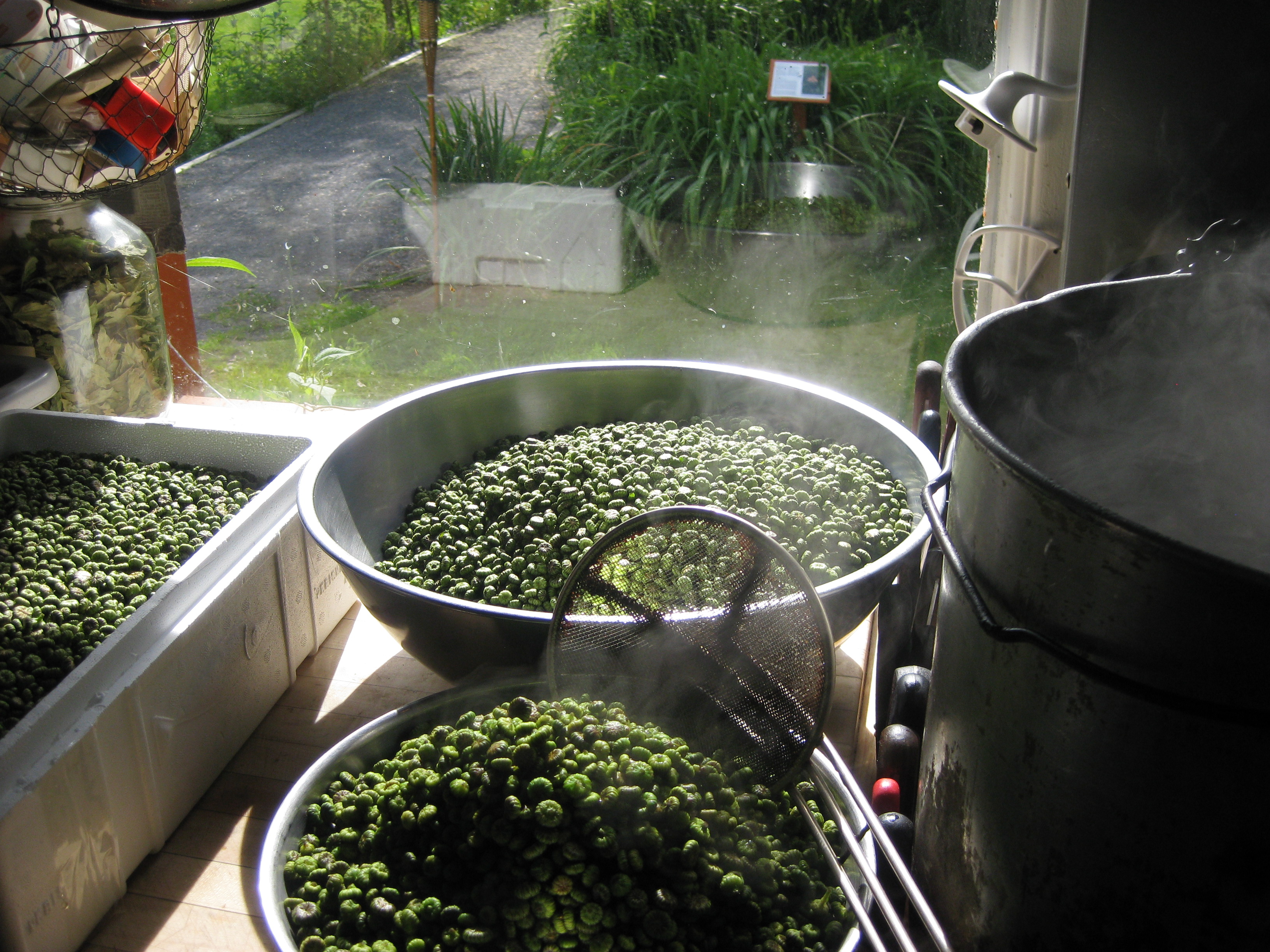 Pickling pounds of daisy buds
Pickling pounds of daisy buds
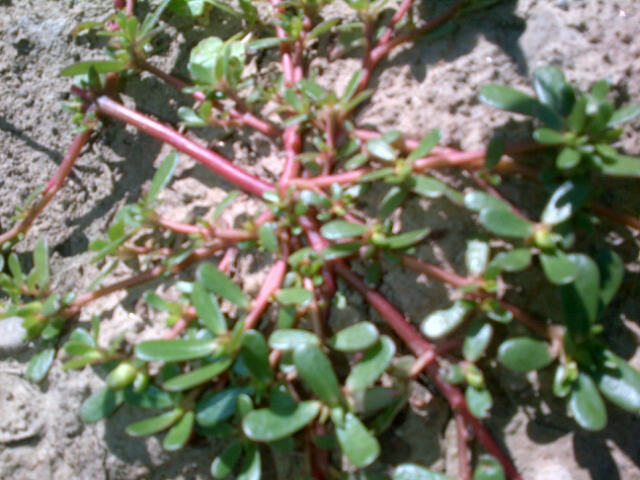 pourpier (purselane) - another hearty weed worth adding to your salad plate - lemony!
pourpier (purselane) - another hearty weed worth adding to your salad plate - lemony! 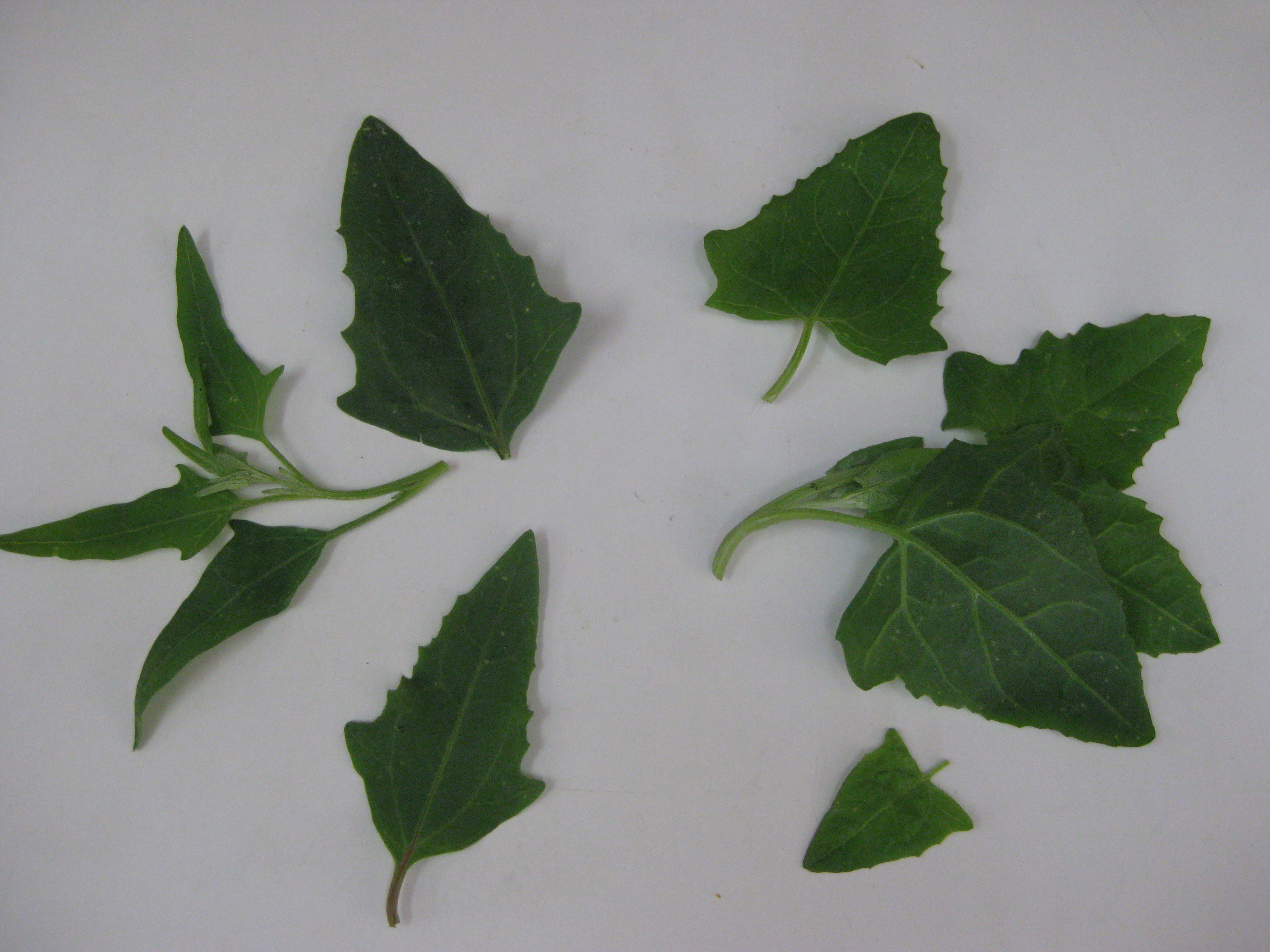 chougras vs arroche de mer (pigweed/lambs quarters vs. sea spinach)
chougras vs arroche de mer (pigweed/lambs quarters vs. sea spinach) 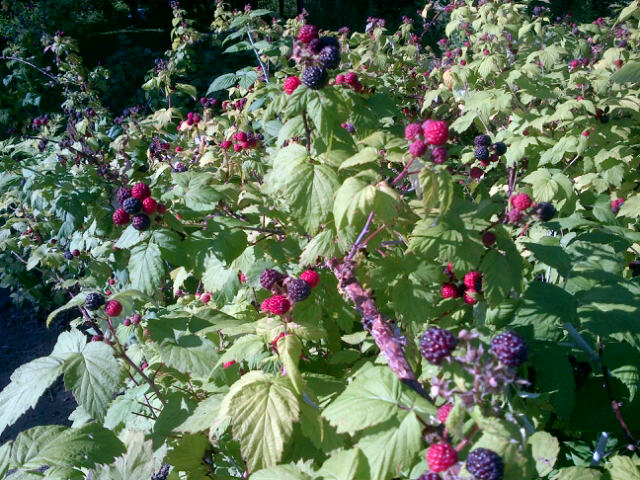 framboises noir (black raspberries)
framboises noir (black raspberries) vesce jargeau (tufted vetch)
vesce jargeau (tufted vetch)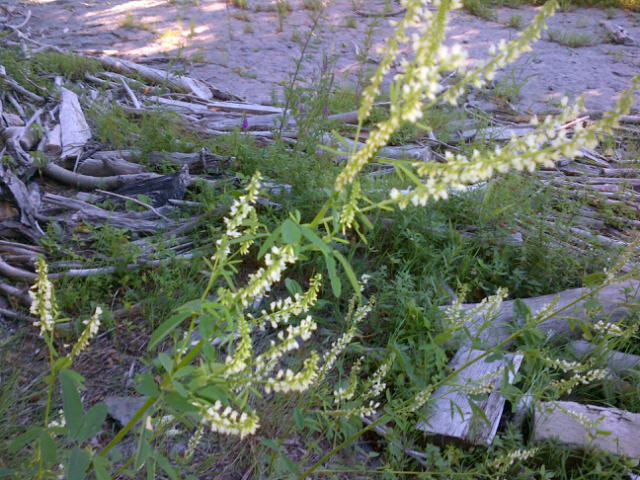 mélilot blanc (sweet clover flower)
mélilot blanc (sweet clover flower)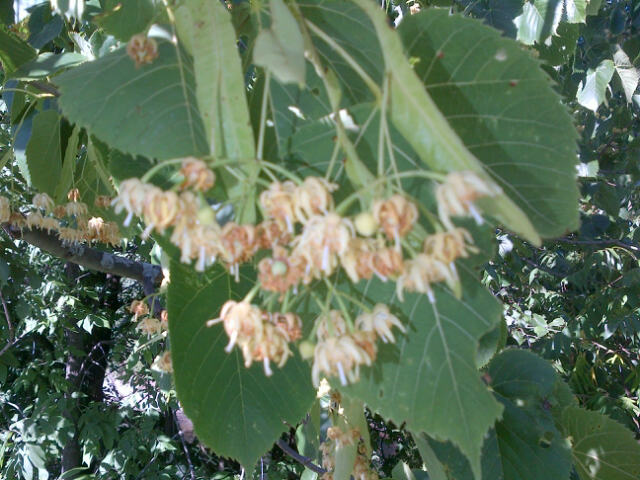 tilleuil (linden flower)
tilleuil (linden flower)
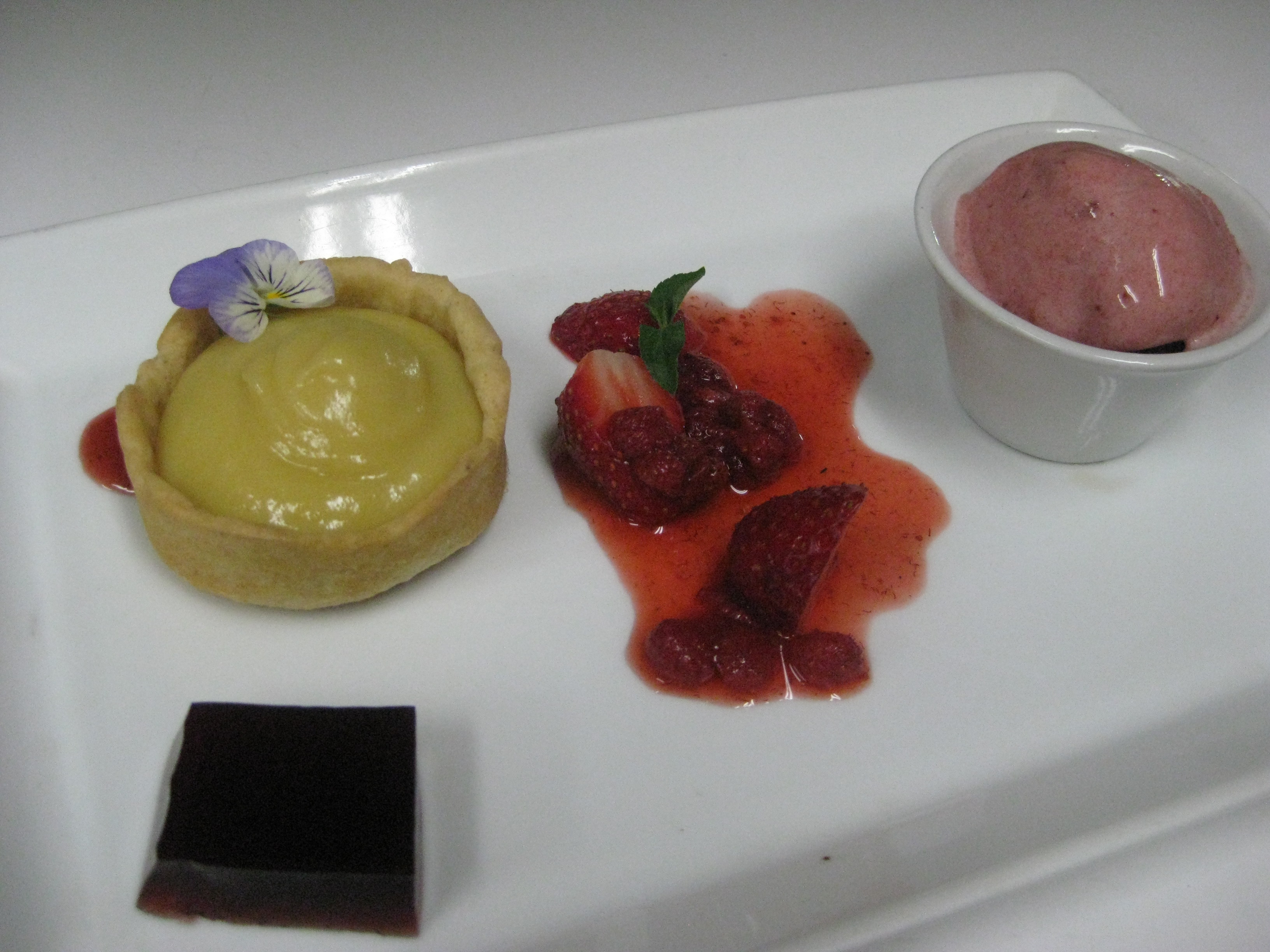 tartelette au fleurs de mélilot et creme de citron-sureau, gelée et sorbet aux fraises aux fleurs d'asclépiade
tartelette au fleurs de mélilot et creme de citron-sureau, gelée et sorbet aux fraises aux fleurs d'asclépiade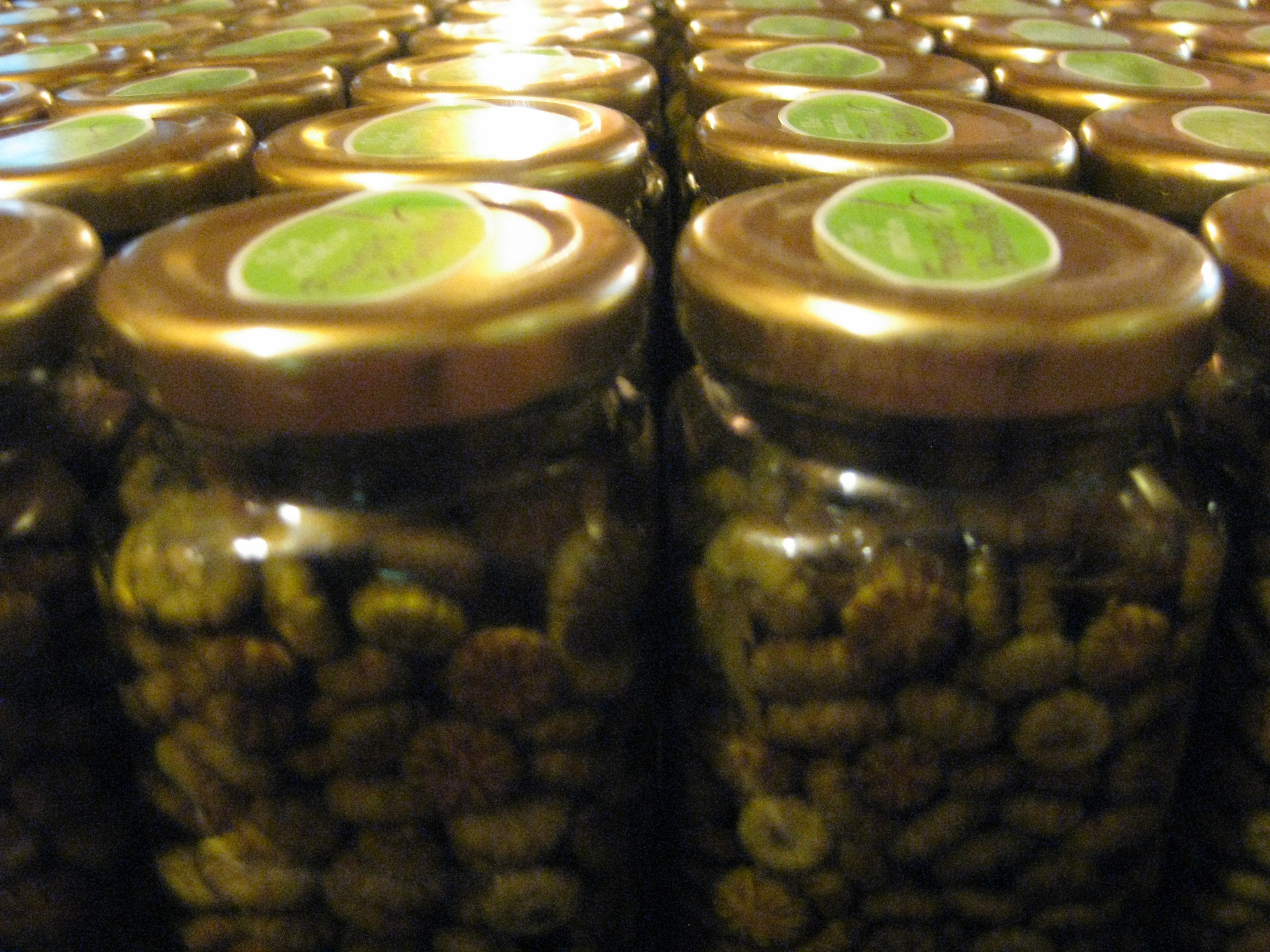 40+ cases of little bud packed jars, ouf
40+ cases of little bud packed jars, ouf
Milkweed flower deserves special mention, because it is so fragrant and particular, quite common and unknown. I love to pair it with wild berries or any fruit - in infusions, so jelly, granité, sorbet etc. What a pretty garnish too! It's hard to believe that they are the next stage in the plant's lifecycle after the milkweed brocoli, which is 100% vegetable. Important to be picked early, well washed and cooked through in lots of water, I typically blanch it for 5min before proceeding with a number of treatments, the most winner being tempura.
Linden is flowering now, and although beyond the leaves in spring, this hasn't been something we've taken the time to exploit; I figure now is the time - the heady accacia like aroma is seductive. Slightly fibrous, I can't imagine using them as is, more likely infused or dried and pulverized..
The sumac ripening shows promise, and our garden of cultivated things is overflowing, which means that the mushrooms are not far off. A few bolets and chanterelles have been spotted, but until this dry weather lets up, there won't be much going on. As we know very well, it can all change in a few days.. Better get as many marine greens in as possible and make sure we have our flowers for the tisane, get going going on the berries. Laitue de mer, check. Because soon enough François will have to let all the rest go and focus on the mushrooms. More madness to follow! 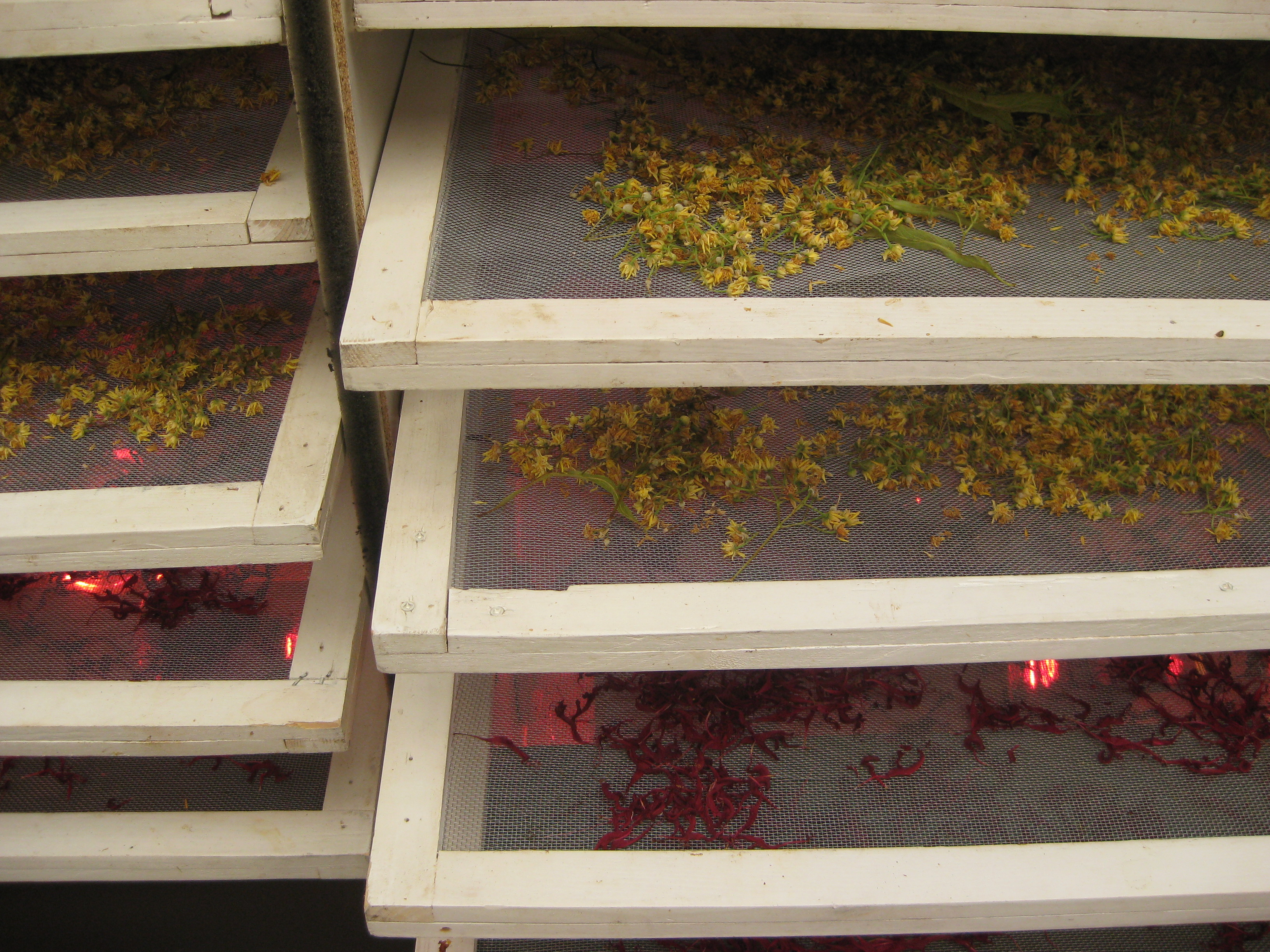 our dehyrdrator is working overtime
our dehyrdrator is working overtime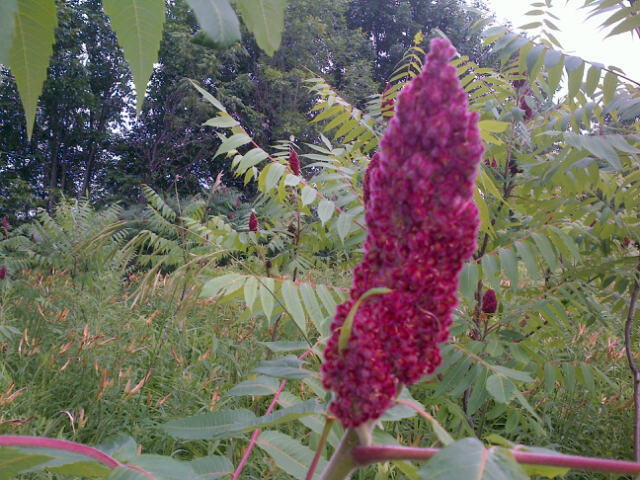 sumac, not quite ready but local lemonade is not far off
sumac, not quite ready but local lemonade is not far off
First morel

First 2012 morel from our backyard! The hunt is on..
Morels are such a tease - one here and there, never a whole bunch (except for up north in forest fire country perhaps).. At least this one is enough to serve two!
And then these showed up, jackpot! Du jamais vu!
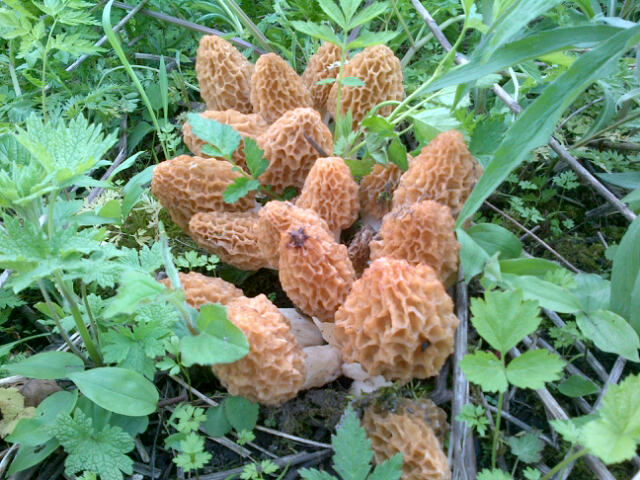 exceptional morel cluster like no one (we know) has ever seen
exceptional morel cluster like no one (we know) has ever seen
Spring is springing
Spring is sprouting, Fiddleheads not far off
 day lily sprouts, terrific gently wilted in butterAfter the false start a couple of weeks ago, it looks like spring is springing right on schedule, if not slightly early still. The day lily sprouts and young dandelion are at their best; the trout lily, spring beauty, garlic mustard leaf just beginning, live-forever breaking ground as well along with the nettles.. There is wild ginger for the picking, the crinkleroot not far off. We have the makings of a spring mesclun – fresh, bright flavours, sweet and peppery, green and crunchy! The first local greens are always so exciting, such a rush, and exactly what the body craves at this time of year.
day lily sprouts, terrific gently wilted in butterAfter the false start a couple of weeks ago, it looks like spring is springing right on schedule, if not slightly early still. The day lily sprouts and young dandelion are at their best; the trout lily, spring beauty, garlic mustard leaf just beginning, live-forever breaking ground as well along with the nettles.. There is wild ginger for the picking, the crinkleroot not far off. We have the makings of a spring mesclun – fresh, bright flavours, sweet and peppery, green and crunchy! The first local greens are always so exciting, such a rush, and exactly what the body craves at this time of year.
 dandelion
dandelion
 ramps
ramps
 Claytonie de Caroline
Claytonie de Caroline
 wild ginger
wild ginger
 tusselage (colt's foot)
tusselage (colt's foot) orpin (live forever/ stonecrop)
orpin (live forever/ stonecrop)
The fiddleheads are about to pop; François has been actively scouting all his patches. At least, the water is less of an obstacle this year; the thaw having come earlier, the rivers are lower. Within a week, we will be swimming in fiddlehead madness, François working around the clock picking, washing, weighing, sorting, coordinating it all. And our Jean Talon stall will be open all week once spring is really rolling. For another week or two, we’re open on the week ends (Fri-Sun).

Hurray! and Ouf, ‘attaché ta tuque’, another season kicks off and our crazy race/dance with nature ensues with all the annual surprises in store..
 first fiddlehead beauties - hard picking since still underground
first fiddlehead beauties - hard picking since still underground
My Phooey list
My Phooey List (ie. Baloney)
Food Myths, Trends, Snobbisms and Here-say I don’t believe in
After almost 20yrs of cooking professionally, and 40 plus years of eating mindfully with appetite, I can’t help but have my opinions when it comes to food. On what is important, yummy or not, when it is ok to break the rules.. When some culinary dictum or trend makes no sense to me, I feel like I’ve earned the right to lift my finger high in the air, or more politely say Phooey. (Where did that word come from I don't know, I don't even like it - Baloney is better, or grosse merde, you get my point.)
- Truffles – Honestly over-rated! Yes, an intriguing, rare ingredient that can give a ‘je ne sais quoi’ touch to a dish - if you can afford them as well as have the connections and luck to fall on a good batch of the real thing.. But really, there are so many more interesting mushrooms in our backyard. Same thing with Morels, another snobby mushroom that while delicious and elusive, seem to be revered less for their subtle flavour and typical concentration of dirt, more because the French value them and because they are expensive.
- Blanching rules (For vegetables – salt water & ice water bath) – Ideal in a restaurant kitchen setting, but so unnecessary. The salt does little but help taste-wise; cold tap water works fine for the cool down, if indeed you need to cool your veg down (not usually at home when they would go straight into the sauté pan or plate).
- Aldente – Both pasta and veg are best not over-cooked, but can we please forget about aldente as the ultimate cuisson? Pasta is best barely on this side of done, but most veg are better on the other side, closer to melting if we can forget about bright colour for a second. Same with rice and grains, even meat and fish. Sometimes sushi or carpaccio is perfect given the weather or cut of meat/fish at hand, but more often, both are more delectable and easily digested cooked at least to rare (medium-rare or even yes, medium). With wild meats, better to cook the hell out of them but oh so slowly with lots of TLC. Many wild veg need more than a kiss of heat too, lots of boiling water.
- Raw foods – Sorry but this is just stupid as a diet, to make it a rule not to ingest anything heated beyond 38C or whatever their magic number is. I do know that it's just outside the safety zone.. To try to develop flavour, they warm things up so that it’s teaming with bacteria, not hot enough to kill the precious enzymes (?) or the nasty bacteria either. No wonder so many first timers report sore stomachs. Yes, eat lots of fruit and veg and nuts (the only good thing about this diet), but for the most part, our body more efficiently derives energy and nutrients from cooked food. Cooking is one of our greatest evolutionary steps – why backtrack?
- Nutrition value boxes – the biggest joke of our times. Who needs them? They are misleading and besides the point. Unless you live off processed foods and things in boxes. We could avoid the headaches (and excessive cost for producers) by simply eating real food, or as Michael Pollan said, anything our grandmothers would recognize. We don’t see the need for labels on our carrots do we? As for condiments and treats, if they make up a minor part of our diet, who cares. All we should know beyond the ingredient list is where a foodstuff comes from for traceability, to know where to find further detailed info if necessary. We should be more concerned with all the sketchy imported stuff with false/incomplete labelling.
- Frozen vs Fresh – With sous-vide (vacuum pack), frozen is the new fresh. No longer is the lack of a freezer in your kitchen a sign of haute cuisine – au contraire. Better to have local, frozen produce year-round than readily available 3 week ‘fresh’ from abroad grown in uncertain conditions.. I put up my local peas, favas and corn for the year along with all the local wild greens, berries and veg. We now have local greenhouses for bonus crunch in winter, no pain.
- Gluten bad – Aside from the unfortunate suffering from Celiac disease, I have a hard time believing that Gluten is that bad for everyone all of a sudden. Find some other toxic chemical in our environment to blame. I refuse to change up good local wheat flour for a mix of industrial powders when I want to make good bread or pasta.
- Roux-based sauces (like Bechamel or Velouté)– So uncool for too many years, but they are tasty and definitely hit the spot in winter, especially when suffering from gluten backlash. It’s true that cornstarch slurry is handy and more versatile. A thin natural jus has its place too. But reducing a stock to the point of lip-sticking (when it seems to lose aromas) to build it up with a ton of butter never made much sense to me as an alternative.
- Pectin in jam – Foodies find it hip to look down on pectin for some reason.. Whatever the natural pectin in the fruit, using pectin in jam& jellies allows you to cook the mixture less and maintain more fruit flavour for less sugar/reduction for equivalent gel. I don't recommend using the recipes on a Certo box (more sugar and pectin than fruit), but if you enjoy fresh fruit taste and jelly texture, pectin persay is not to be sniffed at. And what if the added pectin is DIY pectin from early season apples?
- Pork belly – the darling of chefs, but I just think it’s too fatty. I love it to cook with, to make petit salé or bacon, a garnish maybe. But forget about it as a piece of protein on a plate, I’m not in.
- Over-manipulation – like the turned vegetables of yesteryear when half the vegetable went into the stockpot for the sake of cute football shapes, most of the molecular gastronmomy tricks and gimmicks of today similarly amount to a waste of time and diminished freshness/flavour. Presentation is not everything!
- Skimming – I just don’t waste my time skimming. If there is a big bulge of white froth atop my broth or sauce, I remove it, but I’m not standing next to the pot skimming off every little ‘impurity’. It’s just protein. Or flavourful fat. If I want a clear stock, I clarify; for sauces, it doesn’t make much of a difference if you’re controlling heat, then straining, degreasing and thickening/reducing at the end. Again, it’s about aesthetics, not taste.
- Misuse of Labels: Bio, Green, Local, Natural etc.. I hate that these words no longer mean anything due to dishonest/ overuse by chefs and food producers on their menus or in marketing.
-your cuisine is NOT Local/Regional if your garlic comes from China and your 'ative' Jerusalem artichokes come from California, if you order from big suppliers.
-your menu is NOT Seasonal if you have morels and asparagus on it in March and you live in Quebec unless you’re following someone else’s seasons
-your maple syrup is not Artisanal if it comes out of miles of tubing
-you should NEVER be allowed to use any of these words if you are Walmart or McDonalads!
- Nitrites – I’ve come to the conclusion that this scare is equally Phooey along the lines of MSG (caution yes, but not so bad), and that nitrites are simply key in charcuterie. History speaks. If the preservation comes from celery, it’s still nitrite btw. Sel nitrité in minute concentrations helps make your charcuterie safe and lends an agreeable taste; it really doesn’t taste the same without. Personally, I wouldn’t want to eat aged saucisson without it now. Which is why I don’t make that kind of saucisson, too touchy. But I did play around with other charcuterie without it for years, because that was what was considered noble. I only purchased charcuterie without nitrite too, it was important to me at the time. All to eventually say 'screw that' because it wasn't all that good. I now use it for liver and raw cured things and avoid it when I can. I’m talking <<1% here, much, much less than what you see in boucheries/supermarkets. I have no idea how they keep their stuff pink for so long, those doses might be scary. Yet everyone eats it! Hard to convince people to eat brown/green paté, I guess. I don't think we need to be especially afraid of nitrites, like we don't need to be afraid of MSG (as in glutamates) in natural form, hello umami! But we shouldn't be sprinkling the pure stuff all over either, or eating in Chinatown everynight, and we can always choose our charcuterie carefully made, ie. somewhere in between.
- Salt Bad – Just avoid processed foods and junk food, cook at home and you don’t need to be afraid of salt. Food and life would be excruciatingly boring without salt.
- Fat Bad – Fat is good for us. Our body needs it and knows how to deal with it if it is a fat it knows (ie olive oil, animal fat, not trans fat). Again, avoiding processed foods and you hardly have to worry, as long as you eat enough fruit and veg and exercise modestly of course. Julia Child and her dandruff boy come to mind – a funny anecdote I caught on Rewind CBC: he was a vegan, nutritionist or something who criticized her decadent cooking; meanwhile she couldn’t help but notice that he had major dandruff due to a lack of oils/animal fat in his diet.. I also think of the picture of Nigella Lawson vs. Miss Health Guru circulating on the web this year (cheap stuff I know, but still); who would you rather look like/be? http://chainmailbomb.com/?p=51
- Big ass portions – Too many giant portions all over.. Who needs that? And there is no way you can serve quality in big quantities without exorbitant costs to match. Restaurants who serve reasonable portions are quick to be criticized for being stingy or too fancy. Good food should be as accessible as possible. I just wish quality in smaller portions were the new normal.. Although we should probably all eat less, that’s not what I’m saying here - just better smaller dishes, to be able to choose and not waste without having to go to a tapas joint..
- Big ass steaks – Same story. It is official that we should all be eating less meat, only better pastured, natural meat, and in ways that allow restaurants and purveyors to use the whole beast while encouraging local small growers who can only sell whole beasts. So, no big ass steaks. And yes, more variety - more grain, veg based sides.
- Vitamins and Supplements – Except for in special cases, I don’t believe in taking vitamins – the fewer pills that pass my mouth the better. It’s so much easier (and more pleasant) to eat well, not to mention that our bodies assimilate vitamins and minerals better in the natural forms of fruits, vegetables and sunlight anyway.
- Eating late at night makes you fat – The way I feast late night makes this bogus to me.
- Gas vs Electric I need Gas at the restaurant, but at home, electric is fine (and unlike many of my collegues, I cook a lot at home). There is less pressure at home, and you figure out how to maximize and work with what you have. Electric is much less messy. If you want gas in your home, you need an expensive ventilation system and you will have to work harder at keeping your stove looking clean. I’ve seen too many rich catering clients complain about this - torn between having a top of the line commercial kitchen and one that is spic&span out of a design book. They don’t go together if you actually use the kitchen.
- Industrial Cleaning Products – Accepted in a restaurant environment but hardly necessary. Soap & water (with some elbow grease) go a long way. Baking soda, Vinegar.. Pull out the degreaser or Easy Off once a month instead of every night. It’s all about day to day maintenance and actual scrubbing, people have forgotten how to scrub. It would also help if sparkling, white or stainless weren't the epitome of 'clean' - difficult when green..
- Searing meat keeps the juices in and etc. 20 yrs after Harold McGee debunked this (among many traditional cooking myths), I still keep hearing chefs say this. Obviously food science is slow to trickle down to mainstream Quebec. Bottom line, we sear the meat for crust and taste, period. Sous-vide and low temperature cooking work marvels for meat texture, but we can’t seem to do without that savoury Maillard reaction from the searing effect. Which is why a simple pan roast remains the best way to cook meat at home..
- Other cooking myths scientifically debunked - TBC
Season finale
The race is over.
There is still a small trickle of hedgehogs and yellowfoots coming in from the Gaspesie (where it didn’t snow), and a few Tricolome up here, but the season is pretty much officially done. We just finished up our annual mushroom event, this year with 30 varieties on the menu! It was a wild success I would say, if not for a few too many last minute cancellations and a touch of staffing stress. All in all, so rewarding though and much fun was had. We’re exhausted.
 late cepe and agaric forestier
late cepe and agaric forestier
Off the menu, the customers loved the 'fromage frais aux morilles', the smoked polypore pickles, both of which we sold a whack on the side. The puffball lasagne was a favourite, and many were turned onto rabbit which was my coup de coeur. But as usual, it was the series of mushroom sweets that wowed the most - panna cotta, candies, cookies, cake and ice cream. It really is surprising what desserty aromas come naturally from mushrooms, especially in the bolete family.


For more photos, here is a slideshow of Mushroom Festival highlights:
A Slideshow.. https://picasaweb.google.com/114806860691793381895/EvenementChampignons2011LesJardinsSauvages
I think we can happily call it a year - and with more than a ton of wild Que mushrooms processed at the restaurant only, that’s enough mushroom for a while thank you. That’s not counting the tons that went to market, only what passed through my hands. A crazy amount of work.
All summer/fall, we wonder what the hell we’re doing amidst the insanity, and every November 1st or so, we pat ourselves on the back and bask in the glory for a few minutes, drink a bunch of mousseux and celebrate a feat accomplished, another year down, with the fresh sweet memories of all the estatic customers..
While it is slowing down at the Jean Talon Market too, we are still there, now only Thurs-Sun. And we remain open on the weekends at La Table for regular business with our equally enticing but more varied 5-7 course menu..
From now on though the winter, apart from Saturdays, we open following the reservations. Which is fine. I have a backlog of orders for products and plats-sousvides, catering gigs, the inventory to do and all other ménage that has been put off, not to mention much less staff from here on in.. Slow down or not, we can’t take it too easy, just a little. François is no longer picking mushrooms - besides some wild mustard greens foraged today, he is mostly busy cutting down trees and chopping wood these days.

But before we get into serious catch-up mode and production for the X-mas markets, we will be taking a day to roast a few pigs on our new spit machine and drink more wine. To close the season, we are hosting a big staff/family party for the market and restaurant team, and all the people who helped us with the house (which is coming along, although still a construction zone, sigh). Mechoui and Oysters and a buffet sans shrooms, Weehoo!.
Apart from that, I’m psyched to be back in my kitchen, cooking up anything and everything, not just mushrooms. Can’t wait to make squash soup, some sausage, experiment with some bread.. Rabbit terrine today.. Soon, it will be tourtiere time!
I love autumn and have my fingers crossed that this isn't the extent of our Indian summer. Dreaming maybe, but I'm ready for winter too. Bring it on, cuz that's when I really play.
Some of the things I learnt this June
Some of the things I learnt this June
Besides my stint at the University of Guelph earlier this month which was major brain-food, a lot of my June brainwaves came down to waking up to the mundane - those day to day revelatory details, occasionally mesmerizing when you’re dealing in nature and the restaurant business.
Mother Nature, she's just crazy
Living in the country for years now working with wild edibles, I am necessarily in touch with the weather and Mother Nature’s cycles and moods, but I am just starting to truly understand what a real adventure this is, and how much we are at her mercy. Be it global climate change, or that these phenomena now meet business in my world, the singularity of each season and plant is striking. Things don’t happen the same way anymore; the order is skewed, the plants are different depending on the weather and the ‘je ne sais quoi’, and you can’t help but feel like you’re stupid/learning all the time. François who is so intuitive, closely in tune with his vegetation and the moons, is burdened by memory/history - so off kilter in his own way; I on the other hand, am always trying to understand SOMETHING/ANYTHING concrete. Forget about it. You can’t plan for it.
So this year, spring came late and summer came early. For some spring greens, this was good; they were plush and allowed a slightly longer life before the foliage came in fully. There was excessive water for others, and practically speaking, the swollen river cut us off from habitual harvest zones. Then when summer hit, everything sprouted so fast, leaving us a small window for things like day lily sprouts or milkweed sprouts. A few morels.. It looks like it’s already time for elderflower and cattails! Why can’t they wait? I have 100lb of daisy buds to pickle. The day lily buds are peaking, meaning more bud pickling to follow. François picked his first local cepe yesterday, the chanterelles are buttons. In other parts of Quebec, many summer Oysters are ready, the wine caps (like Portobellos) are in full swing liking this cold spell. And then there are the marine greens coming in, which I am forever ecstatic about.. I cannot not be psyched about summer abundance, but wow all the waiting, then all at once, so much to process..
As mother nature keeps me on my toes, I remain thankful for the recurring rhymes and rhythms that comfort and exhilarate - starting with the fiddleheads and the ramps, and on to the day lily, elderflower, berries, sea spinach coming into season one after the other or any which way. Just reliving each arrival, weeks late or early, so familiar yet new, is something else. I know that every year when I am reacquainted with a certain wild plant in season, and I cook it up in a myriad of ways, I get to know it better and I get better at what I do. There are unexpected lightbulb moments, the kind that only come with time. Time observing, time tasting, time dancing.
Spring beauty really does taste like corn sprouts, I paired it with lobster and crinkleroot, and for the first time, served it alone with a little cold pressed canola. And there is no way to put it up; like most of the spring greens, it is a pretty sprout you enjoy for a week or two a year and that’s it, period. It didn’t take me long to love crinkleroot, but to figure out how to use both the root and the leaf to their max, how to put them up best took a few seasons. I’ve got it down; crinkleroot really sings with tomatoes and with potatoes. Sea spinach was an instant coup de Coeur (still my favourite), but sea parsley was just ok to me, not exciting until a couple of years ago; now I put it in everything. To finish a soup or salsa, it is a major component of my versatile ‘chimichurri’ and gremolata. It took me years to really appreciate Elderflower, Labrador tea or salsify sprouts, even certain mushrooms; I had to spend some time with them, one week a year wasn’t enough. Milkweed flower was a revelation last year in granites, syrups, etc; this year, something else will get my heart, new tricks added to my bag.
I have to say the most memorable thing about June (no matter who you talk to in the country) was the voracity of the mosquitos. It is a BAD year - very, very difficult for François, our pickers, anyone gardening, even our screened in customers..
Which brings me to another thing I learnt, a good reminder in life in general.. Never get too high on your horse about anything. Me, so eco-friendly and all about essential oils, I’ve reverted to Deet on bad days, sorry.
Fun and games at the University of Guelph…
Breaking out of one's bubble and hanging out with food scientists certainly fills the mind. So many questions answered, so many possibilities that opened up (even if most of them cost too much on a practical level for us). Basically, I got to pick some brains to help me be a better chef. Lucky me. Thanks to Foodday!
-I was reassured about my calculations regarding coumarin concentrations in sweetgrass and sweet clover (I am WELL under the worrying ppms, more relevant to the food additive/perfume industry who deal in straight chemicals, not plants).
-My hunch that the fiddlehead hoax is not about a toxin, but more likely a microbial issue was confirmed - so if well washed and cooked (from a non-contaminated source), no problem. Apparently, a soak in a 5% brine before hand (osmotic shock) would allow me to stick with a shortened cooking time, maximizing colour and texture (omitting salting the cooking water). Fiddleheads need salt anyway for taste.
-Although I’m well informed and have never had any problems, I got to the bottom of the nitty gritty when it comes to potential dangers with all of the types of products we make, ensuring me that I was adequately processing things (sometimes excessively actually), all to equip me against the MAPAQ who explain nothing. I’m talking high acid (pickles and vinaigrettes) or high sugar (jams and syrups) here, nothing our grandmothers didn’t make without a worry in the world. These tips will help me in determining which products to keep as we diminish the unmanageable number going. If I were to upscale certain products, I might modify procedures, choose new jars etc.
-Same with oils and drying, which I wanted to know more about in depth, given that the MAPAQ is wanting to crack down, but above all, I need to figure out if we can make it more efficient so that these could one day be profitable. Was there a way we could improve yield with better extraction, all while following safety guidelines.. How many jars would I have to make?? How do I break that heat and acid stable emulsion boletes like to make? Ok, this was not solved, but at least I know it’s more likely a lipid the cause and not a protein.
-They got me very curious about freeze-drying (we dry so many mushrooms and herbs and flowers), and I might get to try it out, but I doubt we can make this feasible since we don’t deal in quantities that justify such $$ technological intervention. Not to mention that nature inconveniently gives us unpredictable amounts impossible to schedule, usually small amounts here and there.
-I was introduced to alternate extraction methods (when it comes to mushrooms or herbs), again not necessarily accessible. But there were contacts offered, suggestions for teaming up with universities and flavour companies, avenues to explore. Even keeping with traditional methods, I found out how to improve my process with respect to pressure cooking and tools for efficiency (reasonably priced lab tools like a centrifuge or separatory funnel that would be useful to me).
It was overall extremely stimulating to sit down with scientists. They have so much insight and knowledge parallel to our world, simply inspiring. Hilarious too. Sometimes, I found myself explaining something so basic to a cook, but so foreign to a scientist not connected to his food or taste buds. One suggestion when talking about food safety that killed me: Add 25% alcohol to extract toxins and kill bacteria – hello, taste?? Denaturing said luxury food?? Good thing everything else he had to say reinforced the fact that he was very smart. He obviously operates in a different universe. He looks at plants in a way I don’t.
At GFTC, I met with another gang much more used to dealing with food and food professionals who aren’t so professional; they were so generous and cool. But wow is bacteria omnipresent in their minds; irradiation is normal procedure in their circles. I guess that is the most important aspect of their job, as scientists counselling the food industry. There is no doubt that someone needs to be guiding and regulating any Joe-Schmoe putting food on the market. But I also realized that no matter how edifying this experience was, how much I know about food processing, the bottom line is that all I want to do is cook fresh food to be eaten immediately! What the hell was I doing there? I could be bringing a product to market, all subsidized. No, I went to ask general questions. I looked like an idiot artist - I am obviously not a hardcore business person. I just want to be better at what I do all the time, whatever it is. All knowledge helps, right.
Doesn't anyone want to work in the country?
Back to the restaurant business, my never-ending search for good staff taught me a few new lessons. For one.. Waiters - can’t live with them; can’t live without them.
Good staff is scarce, especially in the country. I better treat the ones I have extra special, and hope for the best when it comes to the rest. Be it on the floor or in the kitchen, at the market or in the woods. Not many people are willing to work hard and take pride in the little things anymore.
Waiter wise, I’ve given up on the normal demands for a restaurant like ours: someone with restaurant experience in the gastronomy realm, bilingual, flexible, with a love of nature and wild edibles. Now, I’m looking for someone who is reasonably presentable and good with the public, into what we’re doing and willing to learn the rest. What kills me is that candidates with no experience, pertinent knowledge or obvious talent expect a starting salary superior to mine. I have no choice but to take what I can get here, accept that reality and make the most of it.
I keep telling myself this is one of those things I chose to accept with this country gig. You can’t have it all. Take the good with the bad. I would not be happier with a big, talented brigade in a big, high stress operation making more to spend more with less quality of life. To be able to beat to my own drum and do the food I want at Les Jardins Sauvages, I sometimes have to cover for waiters, serve, peel potatoes and do my own dishes. Answer the phone, clean, weed, fix things and be everywhere when I just want to be in the kitchen. I do like weeding more than waitressing though. I find it hard to have my head in the dining room and in the kitchen at the same time..
Such is life in St-Roch de l’Achigan. An abundance of wild edibles and good produce, a paradise for a cook, a challenge for a business. Always so much to learn, so many possibilities. One day, I might actually get around to the high tech improvements now on my radar or the solar cooker on my ‘to do list’, maybe even achieve my dream of being able to hole up in my kitchen.. If ever I nail enough solid employees.
I’m not holding my breath. But going into July, I feel wiser and ready to face the circus. With everything blooming and sprouting, I can only jump in and go with the flow.
For the record, I do still think I have the best job in the world.
Spring has finally sprung
Spring has finally sprung! Yay.
Believe it or not, two weeks ago, there were still patches of snow in the woods. Even a couple of days ago while François was scouting his first fiddleheads in swampland, there wasn’t much happening in the forest. But in no time, the telltale whiff of garlic and crinkleroot came wafting above that of fresh dirt as I strolled down the path to the kitchen. That day, I knew François was out there somewhere on his hands and knees if he wasn’t in his bootsuit chasing fiddleheads..
Venturing out back, and then to the neighbouring maple grove, sure enough, there were promising tufts of green everywhere.. Ramp leaves shooting up in gangs, alongside a smattering of baby trout lily, the odd cluster of fiddleheads, and striking (but inedible) trilles. Brushing aside the dead leaves around the ramps, there was lots more to be found – the first crinkleroot, wild ginger, more ramps, ulvulaire, spring beauty and more..
 trout lily
trout lily spring beauty
spring beauty
Right around the table champêtre, the orpin (live forever) is now popping up, the dandelion is in full force, still baby primo and actually edible this year (all the rain?), and there’s the miniature first daisy, my ‘coup de coeur’. Violet, bee balm and garlic mustard are showing signs of life, edible leaves soon, which means the linden, the flowers, and the next slideshow is not so far off. Spring was late, but I bet summer will not be. Even if it snowed in the Laurentians last night.
 ail des bois
ail des bois
 orpin; live forever
orpin; live forever
 dandelion
dandelion
In any case, within days, there will be a true bounty of spring greens, fixings for a meslun that explodes with flavour – providing that jolt of fresh, assertive green vitamin crunch our bodies crave after a long winter. A Green flavour boost that imported Romaine cannot deliver.
For the month of May, this forest is our pantry, and salad has to be on the menu. It is François’ favourite time of year because of the fiddlehead tradition, but also for the abundance of different edibles all growing together. Nothing beats the smell of the woods at this time of year either. It’s not all about mushrooms after all.
Of course, there is the squadron of female pickers who show up in spring, those patient enough to do the meticulous hand work that the sprouts and flowers demand. So different from the hardy gang of rough and tough beer swilling fiddlehead pickers. And trust me, this season, you have to be built strong to be doing fiddleheads, a girl my size would be swept away with the swollen river getting to the sweet spots. François skirts back and forth, the king of fiddleheads and part of the motley crew, but equally adept and at peace with the girls clipping and coddling roots and shoots, in there with his deceptively delicate man hands and feminine sensibility. It is in Spring that I see his most tender side, and his fiercest too, in terms of stamina. Out foraging in the rain, to and fro from the market, washing all those fiddleheads at the end of every long day...
It is busy yes, but smooth splendor for two weeks at least.. Picking in the same few spots. Silence apart from chirping birds. When the foliage comes in, all this dies and we move on. Then other things arrive in season, but dispersed, unpredictable, one thing at a time all over the place, so much prospecting, running around the province... A whole new kind of Hectic. Mushrooms are much more complicated still.
I wish I could seize a spring moment, capture it fully, remember it perfectly all year.. More than a picture or caption or singular thought, but that magical fresh feeling - the energy and excitement inhabiting everyone; the scents, the tastes, and hopes for the season; the invigorating comfort of communing with nature again, seeing and eating green again.
From one squat stance, reaching in all directions, with a few careful handfuls, you have the makings of a tableau or a lunch. With a half dozen plants, you have a combination of contrasting textures, notes of sweet to offset the pleasantly bitter, as well as a spectrum of fruity, floral, green and peppery aromas.. Ultimately a salad that is exciting for the palate, soul and body, loaded with iron, vitamins, minerals protein and antioxidants.. that tastes like spring!
 ulvulaire
ulvulaire
 ox-eye daisy
ox-eye daisy
Trout lily(cantaloupe), live-forever (snow peas), daisy (sweet licorice), Dandelion (bitter), Ulvulaire (walnut), crinkleroot leaves (mustard and horseradish), and tender Spring beauty (finesse)..
All you need is a good cold-pressed oil and some salt for absolute deliciousness. As a side, that’s fine, but these greens can definitely stand up to a punchy vinaigrette too. A touch of sweet to counter the bitter/astringent is often a good idea. I make a wild ‘chimichurri’ that works well, as does a wild berry vinaigrette, or aged balsamic or sherry vinegar based vinaigrette. I like to chop up some ramp leaves and any fresh herbs that are kicking around, especially dill, parsley and chives. Scallions are essential. Nut oil or nuts also make a good addition. Meat, meat drippings and fat all marry well, softening the wild greens, a marriage made in heaven. The smallest hit of umami in the form of bacon, smoked duck or cheese shavings will do the trick, taking healthy green salad to full-on gourmet entrée. Topped with shrimp or grilled meat, you have dinner.
Day lily sprouts can be thrown in too, but I like to treat them as a vegetable on their own– delicately floral and leek like, with a hint of truffle – delicious sliced thin and served raw in a light vinaigrette, or simply wilted in beurre montée. With fish, poultry, mushrooms..
 day lily shoots
day lily shoots
Growing in the same woodland, scattered among the spring greens are two precious roots, easily identified by their leaves at this time of year. Feeling down the stem, a pencil thin root is revealed, linked to a larger network underground, quite extensive depending on the age. We only snap off the first link and sprout, leaving the rest behind, which seems to stimulate the plant if anything. For the record, François does not rip out any plants by the roots. Across the board, we have a healthy supply every year in the same locations François has been tending to for 10-40 years.
First there’s François’ family favourite (and now mine too) - Crinkleroot.. With its hearty bite of mustard-meets-horseradish, it is nutty and peppery, very arugula like; both the greens and the roots are widely used in my kitchen.. In chopped salads, sandwiches, condiments and sauces, with tomatoes, cheese, seafood and steak.
 crinkleroot
crinkleroot
Then there is Wild Ginger- pungent like ginger-root but incredibly aromatic, floral and fresh smelling, exactly like the flavour of soap gum (Thrills), but cleaner, more natural tasting. Sounds gross maybe, an acquired taste not unlike coriander or saffron, but it is amazing to cook with in both savoury and sweet, when keeping it subtle. I use it fresh, I pickle it, I make it into mustard, paste, syrup and sugar – all handy ingredients to add wild ginger zing to preparations in different ways year-round. This week it’s in an Asian inspired vinaigrette for shrimp and fiddlehead salad; next week it will be with chocolate in dessert
 wild ginger
wild ginger
Of course, among the spring things, I cannot not mention fiddleheads more than in passing. A week into the season, we have a thousand pounds in our cooler, with thousands to come in still. We have a ton on the property, but it is a shitload of work. François was one of the first to put these on the market and takes great pride in it. I will be serving them in a myriad of ways fresh for weeks to come. Some will get put up, some pickled, most sold at the market.
I prefer them cooked and served hot with bacon or something meaty, but early season, I am happy to eat them in salads with some crunch. After washing them well, I blanch them for 5 min in lots of water and either reheat to serve warm or toss in vinaigrette.
So many people think fiddleheads are touchy or dangerous. The Cdn and Que governments say you should cook them for 15 minutes or 10-12 by steam due to some unidentified toxin. No one seems to know what this toxin is but affirm that it is water solvent. Yet other govt agencies have tested fiddleheads and not found any inherent toxin even raw. All cases of stomach upsets (very few) came from uncooked fiddleheads from unknown sources. (Probably polluted and improperly washed and cooked). We all agree that they should be cooked (they aren’t good raw anyway). To be safe, just wash well, use lots of water, and cook them through, no straight sauteeing. These guidelines seem excessive, but I suppose they are conservative to protect every idiot, scenario and fiddlehead out there. Personally, I believe 5 minutes in lots of water is sufficient with fresh fiddleheads from a reliable source. In previous years, I decided that with small batches when I wanted to conserve the most green and crunch, blanching twice for less total time optimized color, texture with respect to maximum cooking and water flushing. But now, I don’t bother. I don’t care about ‘aldente green’ like I used to. For flavour, more is better with fiddleheads.. But quand même, not 15 min!
 lugging in the mother load (fiddleheads)
lugging in the mother load (fiddleheads)
Greek Easter soup
My Greek Easter Soup with Lamb Lungs
Every time I get a lamb from Genevieve et Nathalie (L’Agno et le Lapin in St-Julienne), I break it down and use just about everything nose to tail style. The gigots get separated from the rack, the flanks go to belly/ bacon, the shoulder divided into roasting and braising muscles, the offal put aside for terrines or a mixed grill. The tongue and cheeks and heart are so small, barely more than a snack for the cooks. Bones and miscellaneous bits go into the stock. I even keep some of the fat for sausage or petit sale since this young lamb fat is mild tasting even buttery with the babies. Not crazy about the liver, I still manage to make a decent paté that is quite appreciated by lamb and liver lovers. But I never knew what to do with the lungs. So I vacuum packed and froze them. With a set of lungs per lamb, they have accumulated. Then this week, Genevieve gave me a bag of lungs that she had been collecting for a European customer who disappeared. She didn’t know what to do with them either.

Not particularly inspired by this organ, I now had no choice but to get creative and tackle a recipe or two. With the season starting, I need the freezer space and it just seemed wrong to throw fifteen pounds of protein into the trash.
I remember a fellow cook of Greek heritage telling me they made soup with it on Easter. Makes sense since they like to roast a whole lamb on a spit and historically let nothing go to waste, giving them something to snack on in the meantime.
With Easter around the corner, I looked it up – Mageiritsa; I was feeling gung ho. I liked the idea of onions, lemon and dill (always good), but didn’t want eggs in there. A quick internet search told me that there existed all kinds of lung dishes. In India and Pakistan, they made lung curries. There’s the Scottish haggis, Zuppa du Polmore in Italy, German sour lung soup, spicy Asian noodle dishes. In fact, most countries have a traditional lung recipe; apparently it is only in North America that we shun it, like most offal. Undoubtedly because the average family (or restaurant) here is far down on the food chain, numerous degrees of separation from the animal, nor living any real necessity of frugally making the most of every morsel.
When I think lamb, I think spices – cumin, fennel, mustard, red pepper.. Or herbs like thyme and rosemary, tangy condiments like preserved lemon and olives. This brainstorming had me salivating and eager to get started on my own Easter soup - a mix of the various recipes I had seen, a dash of my own style and a lot of what was in my fridge.
I had already put the lungs in a light brine to degorge (standard procedure for many variety meats), giving me a night to figure out what to do with them. I saw that I had to sous-vide the fresh ones first to rid them of the air so that they wouldn’t float. This turned them from a bright pinkish-red to purple. Hmm.


The next day, I threw them into some boiling water and simmered for 15 minutes to blanch and firm them up so that I could work them. Most of the recipes I had seen started this way, and it seemed right given the spongey texture (think sweetbreads or brains or testicles). Slicing the lobes open, I felt like I should remove the tough looking ducts and vessels, at least in large part. Then I cut them up and threw them into a sauté with onions and bacon fat (when in doubt, add bacon!). I added garlic and spices: thyme, bay, a hot pepper, some panch foran and a lemon wedge. I deglazed with some white wine, added some tomato and lamb stock and put it on a very slow simmer. Meanwhile, I put on some basmati rice to cook on the side with a clove, a bay leave, and black pepper, to add later. I had some crunchy Jerusalem artichoke from a sous-vide experiment that I diced up to mix in near the end. Sea parsley pesto kicking around - perfect. I was psyched.
Soon enough, the kitchen smelled heavenly, but the lung pieces didn’t seem to be changing in the cooking process. Maybe my heat was too low; I wanted them to become tender, but was fearing they would turn to shoe leather. After an hour, even two, I wasn’t thrilled with the texture or the taste of the lung, although the broth was incredible. I reasoned that I should be patient. There was no way I was giving up at this point.
Some time later, the texture had improved, going from tough and springy to tender with bite, like a properly cooked gizzard or heart. But the taste wasn’t going anywhere – it tasted like a washed out lamb heart, with a touch of liver. Discouraged, I started pumping up the mix- adding gremolata, salt, crinkleroot, a pinch of sugar, a touch of good red wine vinegar. The broth tasted kick ass, there was still hope. I sautéed swiss chard with garlic and threw that in with the rice and sunchokes. I was determined to make something good of this. Not to serve at the restaurant or sell, but at least for family and friends, something we would be happy to pull out of the freezer for a quick meal. By now, I was up to 20+ litres of the stuff, not to mention a huge pile of dishes. In the space of 12 hours, my enthusiasm had morphed into tempered frustration, relentless tampering, and a profound need to come out on top.
At 2am, I took it off the stove, finished with a tweak or two, some fresh herbs and called it a night. To my utter disappointment, it was just ok. I mean definitely edible, even surprising maybe for an average taster, but not what I had worked it up to be in my mind, with all the attention and love I invested. I don't remember ever having such a hard time making something delicious. Honestly. Humbling. But also, it makes me wonder about how far I want to push this whole nose to tail thing.
Ordering whole carcasses is better for the producer; it’s the way it should be, and of course, we have to make the most of every ingredient for minimum waste, economically and ethically. But there does seem to be a sensible limit to the nose to tail thing when you aren’t starving to death. I am quite sure that my customers would rather eat just about anything else even if I mastered the lung perfectly. I’ve had a hard enough time getting them to try tongue, cheeks and sweetbreads; even rabbit, not to mention all the wild stuff.
It is natural for me with all of the above ingredients because I love them myself and am confident that anybody reticent would be won over once they tasted. When it comes to lamb liver, kidneys and lung, I am not so sure. I don’t dig lamb organ meats. And in the end, I want to make food that makes people happy, I don’t need to challenge them across the board. I need to more than believe in what I am making and serving – on a hedonistic level.
That said, I have not thrown in the towel. I will treat my next lungs confit style. Gizzards shine this way, and I think the lung once blanched and cut up would work similarly. If confit treatment doesn’t work, then nothing will. And if I ditch the lung thereafter, then so be it. I tell myself that so many other chefs just order loins and chops and bones with no bother. The reality is that most of the time when you work a less noble cut or make use of the ‘scraps’, those transformed scraps end up costing the same as ready filet in labour cost. Which is fine. The tough cuts and most of the bits are better anyway. Although more expensive, ordering whole carcasses from a local producer, you get a fresher, better (and tracible) product. The crazy thing is that these farmers aren’t even charging enough. Because of the industrial system, people unfortunately think that cheap meat is normal.
I wish I could pay my lamb producer more than I do, which is already twice (or more) what most restaurants pay for their meat. But I then, I would have to charge my customers more, and I already don't charge what I should. As they struggle to make a living, I struggle to come into my cost buying their lamb, so I certainly want to make the most of it. Making something spectacular with the lungs would have been a real triumph and added value - for me, for them.
My Easter soup was a work of love, not a total success in my mind, but who knows. I will wait and see what my guinea pigs have to say.
Much to my surprise (and delight), it turns out that most of my peeps loved it, including my 'almost vegetarian' mother, my finnicky father, our well-travelled gourmand neighbour and my brutally honest boyfriend. Only my friend Elsa was not impressed. Like me, she could not get past the strange organ taste that no one else seemed to be detecting. Oh well, whatever. Lungs aren't for everyone. At least, my efforts were not for absolutely nothing. And now a dozen more people know what a lamb lung tastes like.
Canada Food day
At les Jardins Sauvages, we are celebrating Canada Food Day next Saturday, July 31st.
(Un message en français suit)
This is a national ‘holiday’ celebrating local food and good eating. On the same day, across the country, both chefs and home cooks (whole villages even) will be simultaneously feasting on menus composed of fresh and local products while raising a glass to our rich and diverse culinary landscape. Organized by Anita Stewart, acclaimed food writer and long time proponent of Canadian food. Read all about what's going on from coast to coast here..
http://cuisinecanadascene.com/2010/07/22/food-day-canada-2010/
Of course, my menu is always focused on local, artisanal and wild foods, but I love this initiative. We should be eating like this year round both for our health and happiness, as well as for the land. I like the idea of fostering national and regional culinary pride, and I am all for another reason to get together over good food and wine. At the height of the growing season, every meal is so easily a celebration!
Our food day menu can be viewed on the website http://jardinssauvages.com/index.php?nom=menu&res=m&m=31canada10en, or below.
Just so you know, juicy Saskatoon berries have shown up since I posted this menu, as well as a number of other surprises, mushrooms of all kinds too.. So my menu will be overloaded with seasonal bounty!
To reserve, please call 450-588-5125
Menu
July 31st, 2010
*Canada food day*
Nordic shrimp with wild ginger,
sea asparagus and sea rocket, fava beans,
bell pepper, oxalis and mint
Cauliflower soup with La Moutonnière cheese, sea parsley pesto and bee balm
Salad of wild greens with egg & duck ham (purselane, daisy, sea spinach, day lily), cherry tomatoes, pickled hen of the woods,
crinkleroot-chia seed dressing
Venison from the farm, hops-sarsaparilla pan sauce, wild mushrooms,
cattail flour polenta, cattail spear
Optional : Quebec cheese plate,
home made bread and chutney
(100g for two, 7.50$ supplement per person)
Wintergreen ice cream sandwich in a sweet clover meringue cookie,
wild blueberries and Labrador tea syrup
Tea, coffee or house tisane
Fair trade espresso, 4$ supplement
Bring your own wine
75.00$ including taxes, service extra
Your host and forager:
François Brouillard
Your chef: Nancy Hinton
*A Canada wide celebration of local food * www.foodday.ca
Salut!
Nous célébrons ‘Canada Food Day’ A la table des Jardins Sauvages Samedi prochain, le 31 Juillet, 2010.
Ce jour, à travers le Canada, comme à toutes les années depuis 2003, c’est la fête des produits du terroir. L'idée c'est de créer un menu mettant en valeur de beaux produits de chez nous, bien manger et célébrer la richesse culinaire Canadienne (et Québécoise) - ensemble les chefs dans les restaurants avec leurs clients, et les gens au BBQ à la maison. Cet événement est organisé par Anita Stewart, une grande doyenne de cuisine Canadienne. www.foodday.ca
C'est certain que mon menu est toujours basé sur les produits locaux, artisanales et sauvages, mais je trouve cela une belle initiative. A la hauteur de la saison, c’est si facile de manger frais, d’embarquer les gens et les sensibiliser à la façon la plus saine et joyeuse de se nourrir.. En plus, une fête de plus au tour des plaisirs de la table - pourquoi pas?
Vous pouvez visionner mon menu ici sur le site http://jardinssauvages.com/index.php?nom=menu&res=m&m=31canada10, ou en bas de la page.
Pour réserver, SVP appelez 450-588-5125
Cheers, Santé
Menu
31Juillet, 2010
*‘Canada Food Day’ *
Crevettes nordiques au gingembre sauvage, salicorne et caquillier de mer, gourganes, oxalis et menthe
Soupe au choufleur et fromage ‘La Moutonnière’, pesto de persil de mer, pétales de monarde
Salade de pousses sauvages, oeuf et jambon de canard (pourpier, marguerite, arroche, hémérocalle), tomates cerises et polypore fumé, vinaigrette carcajou-chia
Cerf du domaine, sauce houblon à la salsepareille, champignons sauvages, polenta à la farine de quenouille
Option : Assiette de fromages Québécois,
chutney et pain maison (100g pour deux personnes, supplément de 7.50$ par personne)
Sandwich de crème glacée au thé des bois, biscuits de meringue aux fleurs de mélilot,
bleuets sauvages, sirop de thé du Labrador
Thé, café ou tisane maison
Apportez votre vin
75.00$ taxes incluses, service en sus
Votre hôte et spécialiste de plantes sauvages: François Brouillard
Votre chef : Nancy Hinton
* Une fête nationale de produits du terroir www.foodday.com
Ramps
“I have wild garlic in my back yard. What do I do with it?”
“Where can I find ramps in Quebec?”
“How do I pick them?”
“Am I breaking the law?”
“Wow, you have ramps! Can we have some?”


So many ramp inquiries. Let me attack a few.
If you have ramps (ail des bois) in your backyard, I suggest you just cut off some of the leaves. You can chop them up and throw them into any salad, sandwich or dish. I have been using it everywhere in the past weeks: in shrimp or lobster salad, in green salad, on tomato-bocconcini salad, on pizza, in a cheese sandwich, in mashed potatoes or risotto, on warm buttered fiddleheads, in any soup or sauce..
If you want the bulbs, you just dig in with your fingers and feel around, pull gently and slice the bulb at the base. You want to leave the root strings in tact, if you want them to come back. The bulb is good used in the same ways as regular garlic, but it is more delicate, so it doesn't need to be cooked as much or even at all, if you like the fresh, pungent flavour. I know many people who love to eat them whole in their natural glory; they are popular pickled too. While the leaves are to be used as a fresh herb, I think the bulb is best sliced (as opposed to chopped) and just kissed by heat, thrown into the pan at the end, or onto a pasta or hot dish. If overcooked, it loses all its personality.
We mostly just use the leaves though, for several reasons. For one, it is their floral, mild (for garlic) flavour we prefer. And since it is illegal to exploit ramps commercially, we only use them at home, for family and friends. Actually, in Quebec, you aren't allowed to be caught with more than 50 bulbs. Harvesting ramps is banned in Quebec because the plant was disappearing from over-picking. Ramps are a long loved tradition in rural Quebec, and people were eating them to extinction. Since the demand was there, overzealous and ambitious pickers were pulling up the roots, not only for personal use, but to sell. Since it is a plant that is slow to grow and reproduce, it became threatened. If only it was harvested correctly, all would be fine, but unfortunately, there are always a few bad apples to spoil the fun. Meanwhile, in Ontario, New England and everywhere else, they are still regularly ripped out by the roots and sold at markets.
The last reason why François shaves off all the leaves in his patches on our property is to safeguard them from ramp loving thieves! Without the leaves, no one can know the precious plants are there. Plus we are assured of a bountiful return every year. Sure, we will snag a few bulbs over the course of the season, but always ever so carefully.
We need to make some ramp butter after all (usually coupled with the bite of crinkleroot that so happens to grow in unison with ramps) to pull out when a lobster comes our way, or for the odd grilled cheese sandwich. We will put up a batch for François’ family too, and that’s it. For us, ramps are one of the supremely seasonal things that we celebrate for a few weeks and then leave be.
At a catering event last week for a friend, because it is the height of spring, we used them liberally everywhere, and it was a hit. All guests were instructed to munch on a leaf upon entry to break the ice – everyone that night would smell like garlic and that was it. It would surface in every other dish amidst the 8 course meal, and they were drinking Champagne, fine Burgundy, Amarone, Sauterne etc. - no matter. It provided the main joke (and magic) of the evening.
Spring sandwich ramps, Tomme de Maréchal cheese, pickled pepper
ramps, Tomme de Maréchal cheese, pickled pepper
 tomato-crinkleroot shrimp with ramp leaves and trout lily
tomato-crinkleroot shrimp with ramp leaves and trout lily
Fiddleheads
As the fiddlehead season peaks, I am just making sure they are on your culinary radar. I wouldn't want you to miss out on such an essential part of spring fever, that first taste of local green crunch. They are now plentiful at the market. François is certainly doing brisk business.
Most people are enchanted, but it's obvious that the poor fern is still misunderstood by many. Some poeple are scared of food poisoning; others have been turned off due to prior poor taste experiences.
Both of these are the result of inadequate washing or cooking. The thing is, fiddleheads need to be washed and cooked in lots of salted water. Many people seem shocked by our cooking instructions that suggest a double blanch(for 2-3 min each), then refreshing them in an ice cold bath. This is our way of optimizing maximum cooking time and water flushing, while preserving texture and colour. Of course this isn't necessary - the key is lots of boiling water. If you boil them in a sufficient amount of water, you can use a shorter cooking time (say 5-6 minutes) instead of the 15 minutes the government agency reccomends. That edict is to scare people from eating them raw and to provide a safeguard against all that can go wrong: not cleaning, or cooking them in a small pot, or happening on a bad batch due to careless picking or from a polluted source.
Besides cooking, the key to taste quality is your source, andfreshness, of course. If you buy fiddleheads from the supermarket that have been bought on the cheap (from who knows where) and then sprayed and sprayed while they wilt away in the display case, then those government guidlines are for you. If you buy fresh fiddleheads from a good source, then our guidelines are fine.
I saw an article on the new Gazette food blog about fiddleheads. http://communities.canada.com/montrealgazette/blogs/shopchopeat/archive/2009/05/05/fiddleheads-now-i-understand-you.aspxThe author claimed she didn't really like fiddleheads but then admitted she had never blanched them before.. No wonder. She was also surprised by the sheet slipped into her bag with cooking instructions. (That's when I knew they were ours). She didn't appear to be completely turned around when it comes to fiddleheads, but she did say that these were the nicest she had come across. Why didn't she mention the vendor, I wonder? Maybe that's our marketing/PR problem. But still, I think that when food quality so depends on the source and/or the producer, all food journalists and shoppers should be taking note.
The more people talk about provenance and question quality, the more it becomes part of mainstream consumer practice, so that ultimately, local producers doing things right will be favoured over hackers, and sketchy food from big industry that is trucked in from afar or from some indeterminate provinence will be shunned. I don't want nutritional numbers on my labels, I want information on the source. At the fish store or at the meat counter, I want to know where a food item comes from; is it wild or farmed, by who and how, organic, natural or not. Ok, I'm ontoanother topic, stop. Back to fiddleheads, before their time is up:
An article on Fiddleheads I wrote for the Cuisine Canada blog: Fiddleheads leading the parade where they do a better job of presenting my work than me, pictures and all.
http://cuisinecanada.wordpress.com/
And more recipes from a post a couple of years back:
http://soupnancy.squarespace.com/whats-cooking-recipes/2008/5/17/fiddleheads.html

Spring snapshots
Spring has sprung. These first pictures are from last week. François worked hard to collect the first ten pounds of fiddleheads (seen below), out in his canoe, wearing his rubber boot - body suit. Just a few days later, it's an altogether different story, as the weather wants to jump to summer while skipping spring. The fiddleheads are now out en masse, and eager pickers are following, down on their knees, in full force, working hard on our property. By next week end, we will hopefully have enough to keep up with the market, where everyone is anxious for something local and green. The girls are picking greens and flowers too, so more exciting salad mixes are on the horizon. My kitchen smells green and floral again with the dog's tooth, day lily sprouts and ramp leaves - how invigorating. All the better as I move into fiddlehead processing mode and swifter business in general - the season is off to a roaring start!
I will add pictures and notes as the season progresses.
 first fiddleheads
first fiddleheads


 erythrone, ramps
erythrone, ramps claytonie de caroline
claytonie de caroline  violet
violet
 day lily sprouts
day lily sprouts  live-forever
live-forever  snow crab
snow crab  nordic shrimp candy
nordic shrimp candy
 snow crab: worth the work
snow crab: worth the work  guinea hen, quinoa, asparagus, day lily sprouts
guinea hen, quinoa, asparagus, day lily sprouts  shrimp 'sushi salad' with wild greens
shrimp 'sushi salad' with wild greens
Cuisine Canada Q&A
I am interviewed on the Cuisine Canada blog:
http://cuisinecanada.wordpress.com/2009/03/27/member-qa-nancy-hinton/
We play as the plants rest
Our winter wonderland
We play as the plants rest
In the same patch of woods we spend our summer season foraging, in winter we play. For miles in all directions out our back door, from our home and the restaurant, there is now nothing but snow covered trees and hillside, the trails we have carved out in sweat, the odd skidoo or dogsled trails in the openings, and lots of animal tracks everywhere. We are out there cross country skiing or snowshoeing, with not another soul in sight, be it in the maple plantation across the street (where we were picking greens in the Chef’s domain), or across and along the river and around the table champêtre on private property for hundreds of acres - several feet above the crinkleroot, the wild ginger and the mushrooms that keep us so busy all spring, summer and fall. With nothing to pick or put up, all there is to do is ski, snowshoe and maintain our trails. We can take a 2 minute, 30 minute or 1 hour trip to work by ski depending on which route we choose. Under the shining sun, or by moonlight, we are out there regularly taking advantage of the short slow season we have that is January, the month everyone else curses, our month of bliss. February brings Valentine’s day, our duck festival, not many days off, so now it is..
 Out back the table champêtre where the river is ferocious at spots
Out back the table champêtre where the river is ferocious at spots  our skating rink
our skating rink 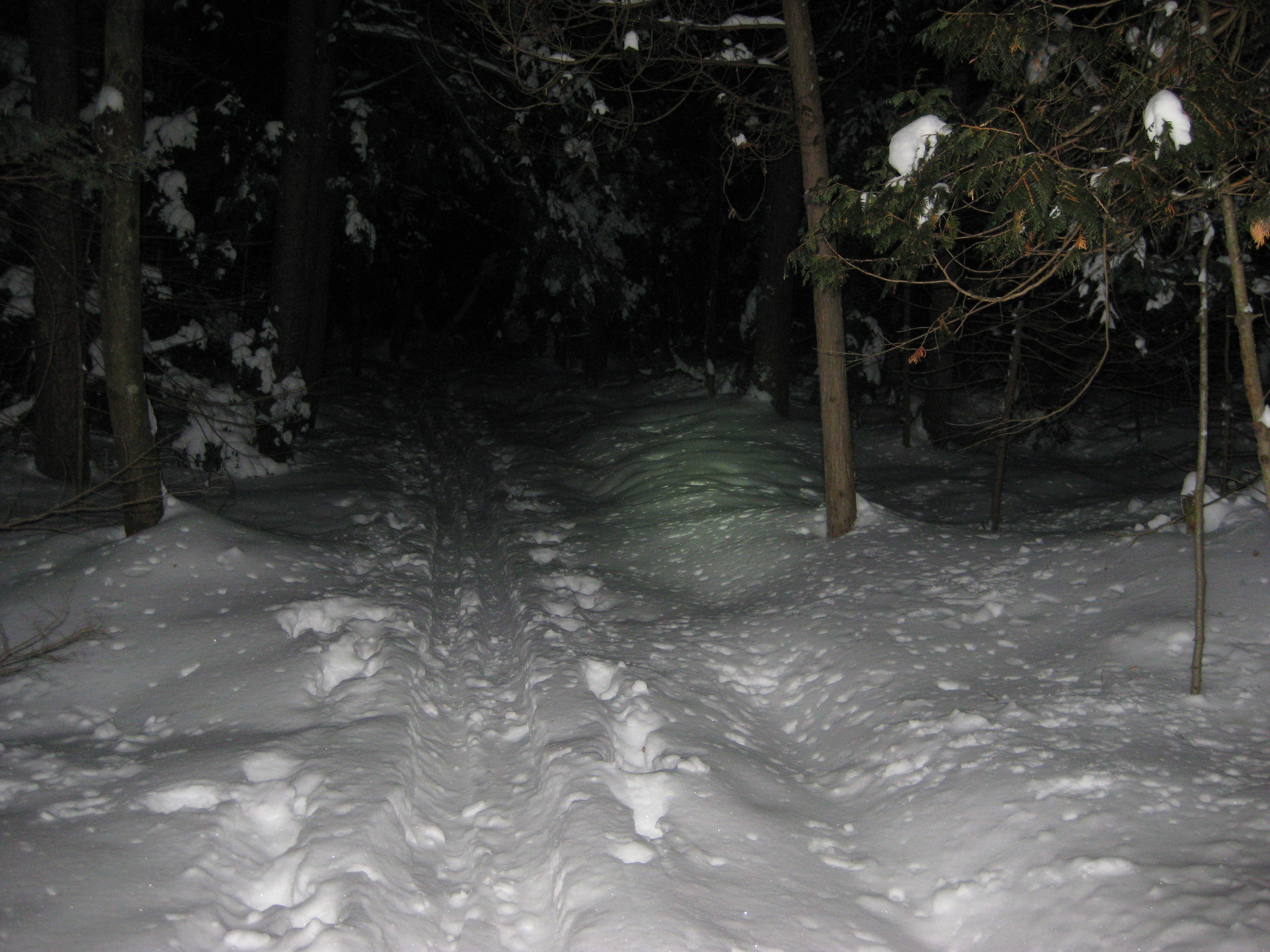 In the woods by night: this picture does not do justice
In the woods by night: this picture does not do justice 
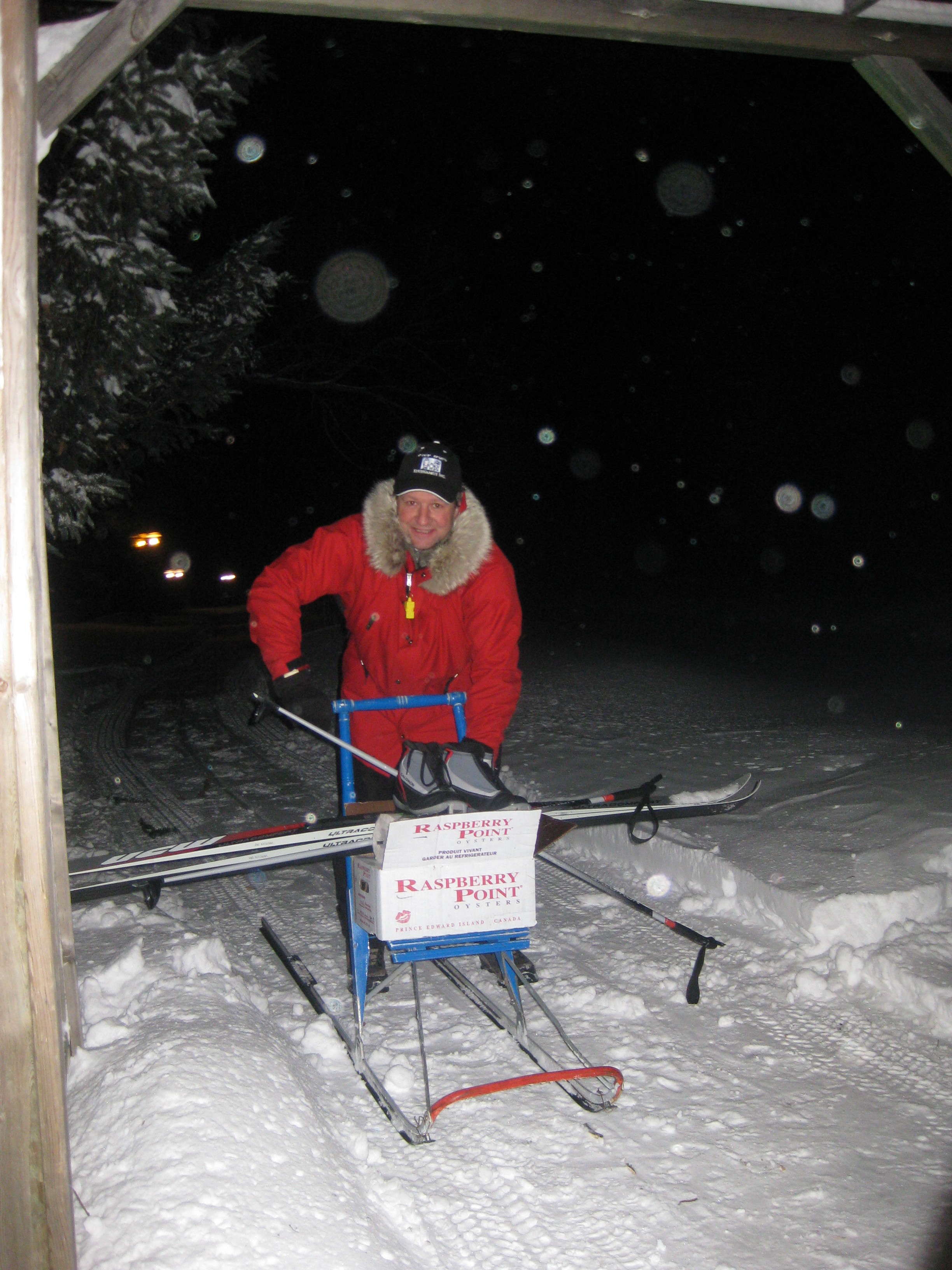 Bringing oysters home by luge
Bringing oysters home by luge
Winter wonderland yes, but it’s not a complete free for all. Oh no, there are strict rules that François has set out for this city girl: No skating on the river without him. No crossing the river except where he has carefully marked, he knows his river. No skiing off the trails after dark (headlight or not) without him. He says I’m dangerous because I’m not afraid enough. He thinks I’m a space cadet, that I’m not very ‘wood smart’(his version of ‘street smart’). It’s true that I can be incredibly unobservant in general in real life (ie. when not in the juice). Ask my girlfriends who have redecorated.
So it is; as we glide through the woods, while I’m completely at peace but caught up in my thoughts (or focusing on my ski performance and how fast I’m going), he is looking outward, in tune with nature, taking note of every shrub, tree and animal track, piecing together or re-enacting a wildlife drama from the tangle of paw prints and broken branches. He stops to show me the difference between the prints of a bobcat, fox, coyote, hare, deer and squirrel, the droppings too. Not unlike on a drive through the country or a trip out in the summer season, a trek through the woods with François des Bois is a string of stops and starts. You never know when he will stop dead in his tracks because he heard or saw or sniffed something. Unaware, I regularly ram into him from behind on my skis. It also reminds me of rollerblading with him on the Lachine Canal (once my version of nature) on one of our first dates. We could never pick up any speed because he kept stopping to marvel at or analyse some curious weed or flower along the way. At the time I thought it was cute. I like flowers and weeds, but I do like to go fast. In our trails amidst the deep snow, unlike on a rollerblade path, I have no choice but to follow suit. I’m not complaining really, more like chuckling, it ain’t so bad. Lots of fresh air and exercise, and now I know a fox trot from that of a lynx. I think.
All that time outside in a slow, Zen-like state, coasting, the adrenalin flowing at a steady stream, allows for good clear thinking too; I can’t help but brainstorm like crazy, so many menu ideas, so many moments of clarity, so much fun.. Just when I’m about to solve all the world’s problems and Eureka!, sure enough he breaks it all with a halt - time for another ‘nature capsule’ with François des Bois. After learning about another type of tree bark, bird species or critter hole, any prior moment of annoyance quickly evaporates and a good buzz regains hold of me as I calmly look up at the moon, basking in the pink light I now all of a sudden notice. Good thing he stopped me goddamnit. Wow. But then, instead of solving the world’s problems, I’m fixated on the abundance of fox and hare tracks he’s shown me, I’m a hunter and gatherer, I can’t help but wonder about a trap or two, c’mon, just one itty bitty hare for my pot.. I could ski out and collect dinner. Apparently squirrel is good too, but hard to skin, hmm.. Could I do it?
Same woods, a new world.. So much I never saw, never knew, never smelled, never felt. Even ‘us’ in ‘our woods’ with no pressure seems like a first. In my time out alone too (when I broke lightning speed I swear), I was bewitched - I felt watched over, but loose, carefree (like I used to feel blading down the middle of Sherbrooke St. at 2am), but now in a forest that is starting to feel like home.. The woods in winter are incredibly blank and tranquil in comparison to the mesmerizing cacophony of teeming life in summer. You can hear the trees, the wind, the snow, and occasional signs of the few brave souls still living there.. It’s almost more powerful, , a tangible source of raw energy, a sure grounding; a new host of ideas and a fresh perspective naturally spring forth..
I know I sound like a flake, but I really can’t believe how much I’m moved by nature season after season, especially now that I’m paying attention. With every season, nature’s kiss is as sweet, only different. This winter, I am happy to be there for it and open to it. It will only bring better things to my kitchen; maybe no hare, but who knows how wild I’ll get with all this fresh air coursing through my veins..
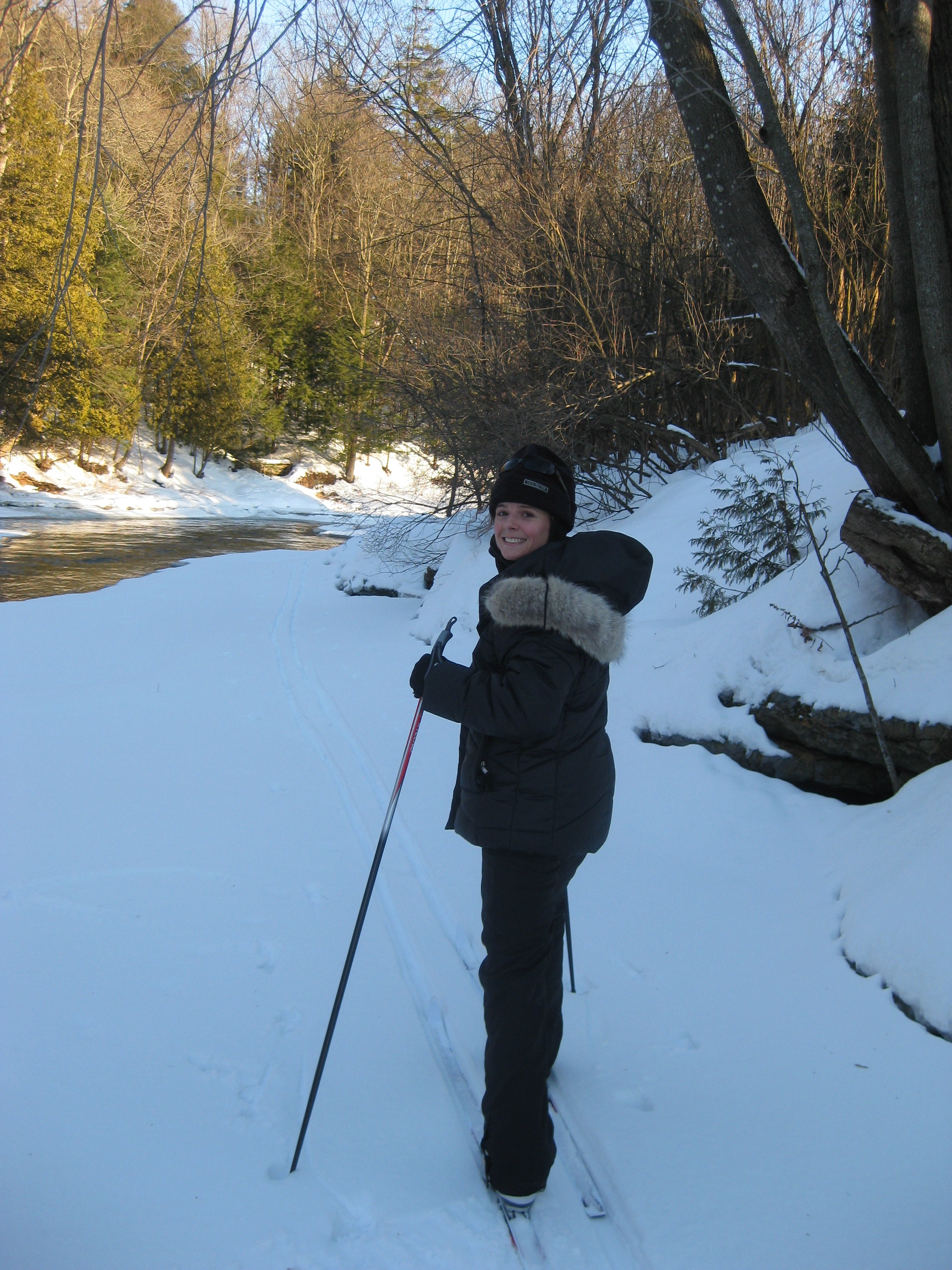
A New Year's toast for 2009
May all your joys be pure joys,
And all your pain champagne.
A New Year’s toast, from a card Ange gave me years ago.. I love it. Then again, I am partial to champagne. And joy. Joy and Champagne, Champagne and Joy, they go together.
On a more serious note is the following quote, a long lost one that I had been meaning to dig up since Thanksgiving.. still appropriate months later - timeless in fact. I figure that before we get to looking ahead, hoping and wishing, and making new year’s resolutions, or soon enough caught up in the business of life in 2009, we might as well hold on to a minute of holiday cheer to be thankful.
‘If the only prayer you ever say is Thank you, that will be enough’.
1260-1328 (Meister Johann Eckhart)*
It’s a good thing to remember all year don’t you think? A noble new year’s resolution of sorts on its own.
So yes, I start this year off feeling thankful. Even as the abundance of fresh and local ingredients has dwindled to nothing, I am thankful I still have so much to work with. Even as business slows, and the phone isn’t ringing off the wall, the reservation book so easy to navigate for a change, I feel thankful. Not only for days off like a normal person, but for all the food we put up, for the staff we’ve held on to, for all my friends and family, for the small, flexible nature of our business, for our simple life in the country, for nature’s beauty and bounty. Each season brings a different backdrop, a new playground and a breathtaking view; now with the river iced up and the trees snow laden, another spectrum of sights and smells is there to envelope and inspire us.
Even in the dead of winter, it seems easy here to keep plugging along, there's time to catch up and test out some tricks. Customers seem more joyous than ever. Cooking feels especially good in the winter somehow, so much more about hearth and restoration than ingredients, more primal, urgent and gratifying in the cold, with the hefty appetites, only the die-hards showing up - who knows, can't put my finger on it exactly.. I guess there are the slow braises, the welcome warmth of the stove and the steaming pots. I relish the alone time in the kitchen, the brainstorming, the puttsing -such luxury, and on the flipside, how clean my hands get doing my own dishes..
I just feel thankful for what we have, and that I can still do what I do. And I am optimistic that people will forever be looking for something fine to eat, for an occasional walk on the wild side.. If not, I’ve got a list of rainy day projects to attack, François has a lot of cross country skiing to do. No, I’m not worried about us, but I do worry, mainly about all the worrying knats polluting the atmosphere.
I despise all the naysayers, the rampant predictions I keep hearing about how many restaurants will bite the dust in 2009 - Shut up already. No doubt, some will fall, there are already too many restaurants in Montreal for the market, but these are hard-working people losing their shirts, shirts that are already worn thin. And there will be no bail out packages here. It makes me sad. But at the same time, I have faith in cooks and restaurant people in the long haul; we are a resilient type, we can deal with some rough times. And we generally don’t have a ton of stocks and bonds and savings to lose, just another job to find at worst. There is always honest work to be found, some niche to carve out for the determined ones that want it.
Nonetheless, I do hope that this economic doom and gloom doesn’t get the best of us as a whole. My tour of the annual ‘best of 2008’ and ‘top trends & predictions for 2009’ type foodie lists turned out to be less amusing and more depressing than usual, likely because the word ‘frugal’ came up far too often. Although I am hardly extravagant, I embrace ‘smart’ and ‘sensible’ and many ‘frugal’ type activities like home cooking, recycling and sustainable agriculture, I hate ‘frugal’. There is no fun in ‘frugal’. Certainly many of us, no matter how fortunate we are, will have to buckle down to some degree, at best less champagne or prime rib or shoes, at worst, real stress in providing basic needs .. Still, I wish the media would stop screaming wolf, telling us we should freeze and be frugal, that we should stop going out and eating good food and doing anything remotely frivolous or fun.
Pull out the crock pot and buy vegetables instead of TV dinners - yes, stop hanging out at the mall –yes.. But worry-worry, fret-fret, hibernate and forget about the lamb chop or the artisanal cheese, don’t dare smile in face of the monster around the corner –no way! Give me 100g of Tomme des Demoiselles – yes , a kg of Kraft Cheddar - no. Take me out to a fine restaurant once please, instead of 5 dinners at Cockadoodledoo Mega Chicken Chain, you know the one on every other corner. We can figure out what fat we can trim all by ourselves, and I know there is plenty there, but it’s largely not on the plate anyway. We spend a smaller percentage of our income on food than any country in the world. There are lots of ways to survive and even have a little fun, no need to panic.
We can buy less crap for one. Maybe we’ll even be forced to work less or for less, and consume less all around. I see that as a good thing, a chance to slow down, to reassess, to gain perspective, to value what we do have and can purchase, to appreciate a treat for a treat, to find joy in the simple things. We can always spend our money better, no matter how little we have. As the economy slows and businesses collapse, I am cheering for the good guys to survive - the small, unique, ingenious, authentic and earnest entrepreneurs, over the big, soulless, corporate purveyors of marketing imposed disposable junk. Quality over quantity. Less can be more. In times like this, when there is less than ever to go around, it seems even more important to vote with your dollar.
I’ve never been one to live in fear. I will always be a Babette, willing to spend my life’s savings on people, a good meal and a good time, for better or for worse. I might lose sleep over a lot of things in 2009, but I vow that the economy will not be one of them.
Whatever lies ahead for you, if and when you’re trimming the fat, don’t forget that fat makes us smile, fat keeps us warm in winter, that there is such a thing as good fat. A little fat goes along way, carries a lot of flavour and makes other fancy flourishes secondary.
Here’s to fat and champagne (Cava will do) and refusing to be afraid of the future,
Here’s to 2009!
*I need to double check this source; for some reason, I always thought it was Voltaire.. Regardless of the source, the message is a universal good one. I seem to remember it being tied to God and religion (or the lack thereof in the debate), which makes it even more meaningful and powerful, transcending all beliefs, a human crux.
The Green Pan and other holiday gift ideas
The Green Pan- An early X-mas gift from a friend put one of these babies in my hands. I would never have bought into the marketing at first sight, but how happy am I to have it in my kitchen now? Very. (Thanks Rach!)It’s a non-stick fry pan without the toxic properties at high temperatures, with a significantly lower carbon footprint in production and life. I’ve tried it with eggs, fish, duck, beef, veal, vegetables.. all with great results. At low heat, nice sweating and heat control/conductivity, and most importantly, at high heat, a good sear with little fat required, no muss no fuss, no sticking, easy to clean. I don’t know how it would stand up to commercial use, but for the home, there is no doubt that this is a winner. Buy one for the cook in your life (or for yourself). Available in most kitchen stores, I also saw it at Zone. www.green-pan.com
Green pans aside.. in order to reconcile holiday gift giving and my principles of sensible consumption, I put a little work into my shopping and think hard about my purchases in attempt to be as ethical, green as possible all without being too rigid, still keeping the fun alive. For me that means a lot of cooking (because that’s what I do), and besides, I think the best gifts are home cooked or hand-made, something hand crafted by a local artisan, or at least unique and meaningful in some way, preferably not mass-produced in China. Fortunately, quality and taste usually go hand in hand with the local or fair-trade, artisanal, and sustainable choices.. So here are my suggestions mainly along those lines..
In the home cooking category, you can always volunteer to host/make X-mas dinner - now there's the hugest gift of all, especially for a weary Mom (my Mom is exempt for the rest of her life). The next best bet is baking, making classic shelf stable sweets like cookies, that way you can get it out of the way the week before the madness. Apart from truffles, traditional shortbread and gingerbread, I once made fortune cookies (with food jokes inside), all kinds of trippy flavoured chocolates, spice mixes, spiced nuts, buttercrunch and brittle, hot sauce.. I always dig into my mason jar preserves for housewarming gifts, I religiously make a zillion game meat tourtières, some foie torchon for the usual suspects, as well as miscellaneous other treats. This year Iwill be making big batch of cassoulet (François' request), some soup of course, and who knows what else. Customers will be taking up most of my time this X-mas, so that might be it, we'll see ..
For those of you hitting the stoves:
See Canadian Living Christmas book or site, Gourmet magazine, Martha Stewart or Ricardo X-mas issues. Fine Cooking also has a great holiday baking guide out. There's also a wealth of ideas to inspire you online:
Bon Appetit’s Blog envy: A great holiday recipe roundup from popular blogs http://www.doriegreenspan.com/dorie_greenspan/2008/12/blog-envy-a-great-holiday-recipe-roundup.html
Canadian Living - 9 cookie recipes http://www.canadianliving.com/food/menus_and_collections/cookie_recipes__in_cookie_heaven.php
All kinds of holiday recipes and tips at Gourmet http://www.gourmet.com/recipes/holiday
Gingerbread cookies http://www.elise.com/recipes/archives/001633gingerbread_man_cookies.php
For those of you purchasing gifts in Montreal:
There’s Dix Mille Villages on Monkland (or on St-Denis) for hand-crafted, fair-trade gems such as pottery, wooden toys, X-mas ornaments and trinkets. http://www.tenthousandvillages.ca
La Maison Verte for the ideal housewarming gift, stocking stuffer or more: essential oil based gifts for her, ‘Les Chocolats de Sandra’ fair trade locally made chocolates, Café Rico coffee, and miscellaneous green items to turn someone on to the options out there, be it cleaning products, clothes or bamboo.. You can even shop online now. http://www.cooplamaisonverte.com/
Salon des Metiers d’Art at Place Bonaventure up until this week-end, for an overwhelming assortment of Quebec arts and crafts http://www.metiers-d-art.qc.ca/smaq/
The Jean Talon Market for gourmet edibles, many gift baskets to be had. Philippe de Vienne’s shop (Olives et Épices) is an unbeatabe place for foodie gifts. As is Quincaillerie Dante on the periphery.
Quebec made gourmet gift baskets online http://www.clindoeilgourmet.com/
A good bottle of wine is always nice, jamais de trop.. Many people won’t spend on a bottle for themselves, so I find this to be a nice treat. But splurging is not necessary, I tasted a fantastic local sparkling cider, perfect for the holidays and only 5% alcohol: Domaine de Minot, available at Marché des Saveurs. La Face Caché also has one out in a sharp package, I will be trying that one this weekend..
101 Produits Quebecois à découvrir http://www.editionsgoelette.com/site.php?detail=295
Or see my smart shopping page for tips on local food and arstisanal goods, online eco-guides.. http://soupnancy.squarespace.com/smart-shopping/
And More Shopping Online:
For Charity, A BRILLIANT idea:
Unicef Gifts of Magic https://www.shopunicef.ca/ec/Portal.aspx?CN=32C5B8993DA5&MN=B2039D949889&LN=EN
Order a sugar shack special at the Endless Banquet, buyraffle ticketsor donate to the UN food program.. http://endlessbanquet.blogspot.com/2008/12/menu-for-hope-5.html
Send a gift in support of the David Suzuki Foundation http://www.davidsuzuki.org/Donation_Centre/ecards.asp?tr=y&auid=4339335
Liquid Smudge - My mom introduced me to this ambient spray called ‘Liquid smudge’ that is revitalizing, peace and harmony inducing, the supposed cure for all ailments.. Sounds like a bunch of ‘n’importe quoi’, but it does smell amazing; it’s a mix of essential oils.. www.invocation.ca
In the Junky but fun category:
Lee Valley tools for miscellaneous gadgets for the men in your life (or for spice boxes and the original micro-plane if anyone you know doesn’t have one – no brainer!)
Gifts for Bacon lovers
http://www.seriouseats.com/2008/12/bacon-lovers-gifts-guide-holidays.html
Then there’s always BOOKS, BOOKS, BOOKS:
Books I’ve come across recently that I highly recommend:
The Devil’s Picnic, by Taras Grescoe (and Bottomfeeder, his latest)
In Defense of Food by Michael Pollan (not new, but I think everyone should read it and it’s an easy read)
Brain fuel, by Joe Schwarctz – fun for any curious mind
Cookbooks:
La Cuisine et le gout des épices, Ethneé et Philippe de Vienne
Anita Stewart’s Canada
(Only for cooks):
Under Pressure, Thomas Keller
Ma Gastronie, by Fernand Point republished
Canada’s top ten cookbooks http://www.thetelegram.com/index.cfm?sid=192802&sc=85
For Kids:
There’s a barnyard in my bedroom, David Suzuki – bringing nature into our urban landscape for perspective, also ‘The Salmon Forest’
Whining and Dining, by Emma Waverman and Eshon Mott – cooking for kids, with real food and enough flavour for adults
If there ever was an artisan to support.. There’s this Algonquin guy my mom met who writes books for kids (in English/French) and (English/Algonquin), beautiful and informative for a kid from here I would think (examples: ‘Where is the wolf?’, ‘Strange spring’)
Jean Denis Coté is his name, to order:
jdcote07ågmail.com, http://www.aaao.ca/cote.htm
The artist in me
The 'artist' in me
I’ve often heard writers talking about a story taking control of them, how once the plot is drawn or the characters outlined or even that they sit down to write, they feel no choice but to resign to that new life taking shape.. They might step in to guide, to shake things up, but mainly they are just along for the ride..
I always found this bizarre, even unbelievable. I know it takes incredible imagination to be a true author or storyteller, but to let go that much, and end up with a masterpiece?? Maybe I don’t understand how to let go that much, and so can’t completely relate.
However. I relate a teeny bit which is why I am writing this. I’m not talking about elevated artistic expression here, no novellas or grand works of art - only menus, nothing important, only a chef’s thoughts. In any case, I do feel like my ‘artistic’ sense is taking up more space lately.
I’ve always considered myself more of a logical, order-phyllic (academic, scientist) type, but with a definite artistic side in my desire to feel unbridled, my need for creativity. I was always creative really, but in a very structured way, and in a very personal way; it’s not like anyone was ever watching. I would draw, I would sing (bad idea), I would write, but I had to work at it. Even as a doodling kid, I worked hard. I stayed up late after my homework writing songs, poetry, and drawing, until I discovered sports and regular high school pursuits (sex, drugs rock and roll, more or less) and got side tracked. Meanwhile, I found math and science which was seductively much more straight forward than all the artsy stuff, and being coaxed by the establishment, I fell into step and followed that path. That’s what the smart people should be doing (the thinking of the time), that’s where you got the pats on the back… It was easy for a while; little did I know that it would lead me on a big detour. Soon enough, I would find my way back in touch with my artistic soul in cooking, although it took ten years or so, and then some.
At first, I took on cooking like any other class or challenge, very studiously, like an academic, but I quickly learnt that my senses had to be engaged; this was different, invigorating, overwhelming. As a young cook, I read so much, I cooked so much, I slaved and I dreamt so much, and years down the road, I think it eventually all came together. I was brainstorming all the time, reading, jotting things down in a journal.. I could always come up with ideas or new menus on a daily basis, or write something when I sat down to do so, but it’s because I already had a handbag of inspirational material to work with from my relentless collection of stimuli, an arsenal of ideas just waiting to be hashed out. Maybe I was moving too fast for the artist in me, or perhaps learning what I had to in order to be able to make the most of it.
Nowadays, I am that same person, but I have to say I fly by the seat of my pants more, I am less influenced by what I see and read, I go with the flow more, I take more risks. Or maybe I take fewer in a way, because I’m less adventurous (in terms of attacking new trends or technologies for the sake of it), I don’t know. It comes down to the fact that I’m less rational, I'm doing whatever I feel like in the here and now, be it because of the forager’s finds, because of a day-dream, or because of something great I tasted in a casse-croute or in an old fashioned French restaurant that struck a chord. I’ll riff on a quirky recipe I saw in some sketchy cookbook or even in Chatelaine, or it might have been a molecular gastronomy acolyte that lit a spark. That’s nothing new, all chefs can’t help but be affected by what’s going on around them, there's definite osmosis going on all the time. But there is less going on around me than ever before and I’m paying attention less and less; my moves are more spontaneous, not calculated. The other night it was after watching a foreign film (not food related at all) that my jostled mind started spewing out ideas. I honestly don’t know what I will be cooking next. That’s the thing. I’m acting more like an artist than ever.
I guess it’s part experience, growing up, and being comfortable in one’s own skin, then part my environment being conducive to letting the artist in me out..
But not quite.
I am short staffed right now, I know my budget, I know my constraints, but I push those limits all the time. I never want to do the same thing twice; I’m always doing new things when it would be more sensible to go with the tried and true. I keep complicating my menus even when I don’t want to, in that I don’t see it as necessary or even adherent to the style I want for myself, beyond it not making business sense. I absolutely hate it if I have to produce a menu more than a week in advance, because I’ve found that when I do that, when the time comes, I don’t feel like cooking whatever I had planned weeks before - no, now I feel like cooking something else and it feels wrong. When I sit down to write my menu for the week, I have ideas swirling around in my head, maybe even some written down (on my ‘to try’ list), but I honestly don’t know what it will end up as before I’m done. And then, I’m like, what the hell, that’s so much MEP! So then, I might do a more practical rewrite, take off homemade pasta, inject Israeli couscous, take off sausage, inject rillettes etc., but more often than not, I don’t. I guess I kind of like the challenge, the ride.
Intellectually, I feel like my style is simple, but I can’t help but notice that although I am not using much fussy technique or big frills, practically speaking, my menus are infallibly intricate: I keep adding subtle layers of flavour, background ingredients, new or old fashioned multi-step recipes in spite of myself. Several times this summer, I cancelled an engagement or a day trip away from the kitchen to stick around in order to reduce my stress and space out my workload, but then found myself adding a few labour intensive components to my menu, or deciding it was all of a sudden imperative that I defrost the freezer, do inventory or do some tests, because now there was the possibility of swinging it. One step forward, two steps backward; my to-do list for the day has to have a few too many items on it, it seems.
The manager/partner side of me is critical of all this. I know that professional cooking and the restaurant business is very little about art, more about organization, manual labour, management and accounting, even common sense. Nancy , why not reproduce some of your more successful, you-can-do-in-your-sleep dishes instead of inventing new ones each week? Nancy , why make your crackers or bread or pasta when you can buy them? Maybe then, you could take the time to clean the fan, and anyway, is it really necessary to degrease the fan twice a week? Nancy , why not cut down on the complexity of each dish, either in the number of steps, or at least in the number of à la minute motions in dressing (labour) for each dish, then you might not have to worry so much about your staff? Nancy , why not cut down on the number of ingredients period? Nancy , do you really need all those expensive top end ingredients when your mission is the wild stuff?
But I feel that no and yes, I am who I am, I cook how I cook, I follow my inclinations, and I can’t (don’t want to) do otherwise. I need to be true to that passion, I need to be evolving. Which is why I am here, that is, still bitten, and in the woods at Les Jardins Sauvages. I have been doing it my way for a while (even with Anne, I worked this way, never really cooking anything I didn’t want to, always with recipes/menus/compositions that came from the heart, from some ingredient I was enamoured with, from some technique I wanted to explore, from some old dish that spoke to me that I wanted to reinvent – that she agreed with, of course). And at the Tavern before, I was free creatively too, only limited by my naiveté and by the somewhat conservative customers. Of course in both places, I had to keep the clientele, establishment and purpose of the restaurant in mind, but in each moment in time, I was fully committed to that particular job while continually pushing my limits. Now, I have another set of constraints, but I have more of an open template that I’ve been slowly moulding into my own (based on François’ reality). All to say, I could not be cooking at some mega star hotel in Dubai or any of those top jobs I was once offered with the freedom I have here and with ingredients I believe in, like I have here. Years in the making, and thanks to the present circumstances, without me realizing it, the artist in me has been unleashed.
In a setting where I finish my own sauces and sear my own meats, with a set chef’s menu, I can change things on a whim, I can do as I like, and ultimately, I know that the food is better for it. It’s so personal, so cooked with love, so true, so in the moment, not to mention the underlying quality of the ingredients from local artisans I love and those foraged by my guy and his team.
What a great way to cook. But I know it’s not the most profitable way, or the easiest way. The day to day logistics of pulling this off in a small country kitchen, amidst fluctuating business and a shortage of resources, often means a lot of stress for everyone involved. An artist maybe, but I’m no peace-and-love, piece-of-cake to work with, more like a whirlwind of seriousness and pressure on the job. But at the end of the day, when everyone is happy, the customers wooed and satiated, the staff paid and proud, the resulting sense of accomplishment and gratifying exhaustion makes it all seem worth it. To me anyway. Until the next day when I’m in the juice again.. but don’t have time to think, just do-do-do until the curtain closes and that rush comes again. Maybe François who pays the bills and runs around like a chicken with his head cut off trying to keep my larder stocked and check off my many lists, has more than the occasional second thought. Poor François, he courted a chef who seemed like she had her wits about her, and he ended up with an unpredictable artist. Especially that he is one of sorts too, it all makes for a colourful life, both in business and outside.
Yes, at times it indeed seems like a crazy life, and not much of one outside the restaurant, which would no doubt be made simpler without any artist in the equation. But then would it all be worth it? The endless hours sweating it out, with so little stability or security, so much peddling and damage control, so few days off.. Then again, there is so much excitement and action, and so much beauty, so much gratification, so many good people, so much good food and wine, so many laughs, so many more highs than lows..
No, I wouldn’t have it any other way; that’s me, that’s us, that’s this business. And besides, it just might be that ‘la vie d’artiste’ ‘malgré tout’, is the best elixir ‘dans un monde de fou’.

